

Kedarnath Trek
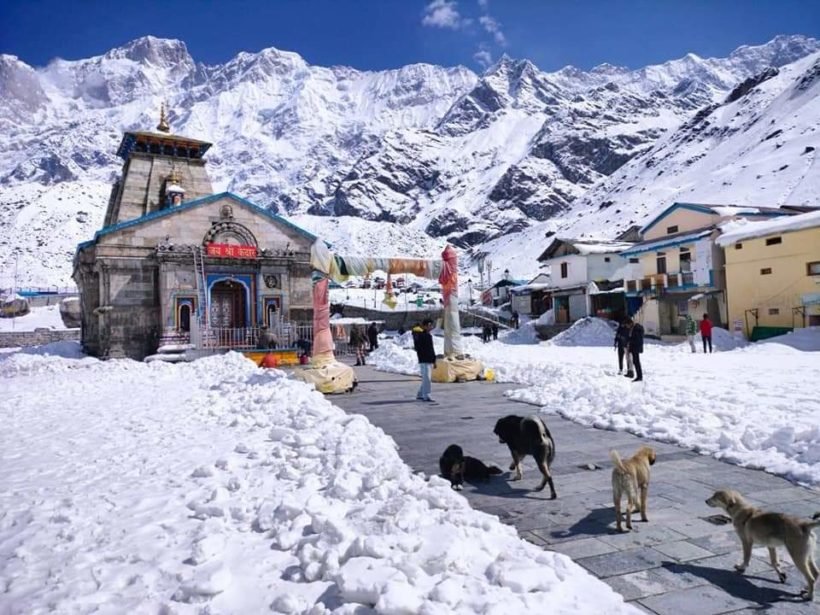
Description
Reviews (3), things to take, available dates, include / exclude, kedarnath temple trek the india’s most popular destination in uttarakhand himalayas, complete information 2024 yatra trek .
Kedarnath Trek is a remote but highly celebrated pilgrimage site of the famous ‘Char Dham’ in the Rudraprayag district of Uttarakhand. At an astounding location of 3583m Kedarnath lies near Chorabari Glacier, the birthplace of Mandakini River and is surrounded by various snow-capped peaks. The famous Kedarnath Mountain also lies in the vicinity to the site of Kedarnath. The Hindu pilgrimage site is visited every year by thousands of devotees from all around India.
Many Peoples thinks the Kedarnath Trek and Kedarkantha Trek are the same but these both are different Treks and also located in different location. Kedarnath Trek located in Rudraprayag district and Kedarkantha Trek located in Uttarakashi district in Uttarkhand.
In local dialect ‘Kedarnath’ means ‘lord of fields’; according to a local legend it is believed that Lord shiva hid in an assumption of a bull trying to avoid the Pandavas. Bhima, one of the brothers from Pandavas, recognized lord Shiva and tried to capture the bull through its tail and hind legs. Just before Bhima could fully grasp the bull, it disappeared into the ground only to later appear in many forms across the region. The hump of this bull appeared in Kedarnath where it is believed that Pandavas built the temple and later worshipped it.
Kedarnath should not be mistaken as any easy trek, hikers not accustomed to long journeys and altitudes might face some problems, hence it is generally advisable that trekkers practice a reasonable amount of physical fitness.
Kedarnath Temple is a revered Hindu shrine located in the Rudraprayag district of Uttarakhand, India. Here are some of the highlights of the temple:
- Ancient Temple: Kedarnath Temple is one of the oldest temples in India, believed to have been built by the Pandavas during the Mahabharata era.
- Dedicated to Lord Shiva: The temple is dedicated to Lord Shiva, one of the most important deities in Hinduism.
- High Altitude: The temple is located at an altitude of 3,583 meters (11,755 feet) above sea level, making it one of the highest temples in India.
- Magnificent Architecture: The temple’s architecture is a beautiful blend of ancient and modern styles, featuring intricate carvings and a unique design.
- Unique Rituals: The temple has several unique rituals, including the Abhishekam ceremony, in which the idol of Lord Shiva is bathed with water, milk, and other offerings.
- Char Dham Yatra: Kedarnath Temple is one of the four shrines that make up the Char Dham Yatra, a pilgrimage tour that is considered one of the most sacred in Hinduism.
- Importance in Hindu Mythology: According to Hindu mythology, Kedarnath is one of the twelve Jyotirlingas, which are considered to be the most sacred abodes of Lord Shiva. It is also believed to be the place where Lord Shiva absolved Pandavas of the sin of killing their own brothers during the Mahabharata war.
Overall, Kedarnath Temple is a significant pilgrimage destination for devotees of Lord Shiva and Hinduism, and a beautiful site for tourists to visit and admire the ancient architecture and natural beauty of the surrounding region.
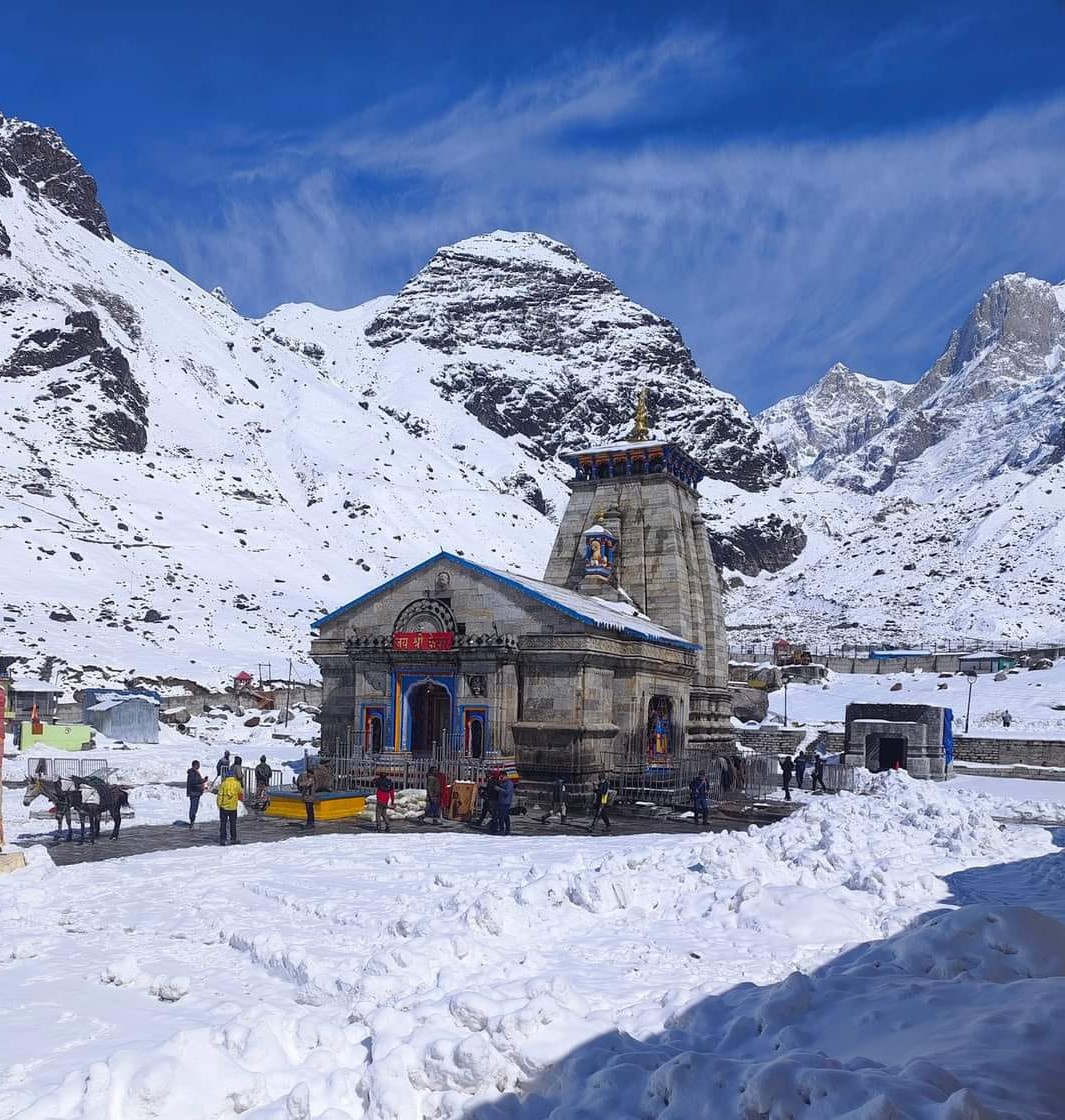
A special place of Lord Shiva in Himalayas of Uttarakhand
Kedarnath is a place where a special form of Lord Shiva is seen. Kedarnath Temple is one of the holy pilgrimage sites in the state of Uttarakhand, northern India, located on the banks of the Mandakini river and is a beautiful place in the lap of Himalayas, which is known as Kedarnath. The name of the historical heritage of this area is “Kedar Khand”. Kedarnath temple is a special part of Char Dham Yatra and Panch Kedar in Uttarakhand state and it is known among the 12 Jyotirlingas of Lord Shiva in India.
Kedarnath This is the most remote place among all the Char Dham sites where Shiva is the Taposthali, and is surrounded by snow-capped mountains that attract thieves and people to itself. Known for its ancient Shiva temple, a visit to Kedarnath Dham is a beautiful and mind-blowing exhilarating experience. Like other places, Kedarnath temple closes on the first day of Hindu month Kartik October-November and every year Baba Kedarnath ji’s door opens again for his devotees in Vaishakh April-May
Where do worship Lord Kedarnath in Uttarakhand ?
When Lord Shiva is shifted from Kedarnath to Ukhimath Dham, this Shiva temple remains submerged in snow for almost half a year 6 months. Where sages dedicate themselves to the feet of Baba Kedar even in the winter season, they worship him and do meditation yoga. According to a legend, it is said that Lord Shiva is seen in various forms such as arms in Tungnath temple, face in Rudranath temple, stomach in Madmaheshwar temple and head in Kalpeshwar temple with his hair. give. Kedarnath and the above four temples are considered as Panch Kedar. Where Lord Shiva is worshiped in all the Dhams.
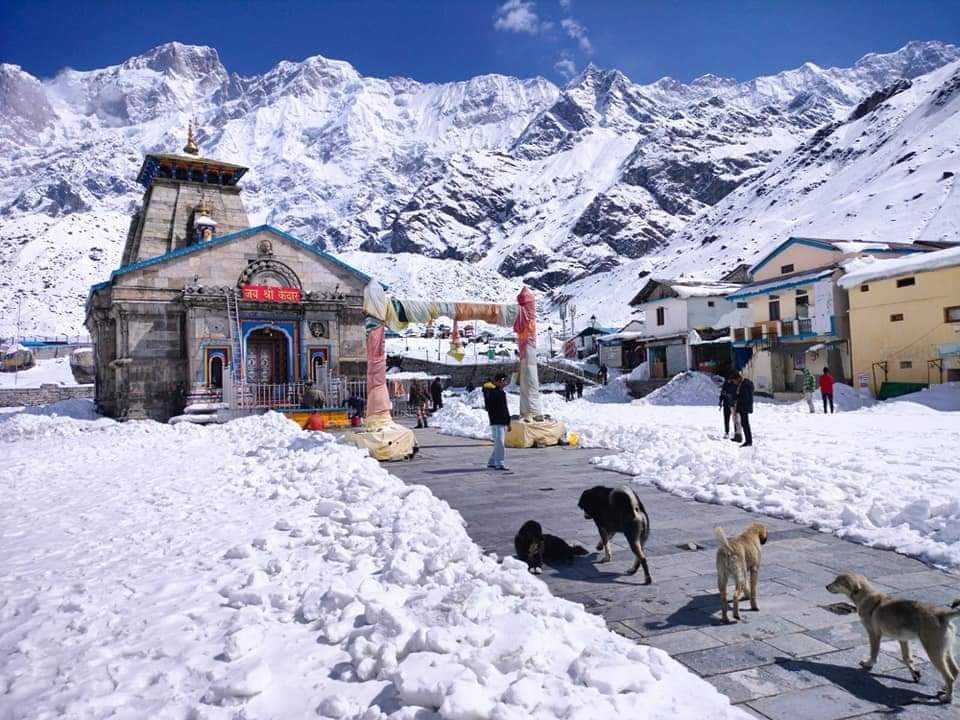
Key Points of Kedarnath Trek
Some of the trek highlights of kedarnath trek.
Even before the trek starts trekkers are introduced to many lavishing vistas of Rishikesh, Devprayag and Rudrapryag. The magical confluence of Alaknanda & Bhagirathi at Devprayag and Alaknanda with Mandakini at Rudraprayag is an inner outer experience. Beautiful temples at every few kilometers clearly stamps that yes trekkers are indeed at the Land of Gods ‘Uttarakhand”.
The trek officially commences from Gaurikund covering many campsites along the way. Jungle Chatti, Bheembali, and Linchauli are some of the camps we pass during the trek. The entirety of journey trekkers would find devotees chanting and celebrating the trail. Echo of “Har Har Mahadev” fills you with an exceptional spiritual embodiment.
The final reach of Kedarnath is enough to overwhelm devotees with the chants of “Mahadev”. Temple covered in long ribbons of marigold garlands, long happy queues of devotees and the calmness of the Kedarnath. Everything about this place will capture you in its essence.
The trek to Kedarnath Temple offers several beautiful and scenic locations that you can visit along the way. Here are some of the most popular places to visit during the Kedarnath trek:
- Gaurikund: Gaurikund is the base camp for the Kedarnath trek and is located at an altitude of 1,982 meters (6,503 feet) above sea level. It is believed to be the place where Goddess Parvati meditated to win Lord Shiva’s heart.
- Rambara: Rambara is a picturesque location located around 7 kilometers from Gaurikund, and is an ideal place to take a break during the trek. It is situated at an altitude of 2,835 meters (9,301 feet) above sea level and is surrounded by beautiful valleys and waterfalls.
- Kedarnath Temple: Kedarnath Temple is the main attraction of the trek and is located at an altitude of 3,583 meters (11,755 feet) above sea level. It is one of the twelve Jyotirlingas in Hindu mythology and is considered to be one of the most sacred sites in India.
- Vasuki Tal: Vasuki Tal is a serene lake located around 6 kilometers from Kedarnath, and is surrounded by beautiful mountain peaks. It is situated at an altitude of 4,150 meters (13,615 feet) above sea level and is a popular spot for camping and trekking.
- Gandhi Sarovar: Gandhi Sarovar is a glacial lake located around 2 kilometers from Kedarnath, and is named after Mahatma Gandhi. It is situated at an altitude of 3,900 meters (12,795 feet) above sea level and offers stunning views of the surrounding mountain ranges.
Things to Look out for-
- Souvenirs from Rishikesh are great for memories.
- There are countless photogenic vistas, so we recommend that you prepare yourself for any aesthetic shoots. The best pictures are those taken under a blue sky with snow-covered peaks in the background.
- Explore the tranquility of this holy site and submerge yourself in “Baba Kedar’s” blessings.
The altitude covered in Kedarnath Trek
- Rishikesh-340 m
- Sonprayag-1829 m
- Gaurikund-1982 m
- Kedarnath-3583 m
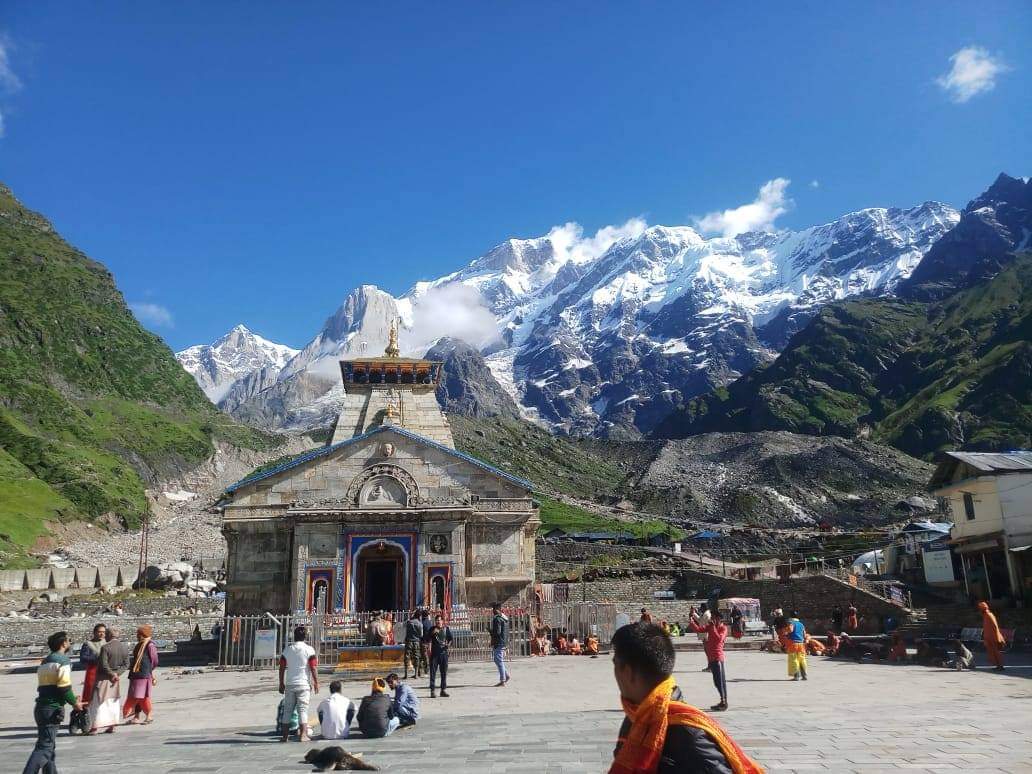
Best Time to Visit Kedarnath Trek & Opening or closing time every year
Kedarnath Temple, located in the Indian state of Uttarakhand, usually opens for visitors in late April or early May each year, and closes in the first week of November before winter sets in. The exact dates of opening and closing of the temple are determined by the Char Dham Devasthanam Board, which oversees the management of the temple. However, it’s important to note that the dates may vary slightly from year to year, depending on various factors such as weather conditions and other local considerations. If you are planning to visit the temple, it’s a good idea to check with the official website of the Char Dham Devasthanam Board or local authorities for the exact dates of opening and closing before making travel arrangements.
Kedarnath temple is best visited during the summer months of April to June. and September to Last October. Families and friends can enjoy the mild temperatures of these months. The unfavorable temperatures and precipitation make this trek a per and post monsoon season trek. Temperatures typically range from 15 to 20 degrees Celsius during the day, with substantially colder nights.
The most popular time to visit Kedarnath Temple is during the Char Dham Yatra season, which typically runs from April/May to October/November, depending on the weather conditions. During this time, the roads leading to Kedarnath are open, and the temple is easily accessible.
To reach Kedarnath from Haridwar, you can take a shared taxi or bus to Gaurikund, which is the base camp for the trek to Kedarnath. The trek is approximately 14 kilometers long and takes around 6-8 hours to complete, depending on your pace and physical fitness level. Along the way, you will pass through several scenic locations, including waterfalls, lush forests, and picturesque valleys.
During the Char Dham Yatra season, there are several facilities available for pilgrims, including accommodation options, medical facilities, and food stalls. It is advisable to carry warm clothing, sturdy trekking shoes, and basic first aid supplies when trekking to Kedarnath, as the weather can be unpredictable and the terrain can be challenging.
Overall, visiting Kedarnath during the Char Dham Yatra season can be a memorable and spiritually uplifting experience, as you will be part of a large community of devotees who are all journeying towards a common goal.
1) Is it safe?
2) Difficulty level
3) Weather conditions
4) Things to carry
5) Connectivity and transaction
6) How to reach
7) Short Itinerary
Is Kedarnath Trek is safe?
Set amidst the high altitude ranges, concerns regarding Kedarnath Trek safety are undeniably very valid questions. Yes the trek to Kedarnath is indeed very safe and reliable, new trails and much clearer safety protocols are sure to easy anyone’s concern.
Difficulty level in Kedarnath Trek
Because the top is relatively high in elevation for any beginner level trekkers we strongly recommend a reasonable level of physical fitness. We advise trekkers to physically and mentally prepare themselves prior to this trek.
Any medical assistance that is required will be provided at any point of the journey; however, trekkers must consult their professional care before beginning any trek. We also strongly advise trekkers to learn about altitude sickness and to notify our teams as soon as any symptoms appear.
Weather conditions
Weather conditions depend on the time of the year trekkers are travelling. In the months leading up to and following the monsoon season, the daytime temperatures are moderate, but the nighttime temperatures are significantly lower. Monsoons receive moderate to heavy rainfall.
Short itinerary of Kedarnath Trek
Day 1 Drive from Haridwar via Rishikesh to Sonprayag 202 km by taxi (1982 m overnight stay hotel
Day 2 Aftre breakfast Sonprayag to Gaurikund same day trek to Kedarnath temple 15 km (6/7 hours) (3553 m) overnight stay Hotel
Day 3 After Arti Darshan trek from Kedarnath to Gaurikund same day drive to Sonprayag over night stay Hotel
Day 4 Drive from Sonprayag to Haridwar via Rishikesh 202 km
Note: – Our service will remain from Rishikesh to Rishikesh – for more details please check includes or excludes
Things to carry in Kedarnath Trek
1) Because nights at elevations tend to be considerably colder, we suggest having well-graded, warm and comfortable clothing along with good quality shoes.
2) Despite the fact that we handle medical crises, we urge individuals to keep their emergency kits at hand in any case of personal underlying illnesses.
3) Since the journey provides you with a picturesque view of many peaks, don’t forget to bring your camera along with extra batteries.
4) Our staff will consult with fellow trekkers about their luggage and, if lacking, will assist trekkers in obtaining any necessary equipment. Only the relevant luggage should be brought, as a result.
Other trekking Essentials-
Connectivity and Transactions
1) Because connectivity along the route is unpredictable, we urge people to do all of their work ahead of time.
2) Last ATM transactions available will be at Gaurikund but we recommend travelers to collect cash beforehand or while in Rishikesh as ATMs available at other places might not dispense cash at times.
How to Reach Kedarnath Trek
If you are travelling from any metropolitan city in India or from outside India, getting to the capital city of Delhi may be the first and most important step. All major modes of transportation, such as air, road, and rail, can take you to Delhi.
Rishikesh is connected to most major cities in India via all chief modes of transportation. Trekkers could perhaps conduct extensive research for their direct mode of transportation to ensure a much smoother arrival.
By air – Jolly Grant Airport is the nearest airport to Rishikesh. It is well connected to Delhi and many chief cities with daily flights. How to reach Rishikesh from Delhi
By road -Delhi has direct road routes to Rishikesh. Trekkers will have to book either a bus or private cabs. Prior booking for cabs and buses are easily available at various sites.
Delhi> Rishikesh >Sonprayag>Gaurikund
By railway – Nearest Railway station to Rishikesh will be Rishikesh Railway station . Since Rishikesh is connected to all major railway routes, trekkers can opt for a direct route or via Delhi. They can also opt for direct trains to Dehradun or Haridwar and the take cab or bus to Rishikesh.
.Some important points to note-
- Please note that we don’t provide timings schedules for transportation before Rishikesh. Subjected to various conditions the scheduled timings and availability of particular rides may differ. We recommend trekkers to reach out to our teams for any queries. You can drop an email or call us for an initial guided session.
- Our teams will be collecting trekkers at fixed points of airports, railway stations and bus stands.
- It is recommended that unless any delay arrives, trekkers are advised to reach the destinations at least 2 hours prior.
Things Himalayan Hikers Recommend
As previously stated, a camera, as well as spare batteries and memory cards, are recommended. We can assure and guarantee that you will be stopping frequently along the trail to observe the grandeur of the trekking experience.
We strongly recommend trekkers to prepare beforehand for the journey ahead. Regular practicing physical fitness and mental endurance will surely assist trekkers in great time.
After the trek, we strongly encourage trekkers to tag us on social media when they post any memories from the trip; this will not only prove invaluable to us with our work, but will also serve as a motivational example for all of our experts.
Why you should choose us
We’re here to give you the greatest experience possible through the eyes of highly skilled and qualified specialists who have a passion for adventure sports. We are community members attempting to promote our favorite adventure sports while also supporting local businesses. We, at Himalayan hikers, dedicate ourselves to providing you with an unforgettable experience.
What we do during an emergency breakout in the Kedarnath Trek?
First of all, the safety of trekkers is much more for us, if you see in the trek, then there are all the risks, which I do not think about.
Himalayan Hikers worry more about you that no one should ever have any problem in the trek.
What should we and you keep more safety in the trek
- Whenever you are going for kedarnath trek, it is very important that you go completely fit and ready.
- Kedarnath trek is Moderate, if you make your feet and your mind calm and strong, you will find the trek very easy.
- While trekking, keep in mind that you are walking on the right route or not always with your guide.
- Most people look somewhere and where they are walking, this can cause twitching in your legs, which can ruin your entire trek.
- It is important to ask your doctor if you have any medical problems
- I should always keep my medical kit with me, it is very important.
- Himalayan Hikers always keep a medical kit with you, such as oxygen cylinders, medicine to be given in emergency on the kedarnath trek
- If any trekkers have any more problems, then they are brought back to the base camp by laying them in the stretcher.
- Our Hotels in Kedarnath trek is around the 6000 feet to 11,000 feet where you can not have any problem of oxygen, this is tree line area
- In case of any medical problem, the help of your guide or a well-informed trekkers should be taken
- If there is major health problems in Kedarnath trek , then Nearest Hospital is in Rudarparyag / Gaurikund / Karanparyag which is about 69 Kms away from Kedarnath trek last option in dehradun and Rishikesh the distance is 257 kms
- Along with the trek we keep getting acclimatization
Self-Certificate of Emergency Breakout
Trekking in the Himalayas is not a cup of tea but it is a rewarding experience. However, it’s important to keep things in mind when it comes to Safety. One must know about the weather conditions, the altitude gain, fitness and other factors that can wreck your experience. In such adverse conditions, you are solely responsible for your well being and act maturely.
Also Read About – Safety Tips For Safe Trekking.
Preparations before the Trek
You’ve to understand that treks are away from cities and medical help is not always easily available. So, if you are heading for an adventurous trekking trip, stick to certain trekking guidelines and tips. Following these simple tips will help make the trek more fun and experiential for you as well as your fellow trekkers.
These tips and guidelines cater to useful and requisite information about your fitness training, packing and health precautions to be taken before and during the trek.
- Firstly, when you start, target 5 km in 40 minutes
- Then gradually increase your pace by running at least 4 times a week. Then try to bring it down to 5 km in less than 37 minutes
- If you are a person who prefers cycling over running then your target must be 22 km means you should be able to cover 22 km in 60 minutes.
- Walking is a great exercise that gives great shape to your legs and your body. It helps in burning calories and cut down excess weight and strengthens the heart.
- Jogging is effective in increasing the human lifespan and makes your lungs stronger. It is an aerobic activity that requires a lot of oxygen. This is a great exercise for fighting obesity and staying healthy.
- Squats are the best form of functional exercises to improve stability. They also strengthen your legs, thighs, hips, and hamstring.
- Another great cardiovascular exercise is pushing your body upstairs after stairs. This is regarded as the best exercise for increasing strength and power
What to pack for Kedarnath Trek
Warm clothes, sleeves, wind shelter, comfortable clothing, and extra warm clothes so that you can enjoy trekking. A raincoat is the necessary
Footwear: A well-fitted trekking footwear shoes are highly recommended. If you wear an uncomfortable pair of shoes, your feet will be hurt.
Day 1: Drive from Rishikesh to Sonprayag
Our teams will pick up trekkers at Rishikesh and then they will be taken to Sonprayag. The entire journey of the holy river Ganga will accompany us. Trekkers can relish in the beauty of the journey. Buses will be stopping at Devprayag and if lucky trekkers might get a chance to witness the great confluence of rivers Alaknanda and Bhagirathi. After crossing another confluence of Alaknanda and Mandakini at Rudraprayag, trekkers will finally reach Sonprayag. Check in to respective hotels and rest for the night
Day 2 : Gaurikund to Kedarnath
Next day after breakfast teams will be dispatching for Kedarnath temple trail via Gaurikund. Jungle Chatti, Bheembali, and Linchauli are some of the camps we pass during the trek.As the teams reach Kedarnath temple after covering a long distance of new trail, trekkers will be stopping to visit the temple and receive Lord Kedarnath’s blessings. Since teams will be staying overnight at camps, hikers will be getting a great opportunity to explore the surroundings. The tranquill grim of this place will leave trekkers yearning for more.
Day 3 : Kedarnath to Gaurikund same day Drive sonparyag
After attending the morning ‘Aarti’ teams will prepare for their return. Trek from Kedarnath to Gaurikund and same day drive to Sonprayag/ rudraprayag on the same day.
Day 4: Sonprayag to Rishikesh
Trekkers will be dispatching for Rishikesh from Sonprayag early in the morning. Come across the beautiful vistas of the journey. Interacting with our teams and other locals in the entirety of our journey can provide an opportunity to learn more about the local culture.
Note- reaching Rishikesh on the date decided is trekkers’ sole responsibility. We can only offer assistance after their arrival in Rishikesh.
Mandatory Documents
Please carry the documents given below.
Original and photocopy of government photo identity card- (Aadhar Card, Driving License, Voters ID, etc, Passport and Visa important to foreigners Medical Certificate (First part should be filled by the Doctor and Second part by the Trekker) Declaration Certificates
Note: – Many trekkers commit the same mistake of carrying unnecessary items on a trek which only makes the backpack heavy. It is important to know the right items to carry. It differs from season to season if you are trekking in summers then carry less layers of warm clothing and if you are trekking in winters carry enough layers to protect yourself against chilly cold.
Necessary Items for trekkers

Backpack (50 to 60 liters) A strongly built backpack with good support is compulsory for a trek. (Rain cover is important)
Sturdy Trekking Shoes The shoes should be strong enough with good support. The people ask if sports shoes would be comfortable but it is good to bring the right trekking shoes.
The Clothes You Should Bring On a Trek Avoid keeping extra clothes because it only makes you backpack heavy.
Trek Pants – The jeans are never suitable for a trek so you need at least 2-3 trek pants for treks carry more for longer treks.
Jacket – Jackets are very important to carry on a trek it protects you against the chilly weather. So carry 2 jackets on a week long trek.
Layers of warm Clothing Carry warm woolen layers or fleece. Carry more layers during winter season (at least 2 to 3) and less during summer.
Thermals – The Temperature decreases at night so you might be need thermals for Night.
T- Shirts – Bring those t shirts which dry fast.
Poncho –They are needed if you are trekking on a Rainy day to keep you dry.
Hiking Pole
Water Bottle 2
Cap or Balaclava
Woolen and Waterproof Gloves
Socks (Woolen and Regular)
Torch head light
Personal Toiletry Items – (toothpaste, toothbrush, toilet paper, sanitizer etc.)
Carry Personal Medical Kit
Personal Medical Kit (Carry minimum 5 tablets and maximum 10)

Diamox – (Prevents altitude sickness)
Digene – (It cures discomfort in stomach, acidity)
Crocin Advance – (Cures fever and headache)
Aspirin/Combiflam – (Pain reliever)
Disprin – (Cures headache)
Avomine – (Prevents motion sickness)
Avil – (It treat allergies)
Norflox TZ & Lomofen – (Prevents Diarrhoea)
Ranitidine – (Reduces the amount of acid in stomach)
Volini/Moov spray – (For sprains)
Betadine/Savlon – (Antiseptic cream)
Stretchable/Elastic bandage
Note:- Use medicines only when prescribed by the doctor. In case you face any problem during your trek, discuss and take advice from the Professional guide.
09 May to 12 May 2024 (open)
12 May to 15 May 2024 (Open)
17 May to 20 May 2024 (Open)
18 May to 21 May 2024 (Open)
19 May to 22 May 2024 (Open)
24 May to 27 May 2024 (Open)
25 May to 28 May 2024 (Open)
26 May to 29 May 2024 (Open)
01 June to 04 June 2024 (Open)
02 June to 05 June 2024 (Open)
03 June to 06 June 2024 (Open)
07 June to 10 June 2024 (Open)
08 June to 11 June 2024 (Open)
09 June to 12 June 2024 (Open)
14 June to 17 June 2024 (Open)
15 June to 18 June 2024 (Open)
16 June to 19 June 2024 (Open)
21 June to 24 June 2024 (Open)
22 June to 25 June 2024 (Open)
23 June to 26 June 2024 (Open)
28 June to 01 July 2024 (Open)
29 June to 02 July 2024 (Open)
September-2024
What is included in this trek.
Transport Facility from Rishikesh to Rishikesh
Forest Permit and entrance fee
Accommodation in Hotel on twin share basis
All meals: breakfast, packed lunch, tea, coffee, snacks, soup and Dinner
Radio Walkie Talkie for Communication
Good Experience Local Trek Leader guide and Technical guide
Medical Kit
Oxygen Cylinders
What is Not Include In This Trek?
Personal Insurance
Medical Certificate
Personal toiletry Items and Personal Medicine kit
3 reviews for Kedarnath Trek
Arijeet Das – June 14, 2023
I want to visit kedarnath temple & tungnath temple in one trip, can I get a customised package for that?
Himalayan Hikers – June 15, 2023
Please contact or WhatsApp us at +91-9756197558
dilip varadharajan – May 11, 2023
HI i planned for kedarnath during 29 to 2nd june 2023 im travelling fron uae and will i be able to complete and travel back on 02nd june 2023
Himalayan Hikers – May 13, 2023
Please Email us at [email protected] and call or Whatsapp us at +91-9756197558.
Nishant prajapati – December 3, 2022
I want to go Kedarnath
Himalayan Hikers – December 4, 2022
Hi Namaste please feel free call us 9756197558
Your email address will not be published. Required fields are marked *
Name *
Email *
Save my name, email, and website in this browser for the next time I comment.
Related Tours
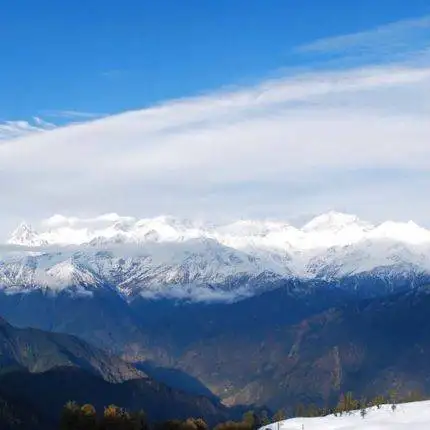
Dayara Bugyal Trek
The Most Popular Winter Trek in Uttarakhand Himalayas
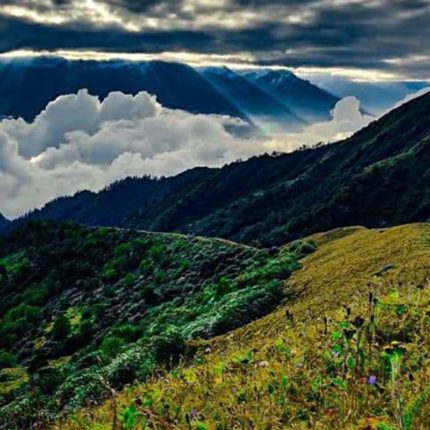
Gidara Bugyal Trek
Gidara Bugyal Trek The Secret Meadow in the Himalayas
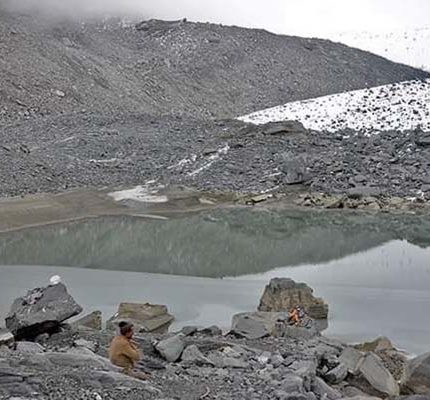
Saptarishi Kund Trek
Saptrishi Kund the Real Source of River Yamuna
Price: ₹ 11,000.00
Book the tour
Send a quick enquiry.
- Overview Itinerary Dates Include/Exclude
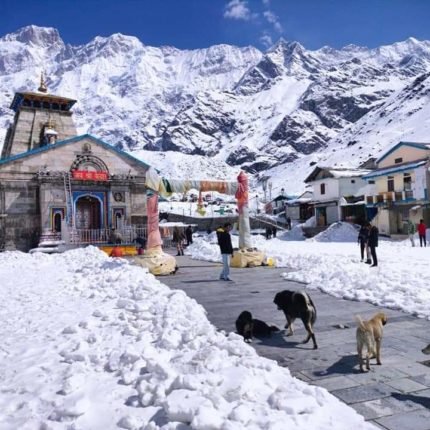
A Guide for Kedarnath Trek
The Kedarnath Yatra Trek stands as a revered pilgrimage route, traversing the rugged terrain of the Himalayas to reach the divine destination of Kedarnath Temple . This comprehensive guide delves into every aspect of the journey, providing intricate details to ensure pilgrims embark on a spiritually enriching and safe adventure.
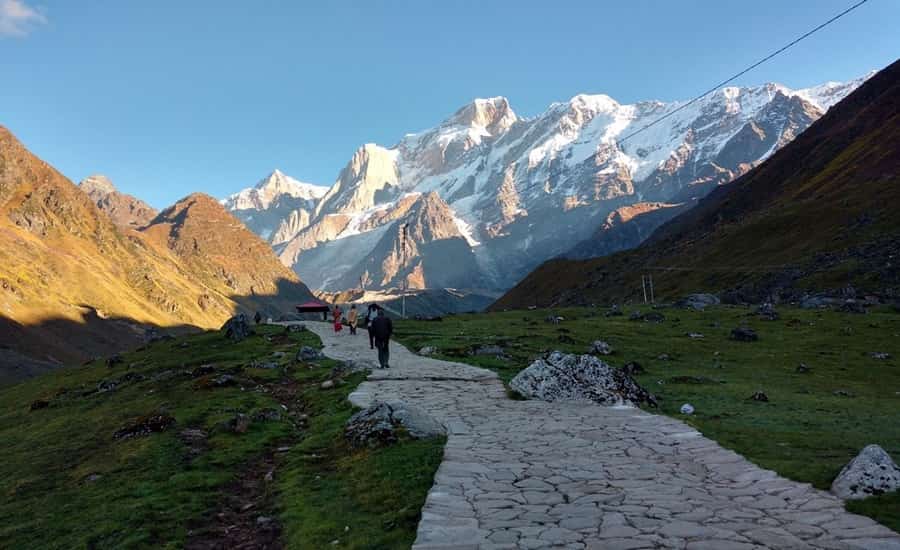
Table of Contents
How to Reach Kedarnath
Here are the ways to reach Kedarnath with distances using different modes of transportation:
- Buses are available from major cities like Haridwar , Rishikesh , and Dehradun to Gaurikund , the nearest road point to Kedarnath.
- The distance between Gaurikund and Kedarnath spans approximately 16 kilometers.
- From Gaurikund, you have to trek or hire a pony or palanquin to reach Kedarnath.
- Taxis can be hired from cities like Haridwar, Rishikesh, and Dehradun to Gaurikund.
- Taxis can also be hired for the complete journey from Haridwar, Rishikesh, or Dehradun to Kedarnath, but certain stretches may not be accessible by vehicle.
By Helicopter
- Helicopter services are available from Phata , Sersi, or Guptkashi to Kedarnath.
- The distance covered by helicopter varies depending on the starting point, but it significantly reduces travel time.
- This is the quickest but most expensive option.
- You can drive to Gaurikund, which serves as the nearest road point to Kedarnath.
- The distance from major cities like Haridwar, Rishikesh, and Dehradun to Gaurikund varies, but it’s approximately 220 kilometers from Haridwar.
- Beyond Gaurikund, vehicles are not permitted, and you’ll have to trek or use alternative modes of transport to reach Kedarnath.
- The road conditions may vary, so it’s advisable to check beforehand and ensure your vehicle is suitable for mountainous terrain.
Kedarnath Route from Delhi
Embarking on the journey from Delhi, travelers have multiple transportation options:
By Road (Self-Drive or Taxi)
- Start from Delhi and head towards Haridwar or Rishikesh via NH334 or NH44.
- From Haridwar or Rishikesh, continue towards Rudraprayag via NH7.
- From Rudraprayag, take the route towards Augustmuni and then continue towards Guptkashi.
- From Guptkashi, proceed to Gaurikund, which is the nearest road point to Kedarnath.
- Park your vehicle at Gaurikund and commence the trek to Kedarnath or arrange for alternative transportation like ponies or palanquins.
- Take a flight from Delhi to Dehradun’s Jolly Grant Airport.
- From Dehradun, drive to the helipad at Phata, Sersi, or Guptkashi (depending on the helicopter service you choose).
- Board the helicopter from the respective helipad for Kedarnath.
By Train and Road
- Take a train from Delhi to Haridwar or Rishikesh.
- From Haridwar or Rishikesh, follow the road route mentioned above.
Kedarnath Trek Distance
The Kedarnath trek spans approximately 16 kilometers from Gaurikund to the sacred Kedarnath Temple. This picturesque route winds through stunning landscapes of meadows, forests, and streams, offering pilgrims a blend of physical challenge and spiritual fulfillment. Along the way, resting points and settlements provide essential amenities, making the journey both memorable and rewarding.
Kedarnath Distance Chart
Understanding the distances between major cities aids in planning a seamless journey:
- Delhi to Haridwar: 206km
- Haridwar to Rishikesh: 24km
- Rishikesh to Devprayag: 72km
- Devprayag to Srinagar: 34km
- Srinagar to Rudraprayag: 33km
- Rudraprayag to Gaurikund: Approximately 74km
- Dehradun to Kedarnath (by air 109km) (by helicopter): Approximately 40 minutes
- Delhi to Dehradun: Approximately 250km
- Delhi to Rishikesh: Approximately 235km
- Delhi to Rudraprayag: Approximately 370km
- Delhi to Gaurikund: Approximately 445km
Route Map of the Kedarnath Trek
The trekking route to Kedarnath spans approximately 16 km, meandering through picturesque landscapes and quaint Himalayan villages. Post the 2013 flood catastrophe, a new route was established, ensuring safety and accessibility for pilgrims.
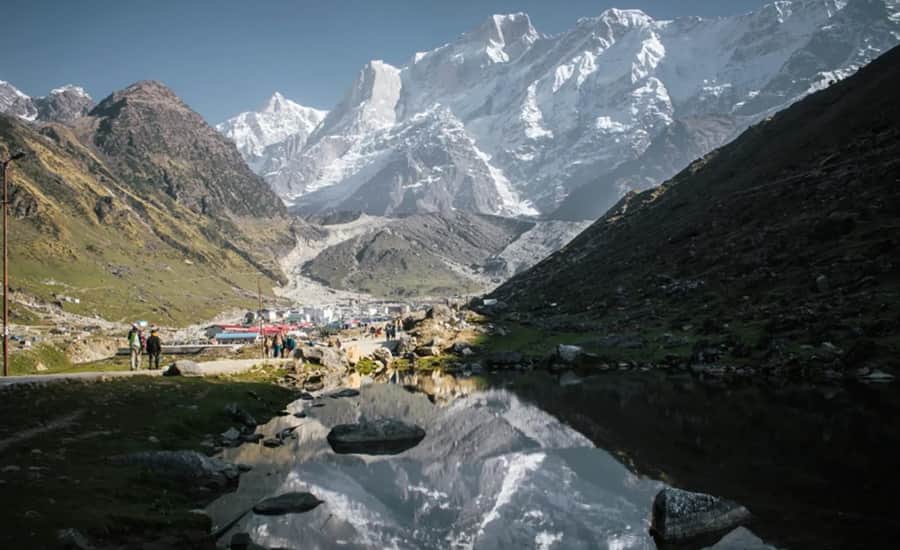
Stops along the Route
Start Point: Gaurikund
- Gaurikund serves as the initial point of the trek, bustling with pilgrims and essential facilities.
Jungle Chatti
- Approximately 6 km from Gaurikund, Jungle Chatti offers a serene stopover amidst verdant landscapes.
- Continuing the journey, trekkers reach Bheembali, a quaint village nestled in the Himalayas, about 4 km from Jungle Chatti.
- After traversing through lush forests and captivating vistas, Linchauli, situated 3 km from Bheembali, provides a refreshing respite.
Kedarnath Base Camp
- Progressing further, trekkers arrive at the Kedarnath Base Camp, a crucial resting point before the final ascent to the revered Kedarnath Temple. This segment covers approximately 4 km.
Kedarnath Temple
- Culminating the trek, pilgrims reach the iconic Kedarnath Temple, nestled amidst the majestic Himalayan peaks, completing the approximate 1 km stretch from the base camp.
Facilities at Kedarnath Trek
Essential facilities along the trek ensure pilgrims’ safety and comfort throughout the journey:
- Accommodation : Tented campsites offer shelter and rest for weary travelers.
- Transportation : Palki/Dandi, Kandi, and Mule/Ponies services facilitate transportation of pilgrims and luggage.
- Food and Water : Small eateries and shops provide nourishment and hydration along the trail.
- Medical Assistance : Basic medical facilities at Kedarnath Base Camp offer aid to pilgrims in need.
Best Time to Visit Kedarnath
Choosing the right time to embark on the Kedarnath Yatra is crucial for a safe and enjoyable experience:
Ideal Months : May to June and September to October offer pleasant weather conditions, avoiding the monsoon season’s risks of landslides and heavy rainfall.
Kedarnath Trek Itinerary
A well-planned itinerary ensures a smooth and fulfilling pilgrimage experience:
- Day 1 : Departure from Delhi, reaching Gaurikund by evening for an overnight stay.
- Day 2 : Trek from Gaurikund to Kedarnath, visiting the temple and exploring the surroundings before retiring for the night.
- Day 3 : Return trek from Kedarnath to Gaurikund, followed by the journey back to Delhi.
Trekking Tips & Things to Carry
Essential tips and items to carry ensure pilgrims are well-prepared for the trek:
- Medical Check-up : Undergo a thorough medical examination before embarking on the trek.
- Essential Gear : Trekking shoes, warm clothing, water bottles, snacks, and first-aid kits are indispensable.
- Hydration and Rest : Stay hydrated and pace oneself to avoid exhaustion and altitude-related issues.
- Environmental Responsibility : Respect nature, follow designated trails, and adhere to local guidelines to preserve the pristine Himalayan ecosystem.
Addressing common queries helps pilgrims plan their journey effectively:
- Transportation Options : Information on transportation modes and availability.
- Accommodation Facilities : Details about accommodation options and booking procedures.
- Trekking Difficulty : Insights into the trek’s physical challenges and preparation required.
- Weather Conditions : Advice on weather forecasts and precautions to take during the journey.
- Pilgrimage Rituals : Guidance on performing rituals and customs at Kedarnath Temple.
The Kedarnath Trek stands as a sacred odyssey through the Himalayan wilderness, offering pilgrims a transformative journey of faith and self-discovery. With meticulous planning, preparation, and adherence to safety guidelines, every pilgrim can embark on a memorable expedition to the divine abode of Lord Shiva.
Suggested Tour:
- Badri Kedar Yatra Package from Delhi
- Do Dham Yatra Package by Car
- Badrinath Kedarnath Helicopter Tour
- Kedarnath Dham Yatra from Delhi
- Panch Kedar Yatra Package
- Kedarnath Yatra with Chopta Trek
- Kedarnath Tour Package from Haridwar
Leave a Reply Cancel reply
Your email address will not be published. Required fields are marked *
Save my name, email, and website in this browser for the next time I comment.
This site uses Akismet to reduce spam. Learn how your comment data is processed .
Plan Your Trip Our expert will get in touch with you shortly
Mobile No *
We never share your Information.

Recent Posts
- Dehradun Tourist Attraction
- Chardham Yatra Helicopter Route Map
- Treks around Char Dham
- Ghats in Haridwar for Holy Bath
Booking Helicopter Tickets for Kedarnath
Nestled amidst the majestic Himalayas, Kedarnath is one of the holiest pilgrimage sites for Hindus, drawing millions of devotees every year. Located in the Indian state of Uttarakhand, reaching Kedarnath involves navigating challenging terrain. While trekking remains a popular option, helicopter services have emerged as a convenient and time-saving alternative. Here's a comprehensive guide to book...
April 18, 2024
How to Reach Kedarnath from Delhi
The pilgrimage to Kedarnath, nestled amidst the Himalayas, is not merely a journey but a spiritual odyssey for countless devotees. Each year, from various corners of the nation, pilgrims embark on this sacred expedition seeking solace and divine blessings. For thos...
April 5, 2024
Haridwar to Kedarnath Guide
The journey from Haridwar to Kedarnath transcends mere physical travel; it's a pilgrimage deeply rooted in spirituality, adventure, and the awe-inspiring grandeur of the Himalayas. Let's delve into the intricacies of this sacred odyssey, from the distance covered t...
April 3, 2024
Accommodation Options In Kedarnath Dham
Kedarnath Welcomes lakhs of devotees from all across India every year. It is one of the most prominent Hindu pilgrimage sites in India. Being one of the Chota Char Dham sites, pilgrims yearn to visit Kedarnath Dham once in a lifetime. The journey to Kedarnath is di...
March 31, 2024
Kedarnath Trek – A Complete Guide

Table of Contents
Where is Kedarnath?
Kedarnath (3,553 metres, approximately) is a Hindu temple dedicated to Lord Shiva located in the Rudraprayag district of Uttarakhand. It lies just below the base of the mighty Kedarnath peak (6,940 metres), and is the First Kedar to be visited in case you are staying true to the sequence of the Panch Kedar circuit. The other four being Madhmaheshwar , Tungnath , Rudranath, and Kalpeshwar .

I want to drive there myself. What is the motorable route?
Haridwar – Rishikesh – Devprayag – Srinagar – Rudraprayag – Augustmuni – Kund – Guptkashi – Sonprayag – Gaurikund
Distance from Haridwar to Gaurikund: 237 km
The motorable road ends at Gaurikund, but you’ll need to park your vehicle at Sonprayag. No private vehicles or even taxis from outside are allowed to go beyond Sonprayag . The only option is to board one of the shared taxis that specifically run from Sonprayag to Gaurikund. This more than sorts it out in case you are driving here yourself.
The road is more or less well-maintained except for a few patches that fall under the landslide zone. Road from Guptkashi to Sonprayag is patchy at best.

I want to opt for public transport.
- Take a bus or shared taxi (Max) from Haridwar/Rishikesh to Sonprayag
- Take a shared taxi (Max) from Sonprayag to Gaurikund
Buses, both local and of Uttarakhand State Transport, and shared taxis start plying from Haridwar/Rishikesh to Sonprayag as early as 4 am.
That being said, you should know that all the local buses take their own sweet time and multiple halts. All the buses and taxis will drop you at Sonprayag. After this, there is no other choice but to board another shared taxi to Gaurikund.
It should cost one person 1000-1200 bucks, Haridwar to Haridwar.

How long is the trek? How is the trek route like? Do I need a guide? Is there any Medical Aid available?
Gaurikund – Rambara Bridge – Jungle Chatti – Lancholi – Base Camp – Kedarnath (16 km)
It is a well laid out trek all the way through, paved and pretty straight forward.
From Gaurikund to Rambara Bridge (about 7 km) it is gradual yet easy ascent.
It is a steep, gradual ascent after crossing the bridge at Rambara, all the way to the base camp, where it flattens. The last 1 km or so is an easy walk to the temple.
You do not need a guide. Horses, Mules, Palanquins, and Porters are available at Gaurikund. It’s better to book them at Gaurikund itself; you will find many at several points on trek too but they will ask for a price higher than the altitude you will be standing at.
Medical and First Aid facilities are available at several places including Lancholi and Base Camp. There even is a small government hospital just 200 metres from the temple. And police check posts on several points.

Where to stay, eat, and how much will it cost?
There are many Lodges, Ashrams, Guest Houses, and Camps running from Gaurikund to Base Camp that provide cheap accommodation, both private and government run, including GMVN Lodges at Lancholi and Base Camp . The prices can vary from INR 500 per room to INR 2000 , depending on the rush of pilgrims. While the rates shoot up in May-June (peak season), they also go drastically low in the months of September-October (the best time to do this trek).
However, don’t expect anything in terms of luxury; expect basic rooms, warm quilts, simple but good food. There are plenty of tea/coffee shops on the way that also offer food. Expect to pay around INR 100 for a hearty meal for one person .

Is it possible to do Gaurikund-Kedarnath-Gaurikund in one day?
Yes. It depends on your fitness. We had set out at around 2 am and were back by 5 pm the same day, from Gaurikund to Kedarnath and back. Approximately 35 kilometres in 15 hours, which includes 4 hours of wait in the queue outside the temple (it was May). I’ve been told time and again this is a small feat. I am not proud of it. We were behind schedule and had to make up for it. I don’t like to test my speed against distance. Time to me is mostly irrelevant. I like to walk easy. Sit in silence. Maybe lie down. Take a gander at the grandeur. Look into the soul of these mountains. Feel a beat or two. Click a few pictures. Start again. Repeat again. Must we tie self-made accomplishments to places such as these?
This is the gist of it. If you have any further queries, feel free to leave a comment below or contact me through Facebook or Instagram . I’ll get back to you as soon as I can. Stay safe, travel responsibly!

Type your email…
Photographer by day. Travel Writer by night. And a Copywriter in between.
The Pahadi Organic – A True-blue Pahadi Experience
How people shape our journey, you may also like, kalpeshwar trek – a complete guide, tungnath trek – a complete guide, char dham yatra – finding devotion in destruction, pindari glacier trek – ringing in the new..., deoria tal – of epics, myths and himalaya, deoria tal trek – a complete guide, chandrashila – why this should be your first..., binsar – romancing old-world wilderness and the himalaya, madhmaheshwar trek – a complete guide, 20 comments.
Very crisp and adequately informative.
Thanks, Papia. 🙂
Hey Bro, Thanks for this description..!!
Thanks for reading, bro.
Hi Mohit..Beautifully written! To the point! I was planning this trek in September this year..Had a couple of doubts…If I start at say 5 in morning from Sonprayag..Take a shared taxi to Gaurikund. how long does the shared taxi take from Sonprayag to Gaurikund? If I start at 5 from Sonprayag, what time can I expect to start the trek from Gaurikund? I plan to reach the temple by say afternoon and stay overnight..Is there any place I can book on the spot to stay overnight and begin my descent the next day? I’ll be traveling solo! Thanks!
Hi Jatin. Thank you for reading! 🙂
- The distance from Sonprayag to Gaurikund is approximately 4 km. It shouldn’t take you more than 10 minutes to reach Gaurikund. However, this will be a shared taxi and it will not start until it can accommodate all the passengers it has the capacity to. So, I’d say add another few minutes. That being said, September is not the peak season; there shouldn’t be any hassles.
You can start the trek from Gaurikund the moment you reach there.
There are plenty of Lodges, Dharamshalas, and Guest Houses around the temple. Finding a room, on the spot, will be no trouble at all.
All the best! 🙂
Hi Mohit. This is an apt description for anyone who wants to go to Kedarnath. I’m planning to go in early October. Just had a couple of queries. Is it better to take a shared taxi from Rishikesh to Sonprayag? Rather than a bus which might halt at every place and as you said will take own sweet time to reach. Don’t mind paying a little extra for taxis if required. Also, apart from the registration for the yatra which can be done online is there any other registration or fitness certificate required before starting the trek? Thanks!
Hi, Rakesh. Thank you for reading. Shared taxis are relatively faster but almost always cramped. Buses are more breathable. Personally, I prefer buses. No fitness certificate is required.
A very detailed guide to Kedarnath trek, Mohit! I read your blog very carefully to understand your experience and other important things about Kedarnath like how will it cost. Thank you for sharing this article I will visit this place with my friends and family.
Thank you for reading, Manoj. 🙂
Very succinct and a treat to read. I loved the combination of pictures clubbed with crisp text for an amazing experience. Great work brother. Can I have a few of these pictures for one of my videos.
Thank you for appreciating. 🙂
The colour tone is just just just awesome.
Thank you for appreciating.
Hi mohit We r planning to go in d month of may .. I ve one clarification.. 1.Can we start trek around 12 pm? Bec we ll reach gowrikunda @11am. 2. Can we stay middle of d trek. Is any accommodation on d middle?
- You can start anytime.
- Please refer to ‘Where to Stay, Eat, and how much will it cost’ section on the post. All the best.
Hello Mohit , For an ordinary people is easy trek or very diffcult?
Hi. The trek itself is not difficult. It might seem a little long and tiring. But should be manageable as long as you take it easy. All the best.
Dear Mohit – All guides are so well written – Every thing at one place – I have saved all these for my preparations when I go
Thank you! Glad I could be of help. All the best.
Leave a Reply Cancel reply
Kedarnath Trek | Complete Guide, Cost, Itinerary
Region: Uttarakhand
Base Camp: Gaurikund
Grade: Moderate
Distance: 32 Km
Min Age: 8 Years+
Best Season: Summer and Autumn
Trek Description
The Kedarnath trek is a transformative journey deep into the heart of the Himalayas, where nature’s grandeur intertwines with deep spiritual significance. Nestled in the Garhwal Himalayas of Uttarakhand, India, this trek leads to the sacred Kedarnath Temple, a place of profound devotion dedicated to Lord Shiva.
This pilgrimage holds historical importance dating back over a thousand years. The temple is believed to have been constructed by Jagad Guru Adi Shankaracharya. Kedarnath is part of the Panch-Kedar, a group of five temples associated with the Pandavas from the Mahabharata.
It was at this sacred site that the Pandavas sought Lord Shiva’s forgiveness for their actions in the epic, and the temple represents the “back side” of Lord Shiva, set amidst the awe-inspiring Himalayan landscape.
The best time to undertake your journey to the sacred Kedarnath Temple is typically from May to October, aligning with the temple’s opening date on April. This window offers favorable weather conditions and clear pathways, allowing pilgrims to access the main temple of Kedarnath without hindrance.
It’s important to keep in mind that from early November to mid-April, the Kedarnath Temple experiences temporary closure due to heavy snowfall and challenging weather conditions, making the temple inaccessible during this period.
The trek to Kedarnath is known for its accessibility to trekkers of various fitness levels. It is generally considered suitable for all levels during most of the year, making it an inclusive and spiritual journey.
The flora and fauna encountered on this journey add to its charm. The route takes you through lush forests and introduces you to rare wildflowers. At higher altitudes, juniper and Brahma Kamal thrive, enhancing the region’s biodiversity.
The trek also offers glimpses of Himalayan Musk Deer, the colorful Himalayan Monal (Uttarakhand’s official bird), Himalayan Tahr, the elusive Snow Leopard, Himalayan Black Bear, and majestic Himalayan Griffon Vultures soaring in the skies.
It’s believed that the temple was miraculously saved by a massive rock at its rear, revered as “Bheem Shila.” The trek provides opportunities for spiritual reflection as it leads through lush meadows, serene landscapes, and pristine wilderness. Kedarnath is also part of the Char Dham Yatras, the four sacred pilgrimage sites in Uttarakhand.
The Kedarnath trek is a harmonious blend of natural splendor, deep spiritual devotion, historical significance, and profound experiences. It connects trekkers with the divine essence nestled in the heart of the Himalayas.
Drive Distance : 183 km
Drive Time : 7-8 hours
Altitude : 4,500 ft
Your spiritual journey commences as our team picks you up from Rishikesh, a vibrant city that sets the stage for this remarkable adventure. Enjoy a scenic drive covering approximately 180 kilometers, immersing yourself in the breathtaking beauty of the Himalayan landscapes.
As you embark on this soul-enriching expedition, you’ll be treated to awe-inspiring mountain vistas, with the majestic Ganga River accompanying you on your journey. Your path will lead you through several significant checkpoints, each holding its unique charm and significance.
Devprayag: Your first stop, Devprayag, is a place of profound spiritual importance. Here, the holy Alaknanda and Bhagirathi rivers merge to form the sacred Ganga River, marking the inception of your Panch-Kedar pilgrimage. The divine confluence of these sacred waters sets the tone for your spiritual odyssey.
Rudraprayag: Your journey continues to Rudraprayag, where the confluence of the Alaknanda and Mandakini rivers offers another spiritually charged experience. Here, nature’s beauty combines with spiritual significance, providing another opportunity to connect with the divine through the merging of these holy waters.
Agastyamuni: Further along your route, you’ll reach Agastyamuni, a place resonating with the spiritual energy of Rishi Agastya’s meditation. It’s a site where the ancient sage delved deep into his spiritual practice, adding another layer of sacredness to your expedition.
Ukhimath: Your path then leads you to Ukhimath, a town known for its spiritual ambiance and serene surroundings. It’s a place where you can immerse yourself in introspection and soak in the tranquil beauty of the Himalayas.
Guptakashi: Finally, you will arrive at Guptakashi, where you will rest for the night. Guptakashi holds its own significance in the Panch-Kedar pilgrimage. It’s the place where Lord Shiva concealed himself from the Pandavas, prompting Yudhishthira to give it the name “Guptakashi,” signifying the “Hidden Kashi.”
Trek Distance : N/A
Altitude Gain : N/A
The next morning, your journey continues as you depart from Guptakashi and embark on a 27-kilometer drive to Sonprayag, a pivotal starting point for your trek to Kedarnath. The drive itself offers captivating views of the Himalayan landscapes and sets the stage for the beauty that awaits.
The trek from Sonprayag to Kedarnath covers a total distance of 19 kilometers and is a breathtaking adventure. As you ascend through lush meadows, pristine wilderness, and serene beauty, you’ll be captivated by the spiritual energy of the Himalayas. This path not only tests your physical endurance but also provides ample opportunities for introspection and connection with nature.
Altitude : N/A
On this day, you’ll retrace your steps, trekking back from the sacred destination of Kedarnath to Sonprayag. The 19-kilometer trek offers a different perspective of the Himalayan terrain, allowing you to soak in the majestic vistas and the spiritual serenity surrounding you.
Upon reaching Sonprayag, you’ll continue your journey back to Guptakashi, where you can reflect on the profound experiences of the past days.
Drive Time : N/A
As your sacred pilgrimage comes to a close, you’ll embark on the final leg of your journey. The drive from Guptakashi to the vibrant towns of Haridwar or Rishikesh covers a distance of 220 kilometers, taking approximately 8-9 hours.
Along the way, you can reminisce about the transformative experiences, spiritual connections, and breathtaking landscapes that have enriched your soul on this extraordinary adventure.
What’s Included?
Price inclusion.
- Transportation : Transportation from Rishikesh and back to Rishikesh is included in the package.
- Accommodation : Enjoy comfortable stays during your trek with accommodation in hotels, guesthouses, or dormitories, offered on a twin, triple, or dormitory sharing basis. When camping, rest in spacious tents on a double or triple sharing basis.
- Meals : We provide nourishing and delicious vegetarian meals. Our meals are designed to keep you energized throughout the trek.
- Camping Fees/Permits : All necessary trekking permits and woodland camping fees are included in the package, ensuring a hassle-free experience.
- Trek Equipment : We provide essential trekking equipment, including dining tents, kitchen tents, sleeping tents with mattresses, and sleeping bags. Utensils, ropes, micro-spikes, and gaiters (if required) are also part of our equipment offerings.
- Qualified Team : Our team comprises experienced and qualified guides, helpers, and porters who are dedicated to making your trek safe and enjoyable.
- First Aid : A first aid kit with an oxygen cylinder and a helmet (if required) is available to address any potential health concerns during the trek.
- Expert Assistance : You can always reach out to our experts for any queries or assistance during your trekking journey. Simply contact us at +91-8089693825
Price Exclusion
- Mules or Porters for Personal Bags : The service of mules or porters to carry personal bags is not included and can be arranged at an extra cost.
- Emergency Costs : Any expenses arising from emergencies during the trek are not included in the package.
- Tips : Tips for the trekking team are optional and not included in the package.
- Items Not Mentioned : Any expenses or items not mentioned in the inclusion section are not covered.
- Stay at Dehradun : Accommodation and meals in Dehradun on the last day of the trek are not included.
- Meals During Transportation: Meals during transportation are not included.
- GST : A 5% Goods and Services Tax (GST) is applicable and not included in the package.
Things to Carry
- 45-60 Ltr Bag Pack With Rain Cover & Comfortable Straps
- Hot & Cold Water Bottle Like Borosil & Milton
- Energy Bar, Dry Fruits & ORS
- Personal Medical Kit
- 2/3 Full Sleeves (Non-Cotton)
- 1 Full Fleece T-Shirt
- 1 Fleece Jacket (Woollen Or Sweater)
- 1 Down Feather/Hollofil Jacket
- 1 Waterproof Jacket/Poncho
- 1 Pair Thermal Inners (Upper And Lower)
- 2 Trek Pants (Avoid Shorts & Denim Pants)
- 1 Pair of Waterproof Gloves
- 1 Pair of Woollen Gloves
- Woollen Cap
- 4 Pairs Of Cotton Socks
- 1 Pair Of Woollen Socks
- 1 Pairs Of Sunglasses (U/V Protected)
- 1 Neck Gaiters (Buff)
- 1 Waterproof & High Ankle Trekking Shoes
- 1 Pair Of Floaters
- Hand Sanitizer & Sunscreen Lotion
- Toothbrush And Toothpaste
- Toilet Paper And Wet Wipes
- Quick Dry Towel
- Lip Balm & Antibacterial Powder
- Moisturizer
How To Reach Kedarnath
Rishikesh is easily accessible by road and is connected to major cities in northern India. You can hire a taxi or take a bus from cities like Delhi, Haridwar, or Dehradun. Rishikesh has a well-maintained bus station, and you can find both government and private bus services that connect it to nearby towns and cities. Bus journeys offer an economical and convenient way to reach Rishikesh.
The nearest railway station to Rishikesh is Yog Nagri Rishikesh Railway Station, which is well-connected to major Indian cities. From there you have to go to Rishikesh Bus Stand or Natraj.
Raithal is the point where we start our Dayara Bugyal Trek in Uttarakhand. It is approximately 183 kilometers away from Dehradun, which takes around 6 to 7 hours by public transportation. To reach Raithal you have to reach Uttarkashi first.
The bus to Uttarkashi leaves early in the morning around 5:30 am from Dehradun Hill station. You can also book your ticket online via the UTC portal. The average cost of the ticket is around 350 to 400 INR. Shared taxi option is also available.
If you are traveling via taxi, you will be charged around 400 to 500. You can hire a taxi from Rispana Pul and Parade Ground to Uttarkashi. Upon reaching Uttarkashi, you can rent another taxi to Raithal from Uttarkashi Taxi Stand. You must pay 100 to 150 INR to hire the taxi.
Difficulty Level of Kedarnath
The Kedarnath trek is renowned for its accessibility and moderate difficulty level, making it a pilgrimage destination that welcomes travelers of various fitness levels. This inclusivity allows individuals with differing physical capabilities to undertake this sacred journey with relative ease.
The trek typically falls within the moderate category, striking a balance that accommodates both experienced trekkers and those new to such adventures.
Adding to its appeal, Kedarnath is accessible during the summer months from May to October, aligning with the temple’s opening on April. This window offers favorable weather conditions and clear pathways, making it an ideal time for pilgrims to access the Kedarnath temple without hindrance.
The combination of a moderately challenging trek and the temple’s accessibility during the summer months underscores Kedarnath’s reputation as a sacred destination that caters to pilgrims and visitors from all walks of life.
Best Time to do Kedarnath
The best time to undertake your journey to the sacred Kedarnath Temple is typically from May to October, aligning with the temple’s opening date around April. This window offers favorable weather conditions and clear pathways, allowing pilgrims to access the main temple of Kedarnath without hindrance.
It’s important to keep in mind that from early November to mid-April, the Kedarnath Temple experiences temporary closure due to heavy snowfall, making the temple inaccessible during this period.
More Info Regarding Kedarnath
After the tumultuous events of the Mahabharata, the virtuous Pandavas were burdened by deep remorse. Their participation in the great war had led to the deaths of their kin, revered teachers, and countless others, and they understood that these sins could hinder their path to ultimate soul liberation, known as “Moksha.”
The Pandavas’ actions during the Mahabharata, including the use of deceitful tactics on the battlefield of Kurukshetra, did not find favor with Lord Shiva, the divine protector of righteousness. In their sincere pursuit of redemption, they sought Lord Shiva’s heavenly vision, believing that his blessings held the key to absolving their grave sins.
As the Pandavas journeyed towards the majestic Himalayas, they reached Lord Shiva’s sacred presence, where they encountered an enigmatic turn of events. In his infinite wisdom, Lord Shiva chose to hide his true form and test the sincerity of the Pandavas’ penance.
Lord Shiva, the cosmic dancer, transformed into a sacred bull, Nandi, and found refuge amidst the serene Himalayan landscapes. The Pandavas unknowingly witnessed this divine bull from afar, standing before their beloved deity. Recognizing that their sins were not fully atoned for, Yudhishthira, the wise leader among the Pandavas, proclaimed that the place where Lord Shiva had concealed himself would be named Guptakashi, signifying the “Hidden Kashi.”
Nakul and Sahadev, the observant brothers, were the first to notice the unique bull and shared their discovery with Bhima, the strongest Pandavas. Driven by unwavering devotion, Bhima embarked on a quest to capture the divine being.
As Bhima approached, Lord Shiva chose to merge with the earth itself, disappearing. Bhima’s steadfast faith enabled him to perceive the divine presence that had merged with the earth. Legend has it that as Bhima sought to catch Lord Shiva, the earth yielded to his devotion, and numerous divine Lingas (representations of Lord Shiva) emerged from the ground. These Lingas became sacred pilgrimage sites, each enshrining a fragment of the divine essence.
This journey of the Pandavas, seeking Lord Shiva’s forgiveness and redemption, became a profound spiritual odyssey, leaving a trail of sacred sites known for their significance and spiritual potency. This tale of divine concealment, discovery, and revelation continues to inspire countless pilgrims and seekers on their spiritual quests.
The Kedarnath trek offers a mesmerizing encounter with the flora and fauna of the Himalayas, enhancing the spiritual journey with its rich biodiversity. The region’s vibrant flora includes a variety of species that come to life in different seasons. In spring, the landscape is adorned with brilliant red, pink, and white wildflowers, creating a stunning natural tapestry.
The evergreen forests provide not only a breathtaking backdrop but also shade and lush greenery along the hiking pathways. Of special note is the Brahmakamal , Uttarakhand’s state flower, which reaches its peak of uniqueness and beauty during the monsoon season. Higher altitudes bring the graceful presence of juniper and wildflowers, further enriching the area’s botanical diversity.
Himalayan Balsam is renowned for its exploding seed pods that scatter seeds extensively, contributing to the region’s regeneration. Cyananthus Lobatus , with its bell-shaped blooms in shades of blue or purple, graces the upper Himalayan areas. Himalayan geraniums produce exquisite pink to purple blooms, making them a favorite decorative plant in gardens.
Anaphalis Margaritacea , known as pearly everlastings, retains its color even after drying, often used in dried flower arrangements. The Himalayan Bistort , known as Bistorta affinis, is another noteworthy species that thrives in the Himalayas, adding to the region’s botanical charm.
The fauna of the Kedarnath region is equally captivating. The Himalayan Musk Deer , though secretive, occasionally graces the deep woodlands with its presence. Known for its special scent glands that produce musk, these creatures are unique and fascinating.
The Himalayan Monal , Uttarakhand’s official bird, captures attention with its stunningly colorful plumage and enchanting vocalizations, making it a delightful sight for birdwatchers. The Himalayan Tahr , a robust herbivorous mammal, can be spotted in the alpine meadows of the Himalayan region.
The Himalayan Black Bear , an omnivore, resides in the woods near the Himalayas and plays an essential role in the local ecosystem. Finally, the Himalayan Griffon Vulture soars gracefully on thermals, contributing to the ecological balance by effectively scavenging carrion and preserving the health of the alpine environment.
This diverse array of flora and fauna adds depth and wonder to the spiritual journey through the Kedarnath trek, connecting pilgrims with the natural beauty and biodiversity of the Himalayas.
- Har Ki Dun Valley: It’s like stepping into a postcard with its stunning beauty. The valley is known for its dense forests, green meadows, and spectacular views of snow-capped mountains. You might even encounter some exciting flora and fauna along the way.
- Kedarkantha: This place is like a winter wonderland! It’s a popular trekking spot, especially during the winter months when the snow-capped peaks make for a magical experience. The views of the Himalayas from here are breathtaking.
- Osla Village: Osla is a quaint and traditional Himalayan village. It’s a hidden gem situated in the Tons Valley and provides a peek into the local culture and way of life in the region. It’s often a stop or part of a treks to Har Ki Dun and nearby areas.
- Bali Pass: This trek is not for the faint of heart! Bali Pass is a challenging high-altitude trek that connects the Tons Valley to the Yamunotri Valley. It offers breathtaking vistas of the surrounding peaks but requires an excellent trekking experience due to its difficulty.
- Ruinsara Lake: This lake is like a hidden treasure located at a high altitude. It’s a serene glacial lake with crystal-clear blue waters. The surrounding landscapes are breathtaking, making it a perfect spot to unwind and enjoy nature’s beauty.
- Dumdhar Kandi: A lesser-known but equally captivating trekking spot, Dumdhar Kandi offers a trail less frequented by tourists. It’s known for its scenic beauty and tranquility, allowing trekkers to experience nature in its raw form.
Map of Trail
Kedarnath temple was built by Jagad Guru Adi Shankaracharya.
Kedarnath temple is said to be more than 1,200 years old.
The two peaks visible from the Kedarnath valley are Kedar Peak and Kedar Dome.
The sacred river that flows through Kedarnath is Mandakini.
/ Per Person
5% GST & + 1,500 INR Transportation Cost
Cancellation Policy
Available Dates
Similar Treks
Kuari pass trek, gidara bugyal trek, dayara bugyal trek, kedartal trek, leave a comment cancel reply.
Save my name, email, and website in this browser for the next time I comment.
Terms & Conditions
Call us at 8089693825
Subscribe to our newsletter
Get news and discounts straight to your inbox
We are Associated With
Himalayan Dream Treks
Himalayan Dream Treks is a mission-driven outdoor adventure company. The aim is to make destinations that aren’t always found on standard maps available to people who enjoy visiting new locations.
Important Links
Why Choose Us?
Advance Payment
Cancellation Policy & Refund
Privacy Policy
Terms & Condition
Career At HDT
Contact Details
+91-80896 93825
+91-94565 46051
[email protected]
Office Address
Dehradun Office :
10 B, Mothorowala Rd, Dharampur, Ajabpur Kalan, Dehradun, India, Uttarakhand, 248001
© All rights reserved 2024 Himalayan Dream Treks
(To the Himalayas and Beyond)
- Destination
- Buddhist Tour in India
- Religious Festivals of India
- Holidays in India
- Travel Tips
- Pilgrimage App
- Jyotirlinga Yatra
- Char Dham Yatra
- North India Tours
- South India Tours
- East India Tours
- West India Tours
- Devi Darshan Tour Packages

Call Us: +91-8826094899
Mail Us: [email protected]

- Kedarnath Dham
Kedarnath Trek Guide: Exploring the Serene Beauty of the Himalayas
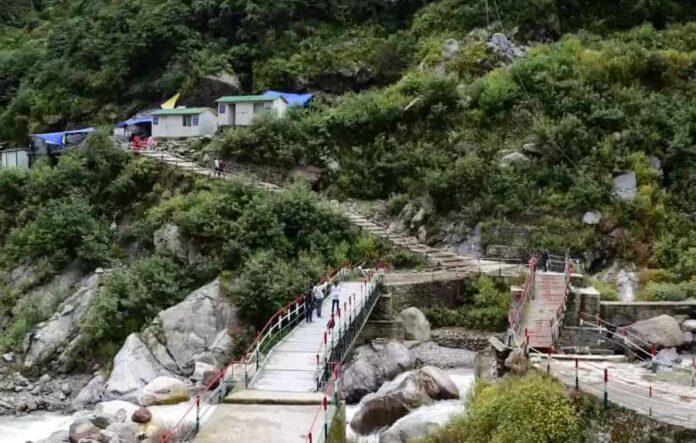
Are you an adventure enthusiast seeking a thrilling journey amidst the towering peaks of the Himalayas? Look no further than the Kedarnath Trek, an expedition that offers breathtaking landscapes, spiritual encounters, and a taste of nature’s grandeur. In this comprehensive guide, we’ll take you through the ins and outs of this incredible trekking experience.
Table of Contents
Introduction to the Kedarnath Trek
Nestled in the Garhwal region of Uttarakhand, India, the Kedarnath Trek is a revered pilgrimage and an adventure seeker’s paradise. The trek takes you to the sacred Kedarnath Temple, dedicated to Lord Shiva, situated at an elevation of 3,583 meters above sea level. The journey is not just about conquering heights; it’s a spiritual quest that connects you with nature’s raw beauty and ancient legends.
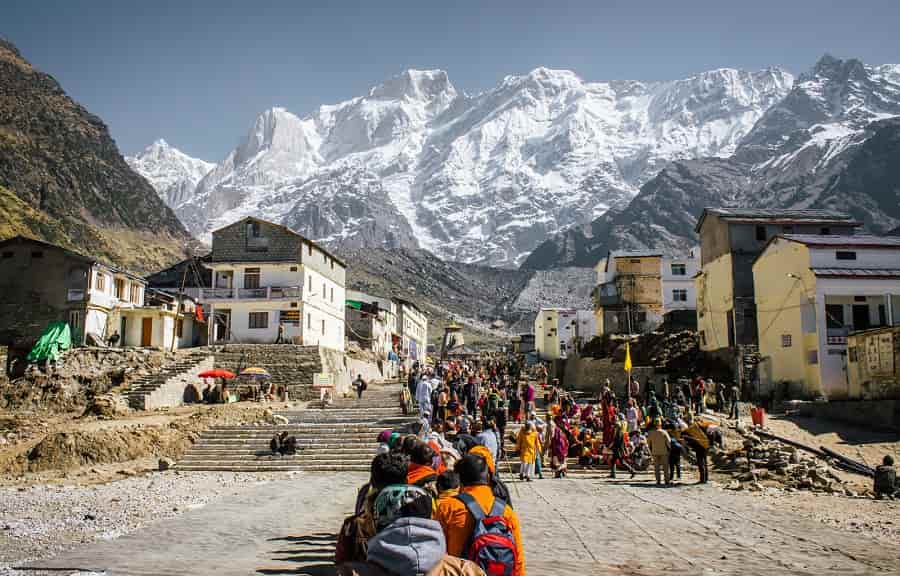
Preparation and Essentials for the Trek
Before embarking on this memorable journey, meticulous planning is key. Ensure you have sturdy trekking gear, including comfortable clothing, sturdy hiking shoes, a durable backpack, and other essentials such as water bottles, energy snacks, a first aid kit, and a map. Acclimatization is vital, so engage in light exercises a few weeks prior and stay hydrated.
Best Time to Visit
The ideal time for the Kedarnath Trek is during the months of May to June and September to October. The weather during these periods is relatively mild, offering clear skies and pleasant temperatures. Monsoon season is best avoided due to the risk of landslides and slippery trails.
How to Reach Kedarnath
To reach Kedarnath, one of the most revered pilgrimage sites in India located in the state of Uttarakhand, you can follow these steps:
- Reach Haridwar or Rishikesh : Most journeys to Kedarnath start from either Haridwar or Rishikesh. These towns are well-connected by road and rail to major cities in India.
- By Road : From Haridwar or Rishikesh, you can hire a taxi or take a bus to Gaurikund, the base camp for the Kedarnath trek. The distance is around 200-220 km and the journey takes about 8-10 hours.
- By Helicopter (Optional) : If you prefer a quicker and more convenient option, you can take a helicopter ride from Phata, Guptkashi, or Sersi to Kedarnath. This significantly reduces the travel time, but bookings need to be made in advance.
- Trek to Kedarnath : The main way to reach the temple is by trekking from Gaurikund. The trekking distance is around 16-18 km, and it usually takes about 6-8 hours to complete. The trek route is well-marked and passes through picturesque landscapes. You can also hire mules or ponies to carry your luggage or to assist you in the trek.
- Stay En Route : There are rest stops and accommodations available along the trekking route, such as Rambara and Kedarnath Base Camp. You can choose to stay overnight at these places if you find the trek challenging to complete in a single day.
- Reach Kedarnath : Once you reach Kedarnath, you can visit the famous Kedarnath Temple dedicated to Lord Shiva. The temple is nestled amidst the Himalayas and holds immense religious significance.
- Return Journey : After your visit to the temple, you can retrace your steps back to Gaurikund either by trekking or by availing helicopter services.
Kedarnath Trek Distance
The journey to Kedarnath spans 18 kilometers and commences from Gaurikund, extending all the way to the sacred destination of Kedarnath. This trek underwent modifications following the 2013 flood disaster in Uttarakhand, resulting in the expansion of the previous 14 km route to a new distance of 16 kilometers.

Route Map of the Kedarnath Trek:
- Rishikesh to Sonprayag: The journey usually starts from Rishikesh, where trekkers travel to Sonprayag by road. Sonprayag is the base camp for the Kedarnath Trek.
- Sonprayag to Gaurikund: From Sonprayag, trekkers proceed to Gaurikund, which is around 5 kilometers away. Gaurikund is named after Goddess Parvati and serves as the starting point of the actual trek.
- Gaurikund to Rambara: The trail from Gaurikund leads to Rambara, which is approximately 7 kilometers from Gaurikund. The path offers scenic views of the surrounding mountains and the Mandakini River.
- Rambara to Kedarnath: The journey continues from Rambara to Kedarnath, which is about 6 kilometers away. The route becomes steeper as trekkers ascend towards Kedarnath. The final stretch is known for its breathtaking views but can be challenging due to the altitude gain.
- Kedarnath Temple: At an altitude of around 3,583 meters (11,755 feet), the Kedarnath Temple is one of the holiest Hindu shrines dedicated to Lord Shiva. Pilgrims and trekkers visit the temple to offer prayers and seek blessings.
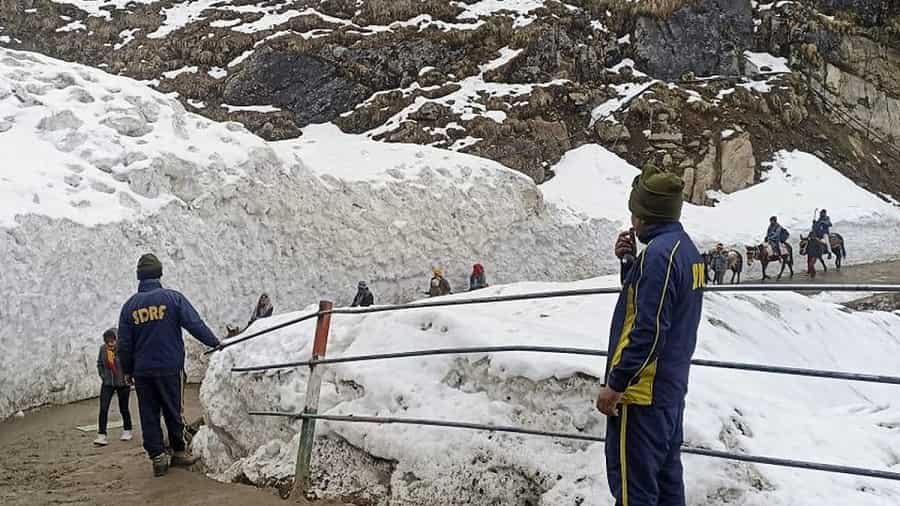
Route Map for Kedarnath Trek
Embarking on the Kedarnath trek, an 18 km journey, is a pilgrimage of both physical and spiritual significance. The expedition commences from Gaurikund, presenting trekkers with an enriching experience in the heart of the Himalayas. The route itself has undergone modifications, a response to the 2013 disaster that wiped away the original path. The new route, outlined below, serves as your comprehensive travel guide for the Kedarnath trek.
1. Gaurikund: To commence this memorable journey, one must first reach Gaurikund. This preliminary step involves a shared taxi ride of approximately 6 km from Sonprayag.
2. Gaurikund to Jungle Chatti: Begin the trek by moving from Gaurikund to Jungle Chatti, a distance of 6 km. This segment involves traversing the Rambara Bridge and immersing oneself in the scenic surroundings.
3. Jungle Chatti to Bheembali: Progress further along the path, covering a distance of 4 km to reach Bheembali. The natural beauty of the region accompanies your trekking endeavor.
4. Bheembali to Linchauli: Continue your journey through the mountainscape, venturing 3 km to arrive at Linchauli. Each step embraces the serenity of the environment.
5. Linchauli to Kedarnath Base Camp: Traverse a distance of 4 km as you approach the Kedarnath Base Camp. The gradual transition in landscape offers trekkers a sense of the grandeur that lies ahead.
6. Kedarnath Base Camp to Kedarnath Temple: The final stretch, spanning 1 km, leads from the Kedarnath Base Camp to the revered Kedarnath Temple. This sacred site, nestled amidst the heights, marks the culmination of your trek and the beginning of a spiritual sojourn.

Facilities at the Kedarnath Trek
Facilities at the Kedarnath Trek cater to both trekkers and pilgrims, offering a range of accommodations, including guesthouses and campsites, to rest amidst the Himalayan splendor. Basic medical assistance and first aid services are available to ensure trekker safety, and local vendors provide nourishing meals to refuel weary adventurers. Additionally, experienced guides are on hand to navigate the trail and enhance the overall trekking experience.
Trail Highlights and Scenic Views
The Kedarnath Trail boasts an array of captivating highlights and breathtaking scenic views. Trekking through dense forests, tranquil meadows, and challenging terrains, adventurers are treated to glimpses of the Mandakini River’s sparkling beauty. The trail’s crescendo is the Chandrashila summit, offering panoramic vistas of snow-clad peaks that leave an indelible mark on the heart. Additionally, the Vasuki Tal glacial lake enchants trekkers with its serene turquoise waters against the backdrop of towering mountains.
Camping and Accommodation Options
Kedarnath holds a distinguished position among the revered shrines dedicated to Lord Shiva and is an integral part of Uttarakhand’s Char Dham Yatra . Once teeming with hotels, lodges, and ashrams in locations like Kedarnath, Gaurikund, and Rambara, providing budget-friendly lodging for pilgrims, the landscape underwent a transformation due to the devastating flash floods in 2013, resulting in the obliteration of all accommodations.
Please note that in response to this, entities like NIM and other aiding authorities have constructed a limited number of budget camps and tents within the Kedarnath region. These endeavors aim to expand the range of accommodation choices for tourists. At present, tourists and pilgrims can exclusively avail lodging at GMVN Tents & Camps, offering a secure and reliable place to stay.
Cultural and Spiritual Significance
Apart from its natural beauty, the Kedarnath Trek holds deep spiritual significance. According to Hindu mythology, this region is believed to be the abode of Lord Shiva, making it an essential pilgrimage for devotees. The journey itself becomes a spiritual cleansing, fostering a deep connection with the divine.
Challenges Faced During the Trek
While the Kedarnath Trek is a rewarding adventure, it comes with its share of challenges. The steep ascents and descents on rocky terrains demand physical stamina and mental determination. Acclimatizing to the high altitudes is essential to avoid altitude sickness, which can cause discomfort. The weather can be unpredictable, ranging from sunny skies to sudden rain or snowfall. Navigating through varying landscapes, such as narrow trails and river crossings, requires careful attention. Additionally, the lack of basic amenities along the route and limited mobile network coverage might test your self-sufficiency. Despite these obstacles, conquering the challenges of the Kedarnath Trek yields a sense of accomplishment and an unparalleled connection with nature.
Safety Measures and Health Considerations
Prioritizing safety and health considerations is paramount when embarking on the Kedarnath Trek. Begin by trekking with a certified guide who knows the trail and can navigate challenges. Stay informed about weather forecasts to prepare for changing conditions. Acclimatize gradually to prevent altitude sickness – stay hydrated, avoid alcohol, and ascend slowly. Carry essential medications and a well-stocked first aid kit. Respect the environment by following the “Leave No Trace” principle, ensuring the trail remains pristine for future trekkers. Finally, communicate your itinerary to someone and stay connected, as mobile network coverage can be limited in certain areas. By adhering to these safety measures, you can enjoy a secure and fulfilling trekking experience.
Packing Tips for the Trek
When preparing for the Kedarnath Trek, strategic packing can make your journey smoother and more enjoyable. Prioritize essentials like sturdy hiking boots for rocky terrains, moisture-wicking clothing to handle varying weather, and a waterproof jacket to combat unexpected rain. Don’t forget to pack a reliable backpack with adjustable straps for comfortable carrying, along with essentials like a first aid kit, energy-packed snacks, a reusable water bottle, and a compact sleeping bag. Trekking poles can provide stability, especially on steep ascents and descents. Lastly, a fully charged camera, sun protection, and a hat are crucial for capturing memories and shielding yourself from the elements.
Exploring Nearby Attractions
While embarking on the Kedarnath Trek, the adventure extends beyond the trail itself, offering the opportunity to explore nearby attractions that add depth to your journey. After paying homage at the revered Kedarnath Temple, consider extending your exploration to destinations like Badrinath, a significant pilgrimage site renowned for its temple dedicated to Lord Vishnu. Rudraprayag, where the Alaknanda and Mandakini rivers confluence, offers a serene atmosphere and a chance to connect with nature. Chopta, known as the “Mini Switzerland of India,” beckons with its captivating meadows and breathtaking views of the Himalayan peaks. These nearby attractions enhance your overall experience, painting a richer picture of the region’s cultural and natural diversity.
Capturing Memories: Photography Tips
As you embark on the Kedarnath Trek, don’t miss the chance to capture the awe-inspiring landscapes through your lens. To truly encapsulate the beauty of the journey, embrace natural lighting – early mornings and golden hours before sunset offer magical illumination. Experiment with different angles to showcase the vastness of the Himalayas, the serenity of the meadows, and the intricacies of the trails. Focus on details like vibrant wildflowers, flowing streams, and rugged terrains to convey the trek’s diversity. Additionally, consider using people in your shots to provide a sense of scale and perspective. Lastly, let the breathtaking views inspire you; tell a story through your photos and immortalize the memories created during this remarkable expedition.
Trekking Solo vs. Group Trek
When considering the Kedarnath Trek, the choice between embarking solo or joining a group trek comes down to personal preferences and desired experiences. Trekking solo offers introspection and a unique connection with nature, allowing you to set your own pace and relish the solitude. It’s a chance for self-discovery and embracing the trail at your own rhythm. On the other hand, a group trek infuses camaraderie and shared memories. It’s an avenue for forming bonds with fellow trekkers, exchanging stories, and enjoying collective triumphs. Group treks often offer organized logistics, easing the burden of planning and navigation. Ultimately, whether solo or in a group, the Kedarnath Trek promises transformative moments and breathtaking vistas, tailored to your chosen path.
Important Points to Keep in Mind Before Going Kedarnath Trek
Embarking on the Kedarnath Trek is an exciting adventure, but thorough preparation is key to ensure a safe and enjoyable experience. Here are important considerations before you begin your journey:
- Physical Readiness: The Kedarnath Trek involves challenging terrain and high altitudes. Make sure you’re physically fit and ready for the demands of the journey. Regular exercise and cardiovascular training can help build stamina.
- Weather Readiness: Weather conditions can change rapidly in the mountains. Pack clothing suitable for both warm and cold weather. Don’t forget rain gear to stay dry during unexpected rain showers.
- Footwear Selection: Invest in sturdy, comfortable trekking shoes with proper grip. Well-fitting footwear prevents discomfort and minimizes the risk of injuries.
- Appropriate Clothing: Layer your clothing to adapt to varying temperatures. Bring warm clothing like jackets, gloves, and hats, as temperatures can drop significantly at higher elevations.
- Important Documents: Safeguard your identification, permits, and relevant documents in a waterproof pouch. These might be necessary at different checkpoints during the trek.
- Hydration and Nutrition: Carry an ample supply of water to stay hydrated throughout the trek. Pack energy-rich snacks such as nuts, trail mix, and energy bars to sustain your energy levels.
- Basic First Aid Kit: Prepare a basic first aid kit containing essentials like bandages, antiseptic cream, pain relievers, and any personal medications you require.
- Communication Plans: Although mobile network coverage might be limited, carrying a fully charged power bank is useful. Inform a trusted person about your trekking plans and expected return date.
- Respect for Local Customs: The Kedarnath region holds deep religious significance. Respect local customs, traditions, and sacred sites. Dress modestly and avoid littering.
- Trekking Permits: Check whether you need permits to access the trekking route. Obtain these permits beforehand to prevent any delays.
- Guided Trek or Solo: Decide whether you’ll undertake the trek with a guided group or as a solo traveler. Guided treks offer expertise and logistical support.
- Altitude Adjustment: Allow your body time to acclimatize to higher altitudes. Take breaks, avoid rapid ascents, and pay attention to your body’s signals.
- Environmental Responsibility: Adhere to the Leave No Trace principles. Carry all your waste back with you and help preserve the natural beauty of the environment.
- Emergency Contacts: Keep emergency contact numbers readily accessible. Be aware of nearby medical facilities and rescue services.
- Travel Insurance: Consider obtaining travel insurance that covers potential medical emergencies and trip cancellations.
Conclusion: A Transformative Experience
The Kedarnath Trek transcends the ordinary, offering an unforgettable blend of adventure, spirituality, and natural beauty. As you trek through the breathtaking Himalayan terrain, you’ll find solace, courage, and a renewed sense of wonder. So, gear up for this life-changing expedition and embrace the journey of a lifetime.
FAQs (Frequently Asked Questions)
- Is prior trekking experience necessary for the Kedarnath Trek? While prior experience is beneficial, beginners with reasonable fitness levels can undertake the trek with proper preparation.
- Are there any age restrictions for the trek? The trek is suitable for individuals in good health. It’s recommended to consult a physician before embarking, especially for senior citizens.
- What’s the significance of Kedarnath Temple? Kedarnath Temple holds immense religious importance for Hindus and is one of the twelve Jyotirlingas of Lord Shiva .
- Are there any wildlife concerns during the trek? While encounters are rare, the region is home to various wildlife species. Trek in groups, make noise, and avoid venturing into dense forests.
- Can I undertake the trek during winter? The trek is not recommended during winter due to heavy snowfall and extreme cold temperatures.
Suggested Tour
- Kedarnath Yatra Packages
- Do Dham Yatra by Helicopter
- Gangotri Yatra by Helicopter
- Exclusive Chardham Yatra by Helicopter
RELATED ARTICLES MORE FROM AUTHOR
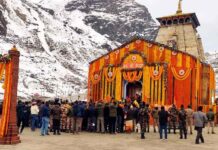
BEST Places to Visit in Kedarnath
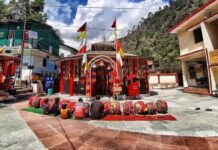
Places to Visit Near Kedarnath
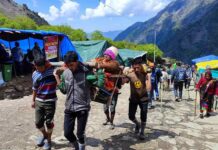
How to Plan Gangotri Yamunotri Yatra from Delhi
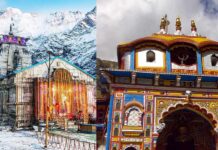
How to Plan Badrinath Kedarnath Dham Yatra from Delhi
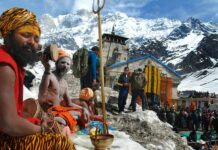
Road Trip from Delhi to Kedarnath

Kedarnath Yatra Registration for 2024

Narmada Jayanti: Celebrating the Sacred Waters
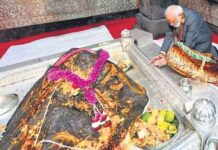
Kedarnath Temple: Rituals, Timings, and Puja Rates

Varanasi Travel Tips for First-Time Visitors
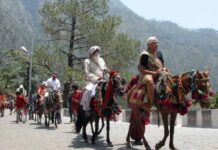
Vaishno Devi Yatra Travel Tips
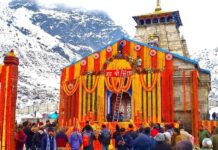
Kedarnath Opening and Closing Dates
Leave a reply cancel reply.
Save my name, email, and website in this browser for the next time I comment.
Recent Post
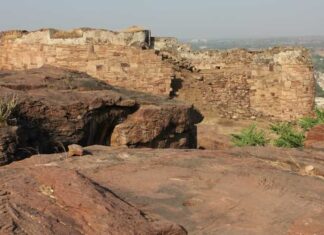
Places to visit in Badami, Karnataka

Best Places to Visit in Hampi

How to Plan Chardham Yatra from Bangalore

Planning a Char Dham Yatra from Surat

Pilgrims to Access Badrinath and Hemkund Sahib via Helicopter

POPULAR POSTS

Asthi Visarjan Places in India You Must Know About

Mahakaleshwar Temple Aarti & Darshan Timings

How to Reach Mallikarjuna Jyotirlinga
Popular category.
- Pilgrimage Destination 38
- Travel Tips 21
- Kedarnath Dham 14
- Chardham 12
- Travel News 10
- Badrinath Dham 10
- Yamunotri Dham 9
- Vaishno Devi Temple 8
- Gangotri Dham 8

Kedarnath Trek and Yatra – Where, What & How? All the information you need
Treks & hikes , Uttarakhand
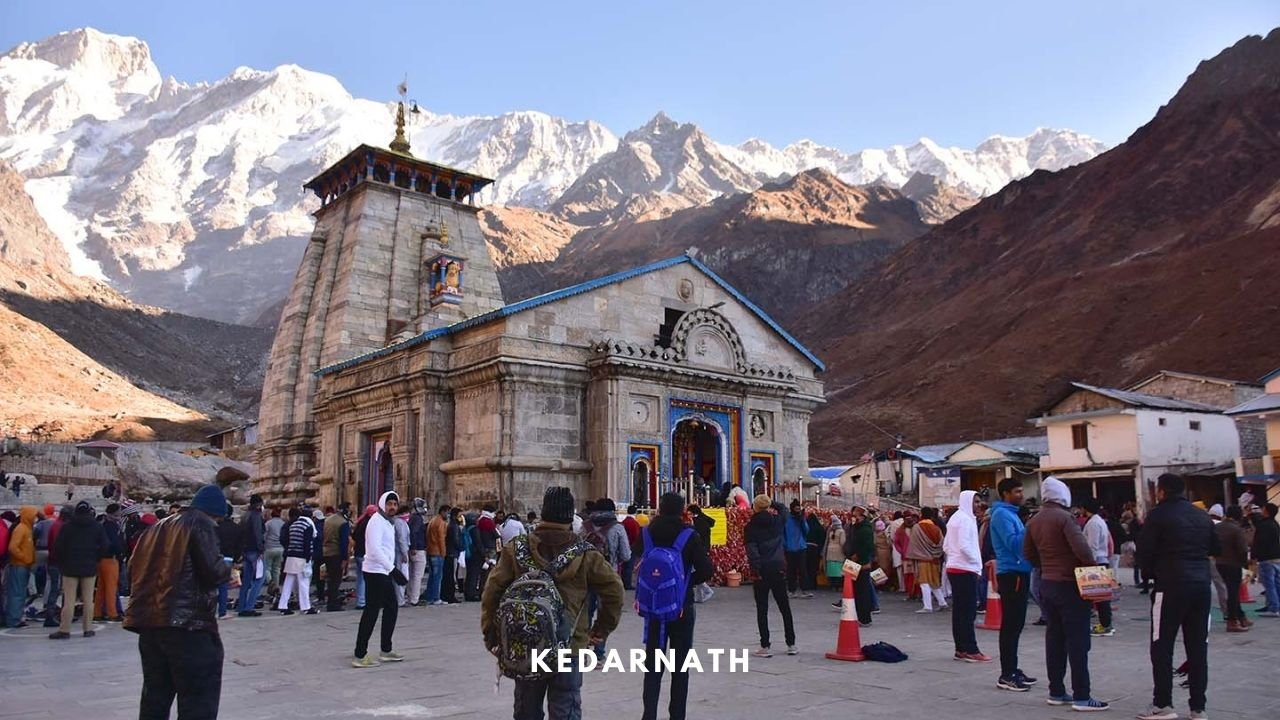
Last Updated on: May 20, 2023
About this Blog: Kedarnath Yatra is one of the most spiritual pilgrimages in India. Kedarnath, the abode of Lord Shiva attracts thousands of devotees within a span of 6 months when the shrine remains open. Kedarnath is a part of the sacred Char Dhams (4 pilgrimages) as well as a part of the Panch Kedars . This blog is about our experience of the Kedarnath Trek done in the month of October. Read on to know more about Kedarnath Yatra, how to reach and where to stay and other related information.
Kedarnath is not just a place of pilgrimage for me. The place has much more significance. It was the first place that I had ever travelled with my family. I do hear every now and then that I had been a very difficult 2-year-old during that time who gave a tough time to my parents. Well, what else to expect from a toddler! Now after almost three decades, I was again ready for Kedarnath Yatra again with Agni in tow. Only this time, we decided to go on foot from Gaurikund and I was quite excited about the Kedarnath trek.
This trip was going to be a special one, not for a singular reason. To be honest, I was way too excited to visit a place that has such nostalgic memories for me. The moment we told our families about this trip, my father started telling me stories about “that” Kedarnath Yatra that happened almost 30 years ago. By stories, he meant all the embarrassing episodes of a two and a half-year-old on a trip with the family. It seemed he divulged all my idiotic secrets to my husband, who of course, did not forget to tease me later.
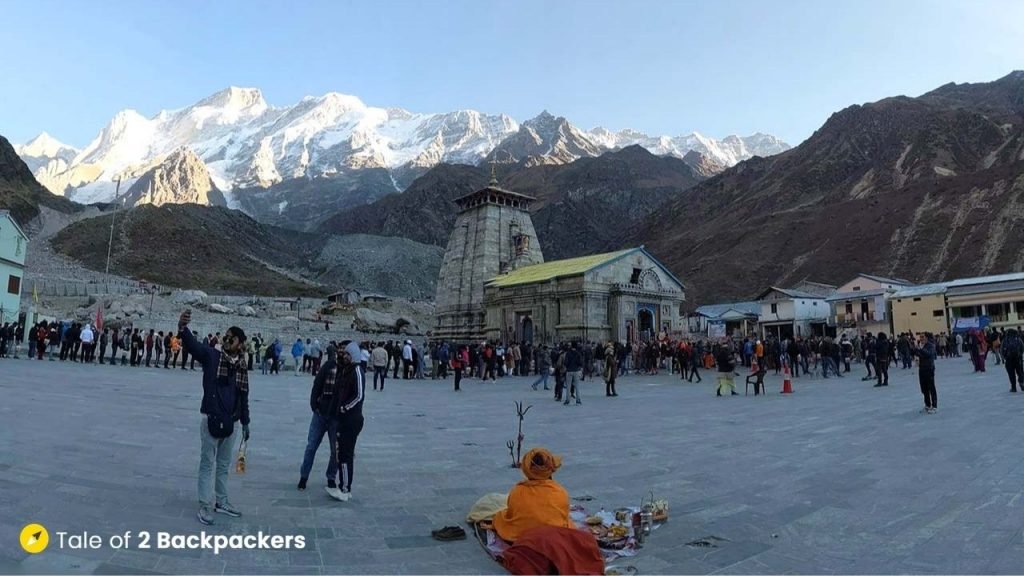
My uncle was quite excited to know we were visiting Kedarnath and Badrinath. He recalled all the special places and even told me to take pictures in the same pose as we had done previously. So much for changes! Overall, going to Kedarnath was exciting not only for us, but also for my family.
For Agni and me, Kedarnath trek was important because we were again trekking the Himalayan trails after almost 2 years. All these years, we had done a few short treks in the Western Ghats and the David Scott Trail in Meghalaya. We thought Kedarnath trek might be the catalyst that would overcome the drought in our trekking trips. After all, it was after Amarnath Yatra that we had fallen for trekking! So enough of my ramblings, let us start with all the information you wanted to know about Kedarnath Yatra, Kedarnath Temple and of course our amazing experience there.
Where is Kedarnath located?
Kedarnath Dham is a part of the Char Dhams Yatra (4 religious places) that also includes Gangotri, Yamunotri and Badrinath. Located in the Rudraprayag district of Garhwal region in Uttarakhand, the Kedarnath temple is located in the Kedar valley below the Chorabari glacier, which is the source of the river Mandakini.
Kedarnath – History, Legend and Stories
It is usually an obsession with me to find out about the past of any place that we visit, especially if the place happens to be a historical and religious place. For temples in India have numerous stories hidden in them. I did the same for Kedarnath.
It is believed that the Kedarnath shrine was buried under the snow for almost 400 years!
Like others, Kedarnath also has its fair share of mythologies and legends. There are various versions on the origin of the Kedarnath Temple. While there are claims that the temple was resurrected and built by the great Hindu seer Adi Shankaracharya in the 8th century while others claim that it was built by the Hindu King Raja Bhoj of Malwa in the 2nd century AD. Well, as I said before, there are numerous versions.
Kedarnath finds mention in the great Hindu epic Mahabharata and this is where the legend of Panch kedar comes in. Did I mention before that Kedarnath is also one of the five (Panch) Kedars, the five holy places of Lord Shiva.
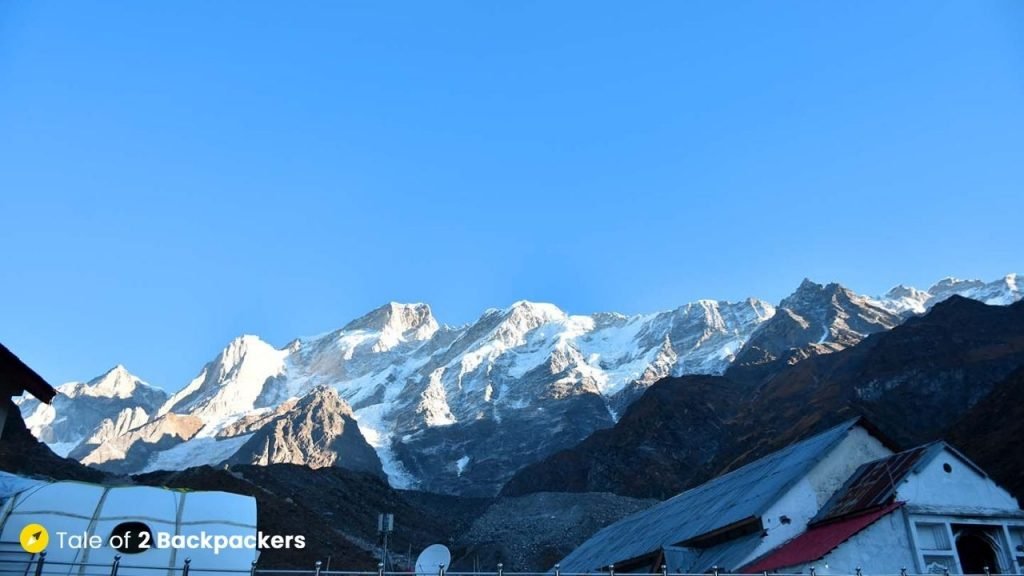
In the epic battle of Kurukshetra where the brothers fought against each other, the Pandavas defeated and killed their cousin brothers Kauravas. The Pandavas killed their own in the battle and were inflicted by self-remorse and guilt. They decided to ask for forgiveness from Lord Shiva, the master of the Universe. With this thought in mind, the Pandavas decided to go to Kashi to ask for forgiveness from God. Lord Shiva, on the other hand, was not too keen on forgiving the Pandavas for their carnage. He left his abode at Kashi and hid as a bull at Guptkashi. Bhima, the strongest of the Pandavas, however, was able to find Lord Shiva in the form of a bull. The bull again escaped and later rematerialized at five places and these 5 places came to be known as the Panch (five) Kedars.
Different parts of the bull materialized at different locations – the hump at Kedarnath, the arms at Tungnath , the navel and stomach at Madmaheshwar, the face at Rudranath and the hairs at Kalpeshwar. It is believed that the Pandavas had built temples at all the five locations and were freed of their sins. It is also believed that the front portion of the bull fell at Pashupatinath in Nepal. The Pandavas built temples at all five locations. It is believed that the Pandavas performed Yagna at Kedarnath before they left for Mahaprasthana (renouncing the world to attain salvation). Incidentally, the Mahaprasthana started from Mana village near Badrinath. That story is for some other time.
There is another story where Nara-Narayan, a Hindu deity worshipped Lord Shiva and Goddess Parvati. He prayed to the Lord and asked him to stay at Kedarnath for the wellbeing of the human beings. Lord Shiva granted him his request and thus Kedarnath became the abode of Lord Shiva.
The Floods of 2013
Kedarnath is also now known for the devastating floods that occurred in the Garhwal region of Uttarakhand in 2013. Surprisingly the Kedarnath Temple was one of the few structures that remained unscathed during the floods.
If the mythology is to be believed, then the temple was perhaps built almost 3000 years ago. However, there are inscriptions of the wall of the temple that dates towards a period in between 650 – 850 AD. How the temple withstood the ravages of the flood has been an area of interest for researchers. The reason is apparently related to the glaciers of the region and the lichens grown there.
Ravinder Kumar Chaujar, a retired professor from Wadia Institute of Himalayan Geology, Dehradun, studied lichens growing on the rocks of Chorabari’s moraines to determine the geological history of the place. Professor Chaujar found that the temple had remained submerged in ice or in the glacier for at least 400 years. This was perhaps one of the reasons for the resilience of the temple. It remained unharmed in the 2013 floods and will perhaps survive further such episodes of flooding.
Kedarnath Trek – Our Experience
As I have mentioned before that we decided to go on foot all the way to Kedarnath from the base point at Gaurikund. The journey started from Haridwar. Local buses from Haridwar to Guptkashi were very few because of the post-pandemic situation. So we rented a car for 5 days for a trip to Kedarnath and Badrinath.
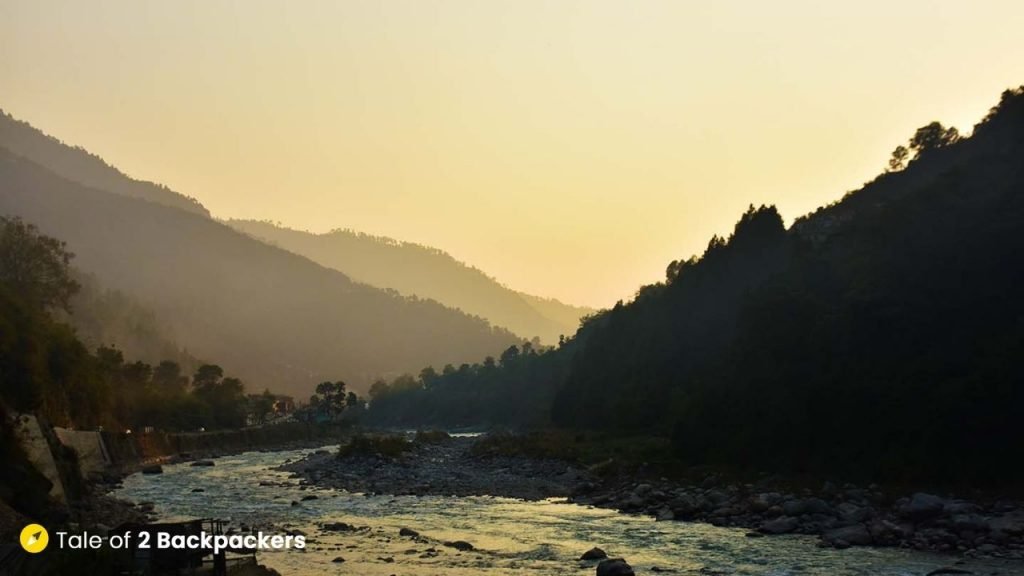
We started early in the morning from Kedarnath and passed through the winding mountain roads. We had been to these parts a few times, but the scenery never failed to enchant me. The meeting of Mandakini and Alaknanda Rivers at Rudraprayag still makes us wistful of the unadulterated beauty of the mountain rivers.
The Mandakini River was our constant companion throughout the road to Kedarnath. We reached Guptkashi at around 3 PM and then decided to travel to Sonprayag. There are a number of hotels at Guptkashi and is one of the places to stay for the night if you reach late.
We reached Sonprayag soon and found a hotel to stay for the night. We found a number of hotels at Sonprayag well but the majority of them were closed. It seemed this season the number of pilgrims were lesser than previous years, the reason being obvious.
Earlier, Sonprayag was the starting point of Kedarnath Yatra. But now, a motorable road upto Gaurikund has been built and the 5 km distance from Sonprayag to Gaurikund can be travelled by a shared jeep.
We started quite early in the morning. Once we were at Sonprayag, we headed towards the Yatra Registration Counter. To conduct the Chardham Yatra in a controlled manner after the flash floods of 2013, the number of Yatris (pilgrims) visiting the Kedarnath shrine is regulated. Yatra registration can be done online and you get an e-pass. You can do it yourself or ask your agent to do it for you. There is also a counter for getting the Yatra e-pass at Sonprayag. A man was sitting with a laptop and was making the Yatra e-pass for a fee of Rs.50/-.
We had our Yatra e-pass with us and went to the Registration Counter directly. They recorded the e-pass number, did thermal screening and we were given the permission to start our Yatra. Every year, the pilgrims get a physical pass as well. We did not get it this year, perhaps because of the lesser number of pilgrims.
Sonprayag – Gaurikund
As soon as we got ourselves registered for Kedarnath Yatra, we walked towards the jeeps standing for taking the yatris to Gaurikund. We got our seats in the jeep and were soon at Gaurikund. The jeep fare was Rs30 per head.
The Kedarnath trek route starts from Gaurikund and concludes at Kedarnath covering a distance of 16km. The trekking route had changed and rebuilt after the flash floods of 2013. The old trekking route has now given way to a better and wider trekking trail.
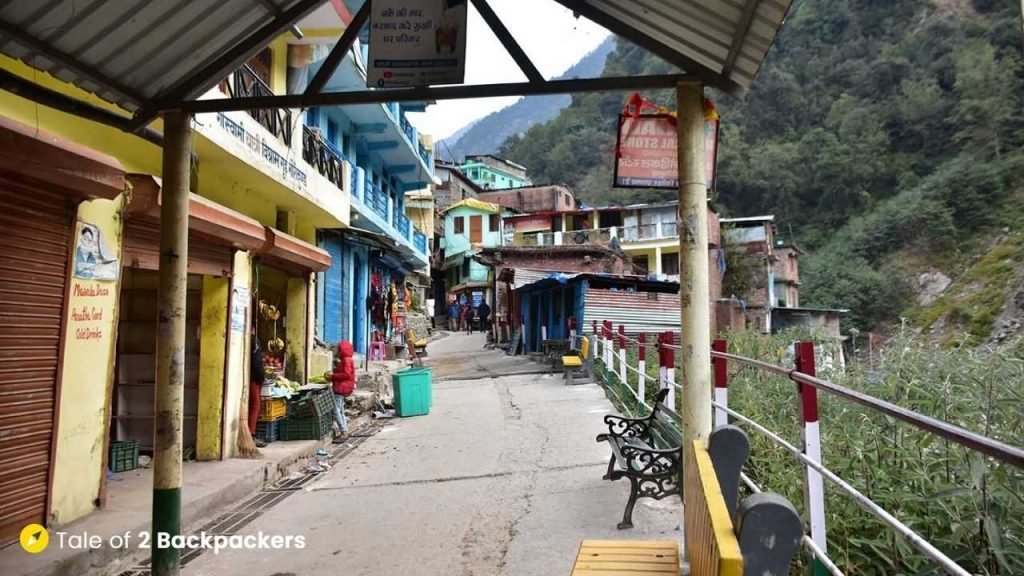
Kedarnath Trek Starts
The trek starts at Gaurikund. “Kund” literally means a reservoir and Gaurikund has a hot water spring where the pilgrims usually have a bath before embarking on the Yatra. The hot spring no longer exists after the floods of 2013. Now, there is a huge enclosure where pilgrims can take a bath.
Gaurikund is also known for the Gauri Temple dedicated to Goddess Parvati. Close to the Gauri Temple is the Uma Maheswar Temple where Lord Shiva is worshipped in the form of a rock.
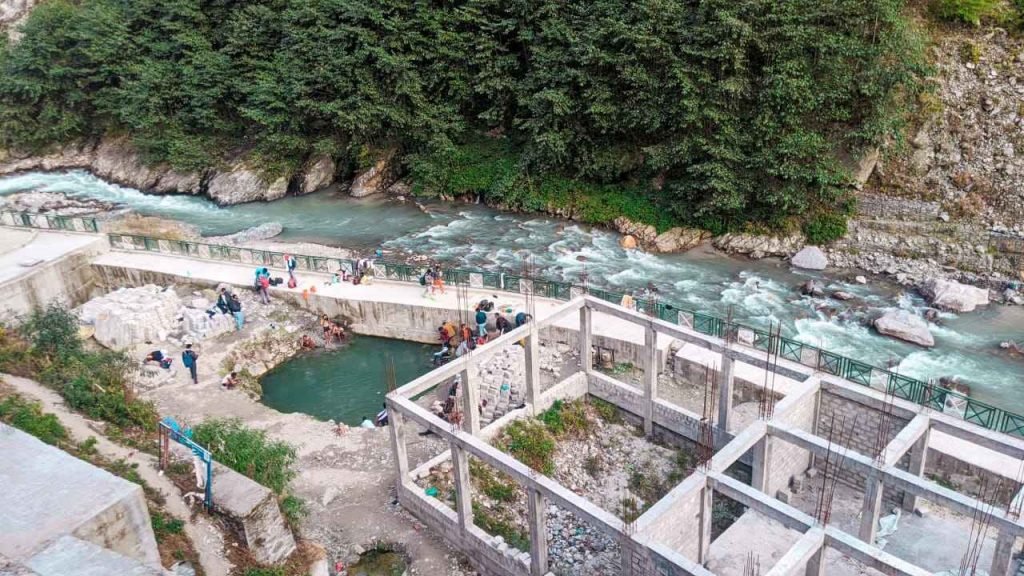
Gaurikund is congested and there are a number of shops catering to all the needs of the travellers. There are a number of accommodation facilities as well at Gaurikund.
We started from Gaurikund at around 8 AM. The Mandakini River was gushing down with beauty and spirit. As much as I wanted to stay there and admire the sprightly river, we had to start our trek towards Kedarnath Temple.
About half a kilometer from the starting gate, is a booking office for horses, mules and palkis and Pitthus . Pitthus are basically men carrying the pilgrims on their back. Usually very old and young pilgrims take the service of Pitthus . There is a fixed rate for mules and Pitthus . You can book them from here. However, you will find mules almost entirely through the trail.
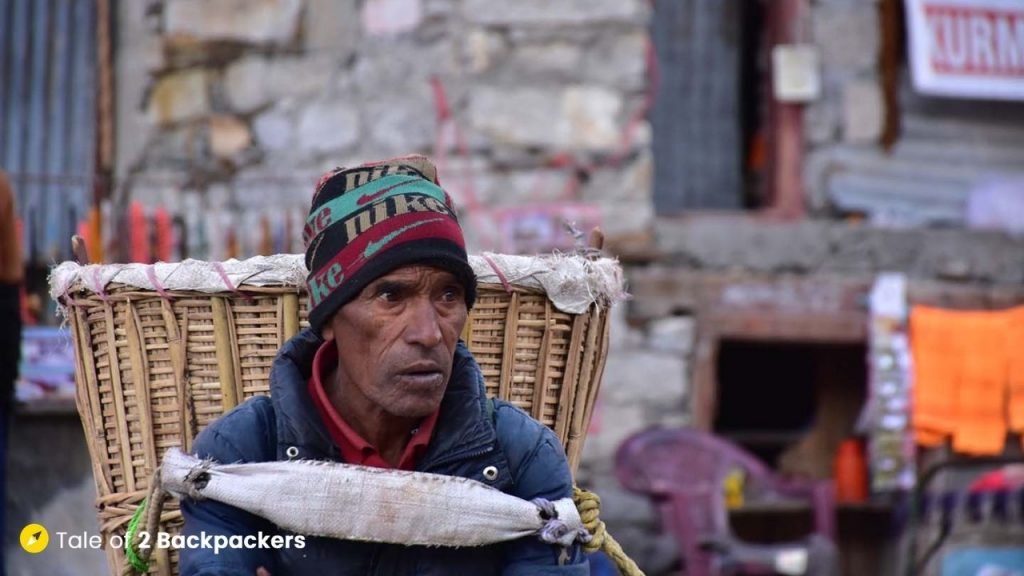
After a kilometer of trekking comes the Horse Point (Ghoda Pul) or the place from where you can get on your horses or mules to carry your journey. The horses are allowed from this point only. Upto this place, the trail is quite crowded with horses, mules and their owners. And don’t you forget, they will constantly ask you to get a mule for the journey! I had been told at least 15 times that I should take a horse to Kedarnath.
We trekked along the well-made trail. As usual, very soon we were quite tired and panting. Our legs were screaming for respite. Well, this is what happens if you are out of any fitness regime and had not trekked for almost a year! Nevertheless, we continued to trek. Though I must admit that there were a couple of moments when I felt that I should have hired a mule.

The next significant stop on the trail is the Bheembali. The trekking route bifurcates at Bheembali – one for the trekkers and the other specially designated for horses and mules. Both the trails finally meet after Rambara.
Rambara was once one of the biggest settlements in the Kedarnath trek route. The floods of 2013 had completely wiped off the settlement. What remains now is the debris of the old trekking route which was pointed to us by a local shopkeeper. It is also here that we see the Mandakini River flowing down with force through the gorges.
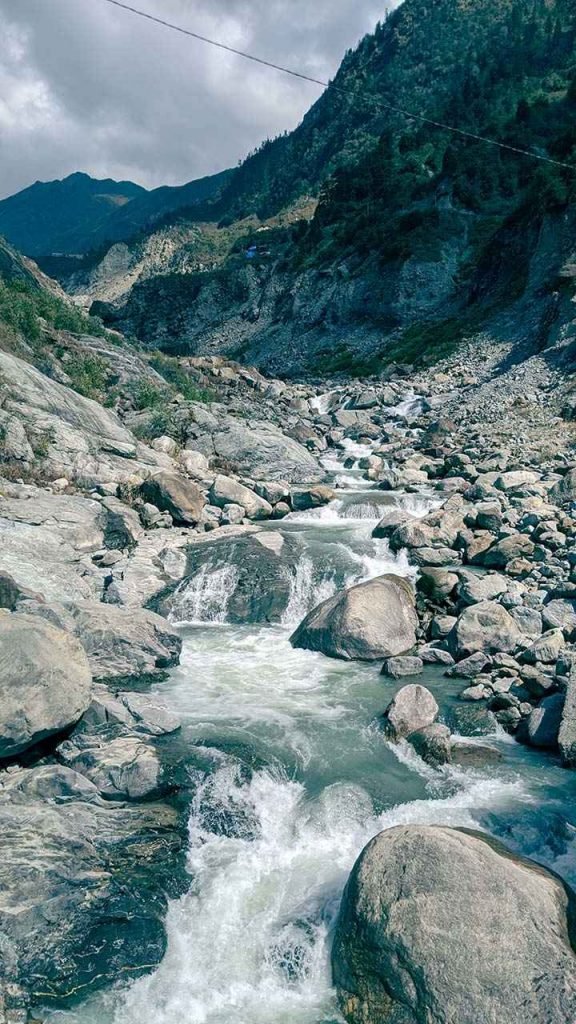
The older route to Kedarnath was through the left of Mandakini River and that route is now completely destroyed. The new route has now been constructed at the right side of the river. A few more minutes of trekking and we reached Chhoti Lincholi. It was almost 12.30 PM at that time and we decided to take a lunch break there. This place can be roughly said to be the midpoint of the trail.
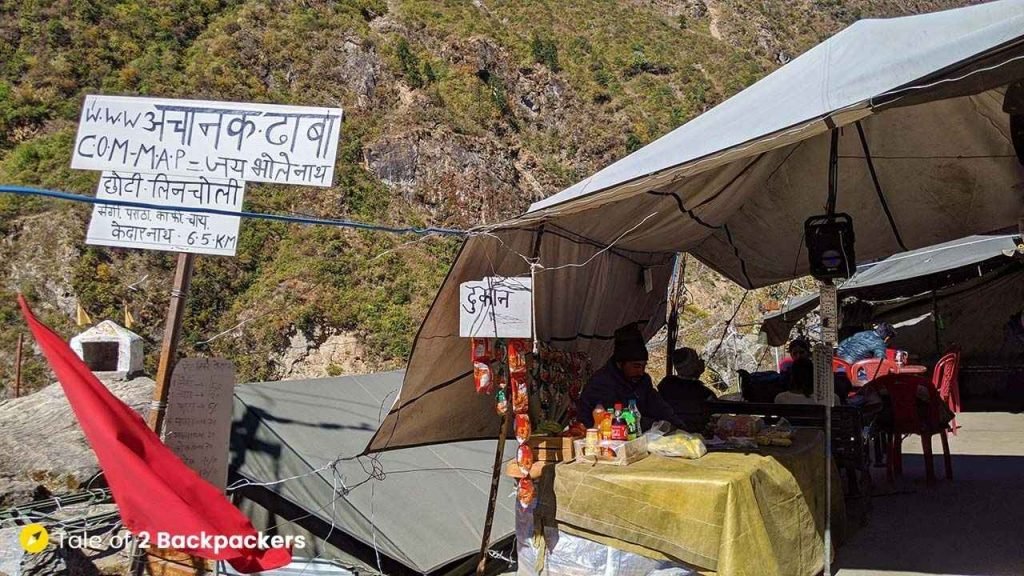
We had a good lunch of alu paratha at Chhoti Lincholi and were quite ready for our next stretch of the trek. And it was then, something sort of a miracle happened. It started snowing! Well, not exactly all the big snowfall, but we could see the snowflakes on the tents and on us.
To be honest, it was a bright and sunny day when we started. The snowfall made all the people quite happy and a group started singing a local song. We were told that it was the second snow of the season and all the locals were quite happy to see the snow. We enjoyed the snowfall for almost half an hour after which it stopped.
The snowfall might have had us gushing like diehard romantics, but it definitely made the trail a bit difficult for us. We were already late for more than an hour and the weather became chilly. It was a lazy start after lunch and snowfall and gradually we trekked our way towards Kedarnath.
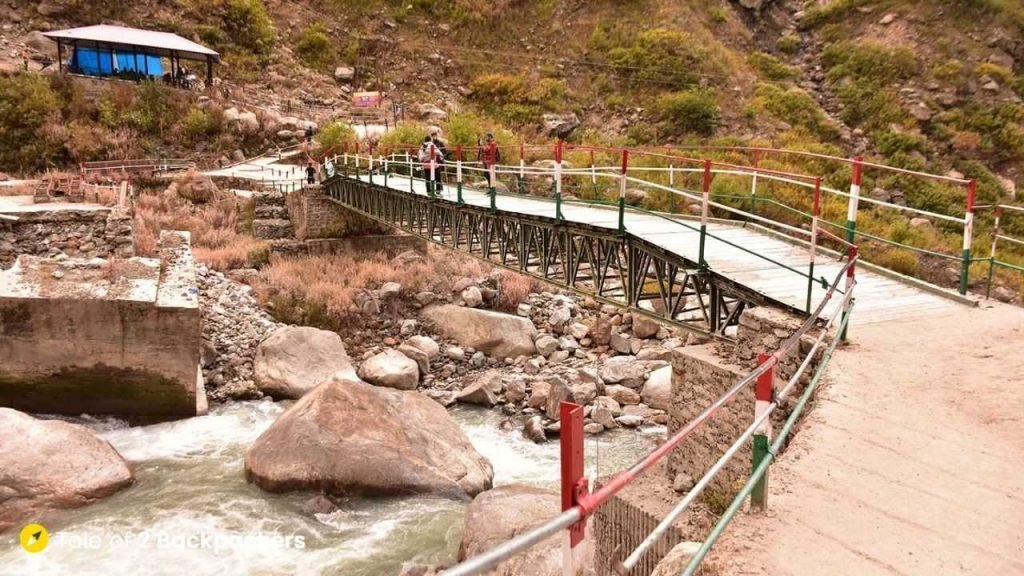
Finally, we reached Lincholi. There are a few accommodation options at Lincholi. You can stay here for the night. Kedarnath is about 6 km from Lincholi. As much as we were tempted to stop at Lincholi, we decided to trek all the way to Kedarnath. After trekking for another hour, we reached Kedarnath Base Camp.
There is a GMVN Guest house and cottages at Kedarnath base Camp. Kedarnath shrine is another 500 m from here. There is also a check post here where they check the registration slips. They only ask for the e-pass numbers and really do not check any slips. We trekked towards the shrine and finally we reached there at around 4PM. Once we reached Kedarnath, we tried to look for a place to stay. There are a number of places to stay near the shrine, mostly dormitories. We finally chose to stay at Bikaner House just behind the Kedarnath Temple.
We were quite in time for the evening Aarti at the Kedarnath Temple. The Aarti starts at 5.30 PM. After watching the Aarti, we went to our guest house, had our dinner and simply snuggled into our sleeping bags.
Kedarnath Temple – the end of the trek
We awoke early the next morning and went to visit the Kedarnath Temple. This time we saw the temple in all its glory. The main temple of the Kedarnath remained unscathed in the floods of 2013.
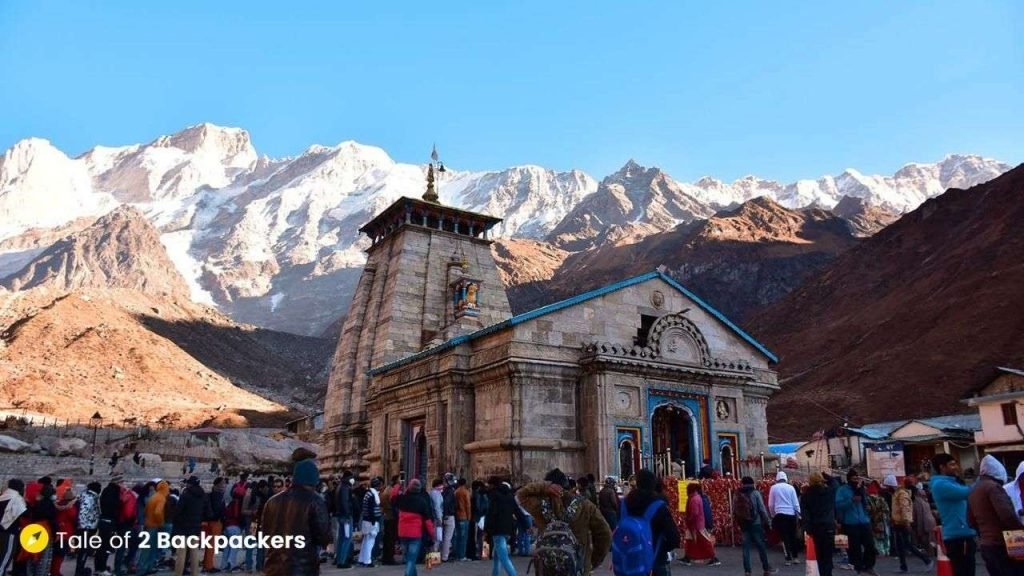
The interior of the temple is a bit dark. There are statues of the five Pandava brothers and Draupadi, their consort. Inside the main hall, there is a conical shaped stone that is said to be the hump of the bull that Lord Shiva transformed into (remember the story I mentioned before). There are statues of Lord Shiva and a few other deities inside the main hall as well.
We offered our prayers in the temple and then roamed around the place for some time. I had a few old pictures when I had visited Kedarnath Temple almost 3 decades back. I tried to connect the places with that of those pictures. Obviously, the place had changed, but the temple had remained intact.
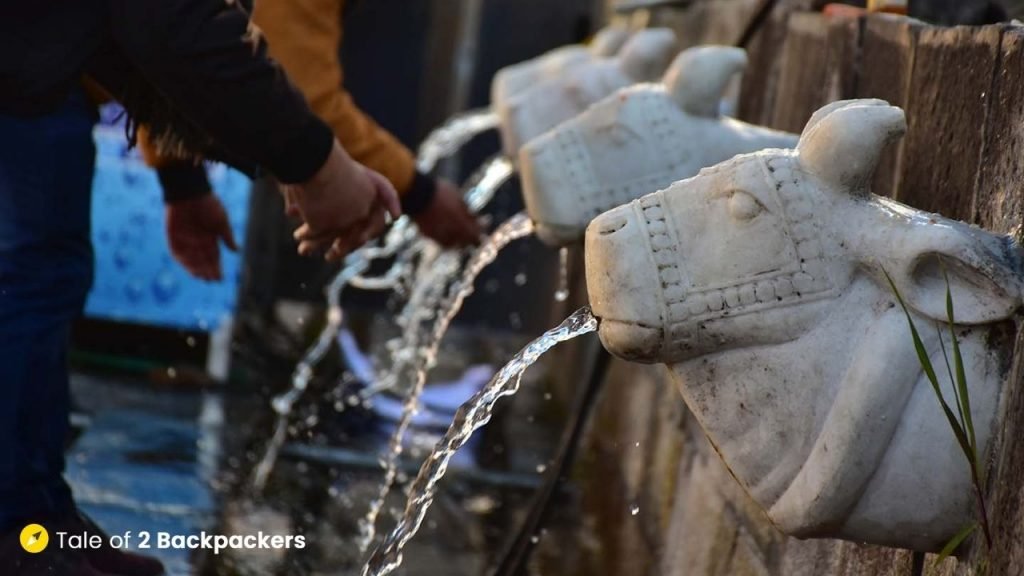
Outside the temple, there is a statue of Nandi, the bull facing the temple. The entire place looks quite beautiful with the snow-covered Kedarnath peak (6940 m or 22,769 ft), the Kedar Dome (6,831 m 22,411 ft) and other peaks surrounding the temple on three sides.
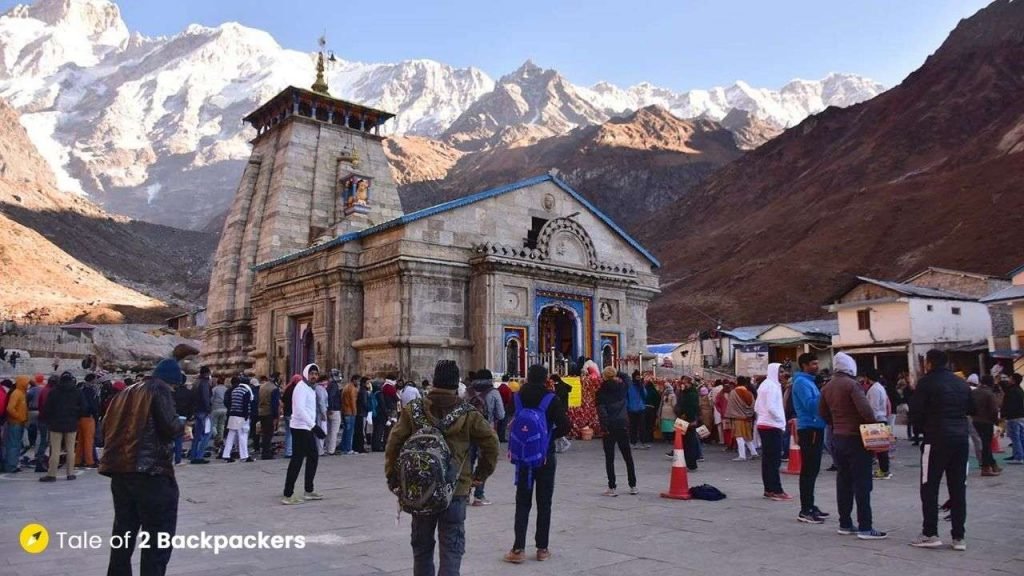
Just behind the temple is a huge rock known as the Shri Divya Bheem Shila. It is believed that this stone had protected the temple from the waters of the flood in 2013. When the waters of Gandhi Sarovar carried large chunks of moraines and stones, this huge stone boulder tumbled down and anchored just behind the temple. This rock then diverted the flow of water to the sides and the temple remained intact.
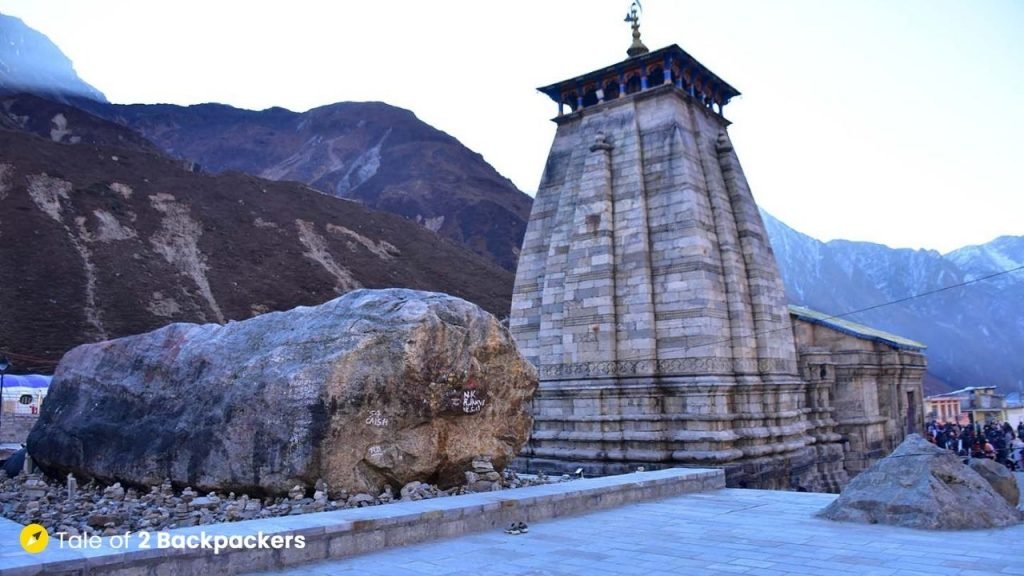
You will invariably feel calmness at this place. All around the temple, you will see many ash-smeared saints and sadhus sitting with a trident (Trishul). They seem to be in a world of their own. It is quite interesting to see these sadhus all around the temple, sometimes singing while at other times having a pot of marijuana.
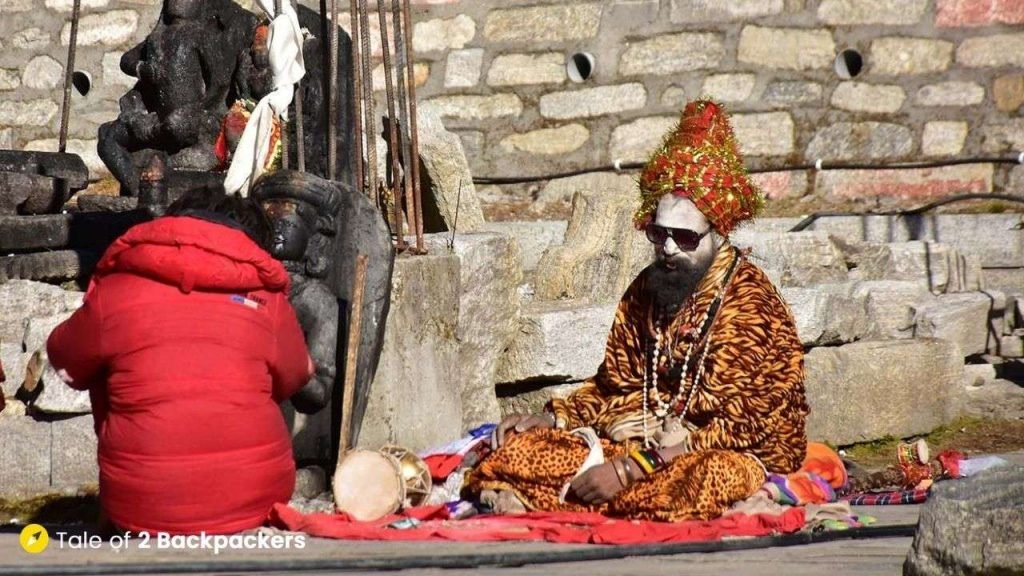
After spending some time around the Kedarnath Temple, we started our return journey towards Gaurikund at around 8.30 AM. We descended to Gaurikund after taking occasional breaks and reached there by 2 PM. Our car had been waiting for us at Gaurikund. We continued our journey towards Guptkashi and decided to stop there for the night before continuing our journey towards Badrinath. Our visit to Badrinath remains for the next story.
Kedarnath Temple Timings:
The temple remains open from 4 AM to 9 PM everyday.
All that you need to know about Kedarnath Trek and Yatra
How to Reach Kedarnath?
Jolly Grant Airport near Dehradun is the nearest airport and is located about 235 km from Kedarnath. Taxis are available from the airport to Sonprayag.
The nearest railway station to Kedarnath is Haridwar or Rishikesh. From Haridwar and rishikesh, you will get direct buses to Guptkashi and Sonprayag. But these buses are few in number. You can check online bus sites to see the time of the buses. Buses to Guptkashi, Karnaprayag, Gopeshwar are now available from Delhi (ISBT) as well.
You can also hire a car to reach Guptkashi or Sonprayag. However, it is better to book a car for both Kedarnath and Badrinath or the entire Char Dham Package. The cars charge a lot more if you only ask them to drop at Sonprayag.
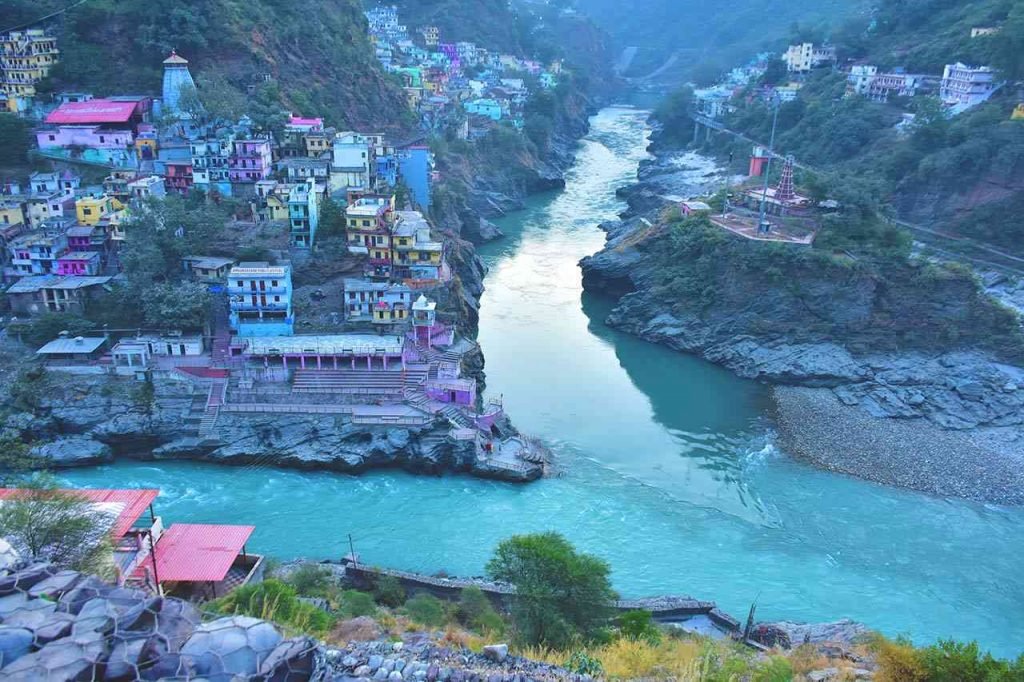
We had hired a car for 5 days to visit Kedarnath and Badrinath and it cost us about INR 11,000 for the 5 days (which I do consider to be cheap). We also stopped at Tungnath and Chopta on the way from Kedarnath to Badrinath.
If you are driving by your own car, you can follow the route:
Haridwar – Rishikesh – Pipalkoti – Devprayag – Srinagar – Rudraprayag – Agastamuni – Guptkashi – Phata – Sonprayag
Sonprayag has a huge parking space where you can keep your car for the night. The Registration centre for the yatra is just a few metres ahead of the parking space.
The distance between Sonprayag and Gaurikund is about 5 km. You can start the trek from Sonprayag or else take the shared jeeps to Gaurikund. The jeep fare is INR 30 per head. The stretch of road from Sonprayag to Gaurikund is quite bumpy and rough.
Gaurikund serves as the base camp for the Kedarnath trek.
From Gaurikund, you can either trek or ride horses/mules to Kedarnath.
Kedarnath on foot (Kedarnath Trek)
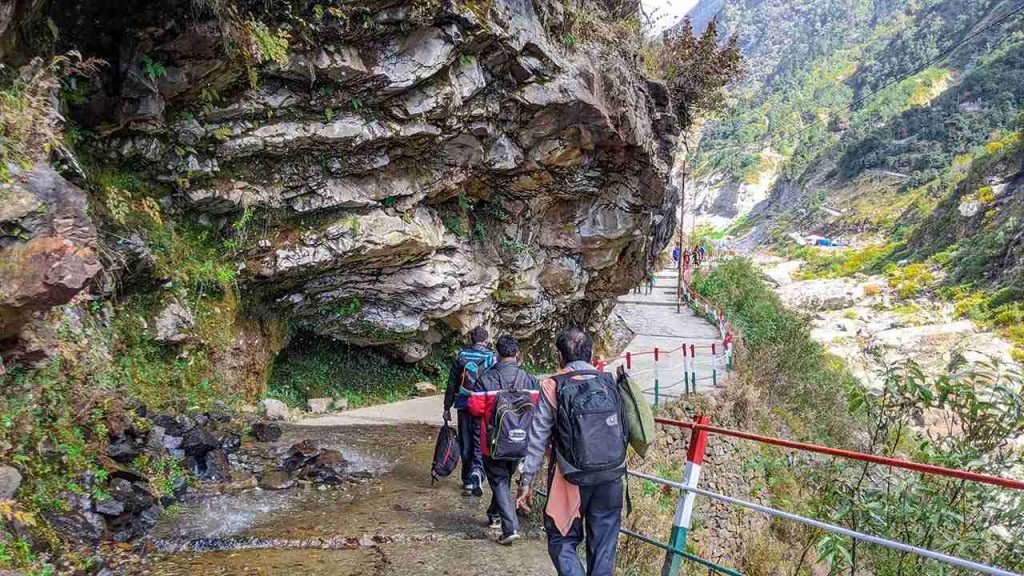
The total trekking distance from Gaurikund to Kedarnath Temple is about 16-17 km.
Kedarnath Trek Route
- Gaurikund – Jungle Chatti (4 km)
- Jungle Chatti – Bheembali (3 km)
- Bheembali – Lincholi (4 km)
- Lincholi – Kedarnath base camp (4 km)
- Kedarnath base camp – Kedarnath temple (1 km)
The entire trail can be covered in a single day on foot. There are a few accommodation facilities in the middle.
Kedarnath by Horses/ Mules and Pitthus
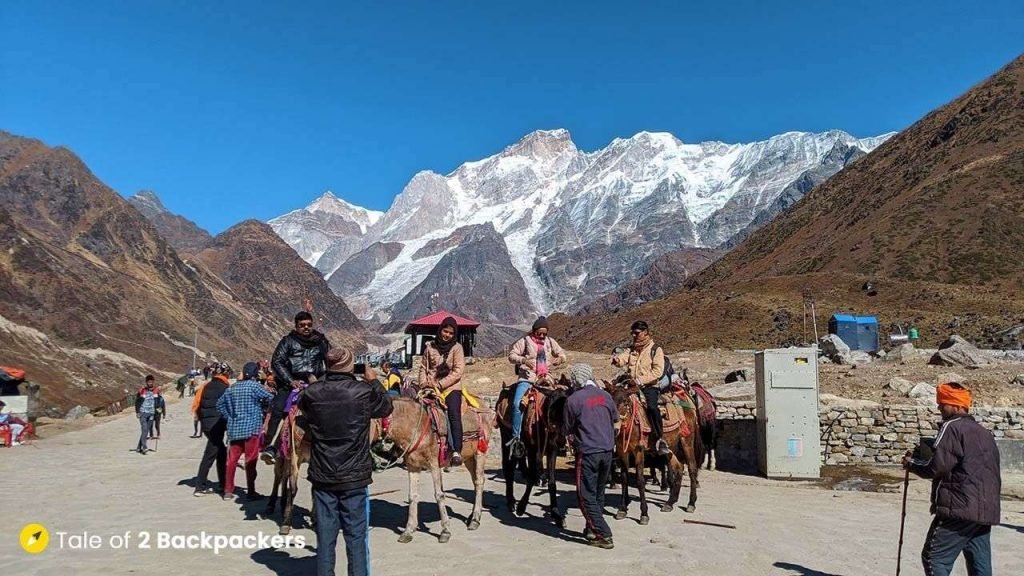
Horses, palkis , kandis and Pitthus are available from Gaurikund to Kedarnath. There is a booking office just before the starting point of the trek from where you can get them. There is a fixed rate for horses and mules. The rate for pitthus and kandis vary with weight. While you will get them easily at Gaurikund, you will also get them on the way.
Tip on riding horses/mules: Bend forward while climbing upward and bend backward while climbing down and hold the saddle tightly.
Kedarnath by Helicopter
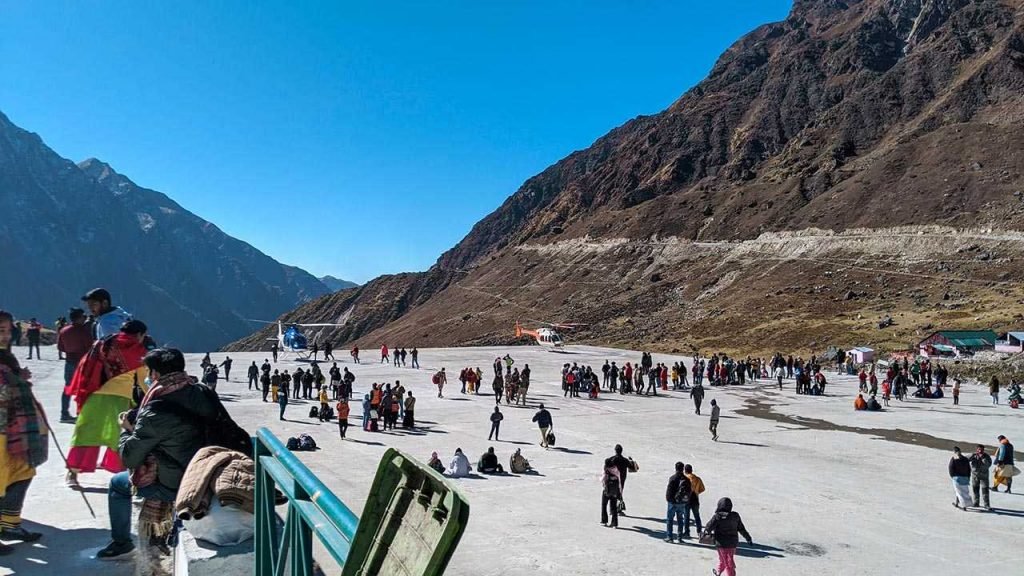
These days many people travel to Kedarnath by helicopter as well. The helipad is at Phata located between Guptkashi and Sonprayag. We found a couple of different operators providing helicopter services to Kedarnath. While Phata is the main place from where you can get helicopter rides, other helipads are found at Sersi and Sitapur. The helicopter would take you to Kedarnath Base Camp, about 1 km from the Kedarnath Temple. This distance has to be covered by foot. Even horses are not allowed beyond a certain point.
Things to remember for Helicopter ride to Kedarnath
- The helipads are at Phata, Sersi and Sitapur.
- Only 2 kg of luggage is allowed per person.
- Additional charges are levied if you weigh more than 80 kg and above 120 kg, 2 seats need to be booked.
- The price of the tickets depends on the helipad you are flying from. Usually a round trip cost somewhere between INR 5000 to 7000.
- If you get the round trip ticket for the same day, then they usually allot 2 hours to visit the temple and come back to the helipad.
- It takes roughly around 10 minutes to fly to Kedarnath Base Helipad and from there it is an easy trek of 15-20 minutes to the Kedarnath Temple.
- Helicopter services might stop at any time due to bad weather conditions.
Where to stay at Kedarnath?
There are plenty of hotels and guest houses at Sonprayag as well as Gaurikund. GMVN Guest Houses are also available and you can book them online.
GMVN Guest House and cottages are also available at Kedarnath Base Camp. There are a number of guest houses and dormitories available near the temple as well. We stayed at Bikaner Bhawan just behind the temple.
Accommodation options are also available on the way to Kedarnath. GMVN Guest Houses are available at Jungle Chatti, Bheemabali and Lincholi. Online booking is available at these guest houses and I would recommend you to book them beforehand if you opt to stay in between.
We stayed at Bikaner Bhawan in a double-bed room which cost INR 2000. Hot water is also available and a bucket would cost you around INR 60 – 70.
The rates of the guesthouses and hotels near the Kedarnath temple can change randomly. We would recommend you to book your stay beforehand if you are visiting with family.
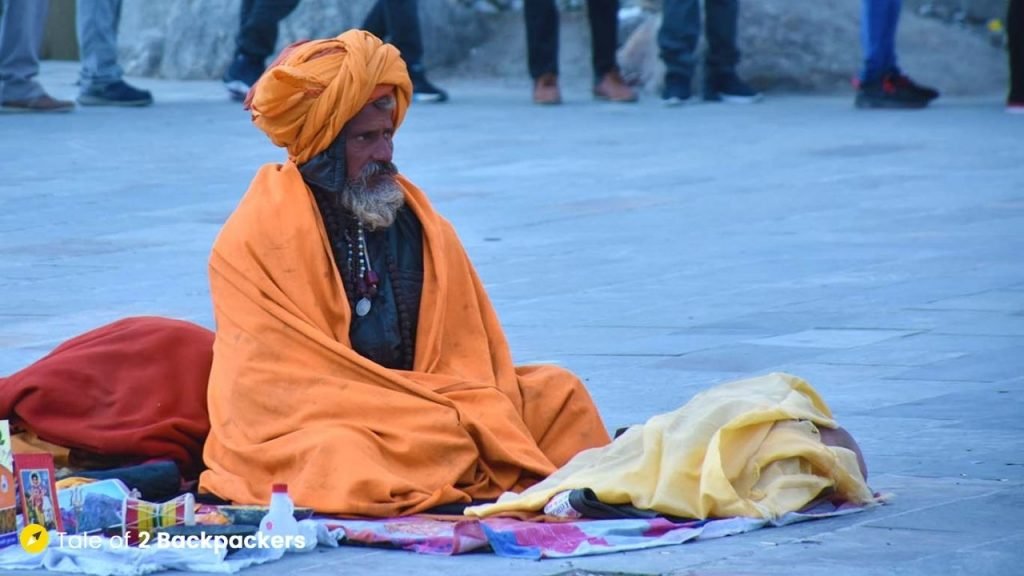
Medical facilities on Kedarnath Trek
Medical centres and facilities are available throughout the way. You can find them in between Jungle Chatti, Bheemabali and Lincholi.
Food, Drinks, Shops and Restaurants on Kedarnath Trek
Most of the hotels, guest houses and GMVN Guest Houses provide food at reasonable prices. The food available is vegetarian and quite tasty. There are many shops available all through the trek route selling Maggi, parathas, snacks and hot beverages. You will definitely not go hungry on your trek to Kedarnath.
Toilet Facilities on Kedarnath Trek
Make-shift toilet tents are available on the way at various places in the trekking route.
Is there Mobile and Internet Service at Kedarnath?
Mobile services are available at Gaurikund till Lincholi. However, it is a bit rough at Kedarnath. We found Jio and Airtel services at Kedarnath while there was no mobile service for Vodafone.
Free wifi is available at the main areas like Jungle Chatti, Bheemabali, Lincholi and Kedarnath. However, do not rely much on the free wifi services. We did not get any during our stay at Kedarnath.
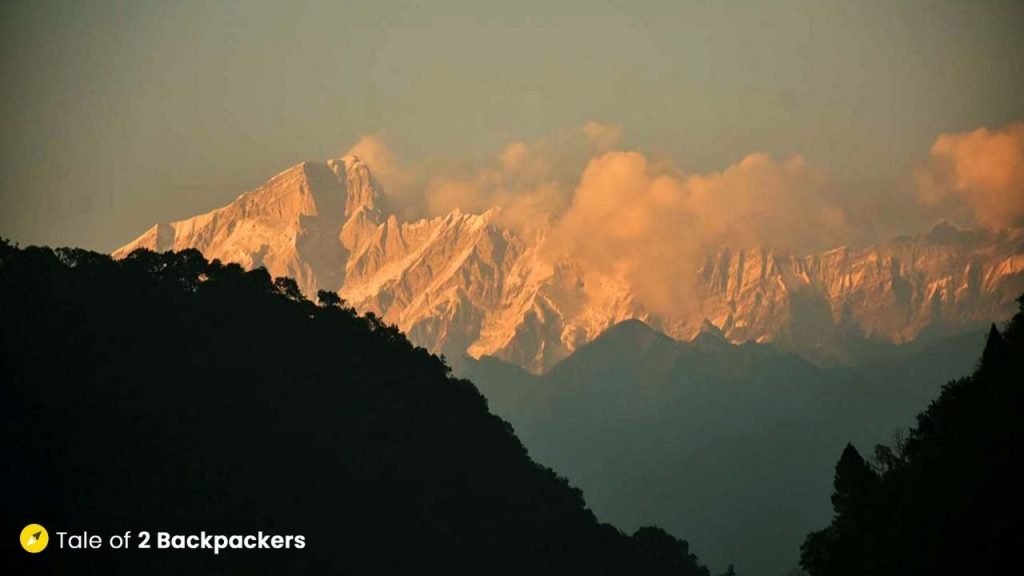
When is the best time to visit Kedarnath Temple ?
Kedarnath is a part of the Char Dham Yatra. The temple opens on the auspicious day of Akshay Tritiya (usually falls in April or May) and closes on the day of Bhai Dooj (falls in October or November). Kedarnath Dham can only be visited during this time.
Kedarnath is located at an altitude of 3553 m and remains cold most of the time. The weather is quite unpredictable in the mountains. Usually May to June and October to November is a good time for Kedarnath Trek. July to September are the monsoon months and there are chances for landslides during this time.
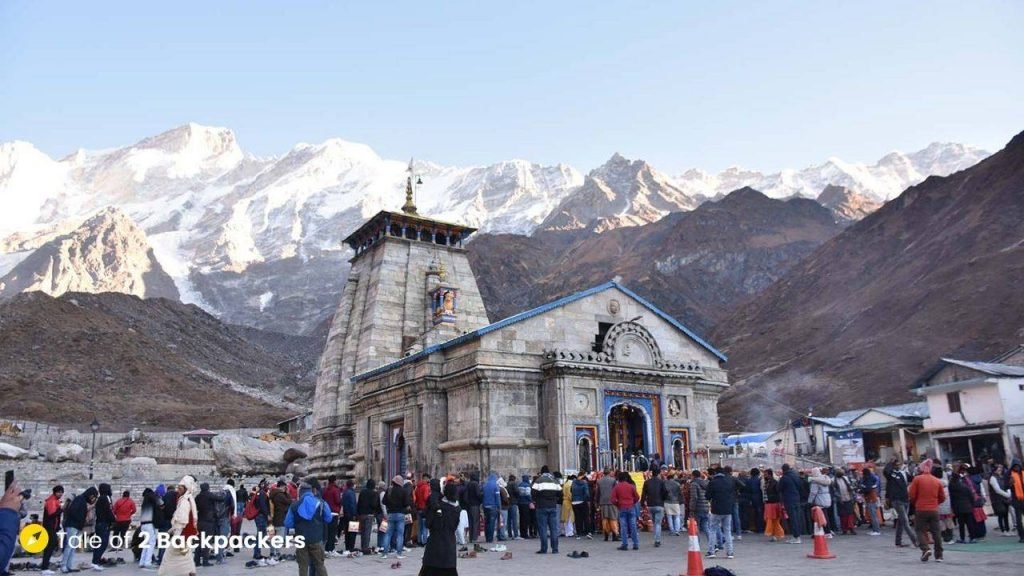
Places around the Kedarnath Temple
Bhaironath Temple
This temple is located at a very short distance from the Kedarnath Temple. It is believed that Bhaironath guards the Kedarnath Temple by keeping the evil at bay.
Shankaracharya Samadhi
This is the resting place of Adi Shankaracharya and is located near the Kedarnath Temple.
Gandhi Sarovar
About 3 km from Kedarnath Temple lies the Gandhi Sarovar that is fed by the Chorabari Glacier. If you wish to trek there, start early in the morning. The weather can change quite abruptly.
Vasuki Tal is located about 8 km from Kedarnath Temple. The trekking trail is quite steep and should be done with the help of guides. The Vasuki Taal offers a great view of the Chaukhamba ranges.
Rudra Meditation Cave
This is an interesting place. Located about 1.5 km from the temple, there is an underground cave available for meditation and isolation. The caves have a window that provides a direct view of the Kedarnath Temple. You can book the cave for yourself for the purpose of meditation for a maximum of 3 days. Obviously, only one person can stay inside the cave. The cave has all living facilities like water, electricity, heater, attached toilet and a phone to call the authorities in case of emergency.
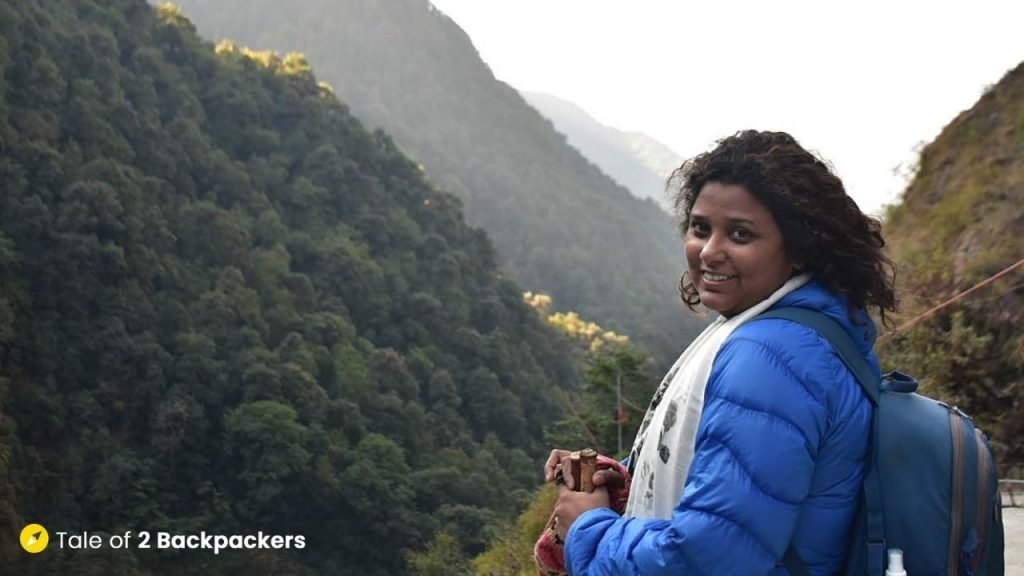
Some interesting Facts about the Kedarnath Temple
- It is believed that the Kedarnath Temple is eternally protected and cannot be harmed.
- Bhaironath Ji is the protector of the Kedarnath Temple and is known as the Kshetrapal. He is the fiery avatar of Lord Shiva and is known for devastation and destruction.
- Kedarnath is one of the 12 Jyotirlings of Lord Shiva. It is infact, the highest of all the Jyotirlings in India.
- After Bhai Dooj, when the temple is closed, the main deity is brought down to Ukhimath.
- The head priest of the Kedarnath Temple belongs to the Veerashaiva community of Karnataka and is known as Rawal. However, the head priest or Rawal does not conduct the ritual inside the temple. He only gives instructions to his assistants. The deity is transferred to Ukhimath during the winter. The puja is performed in Kannada language.
- The temple is said to have been buried under ice for almost 400 years.
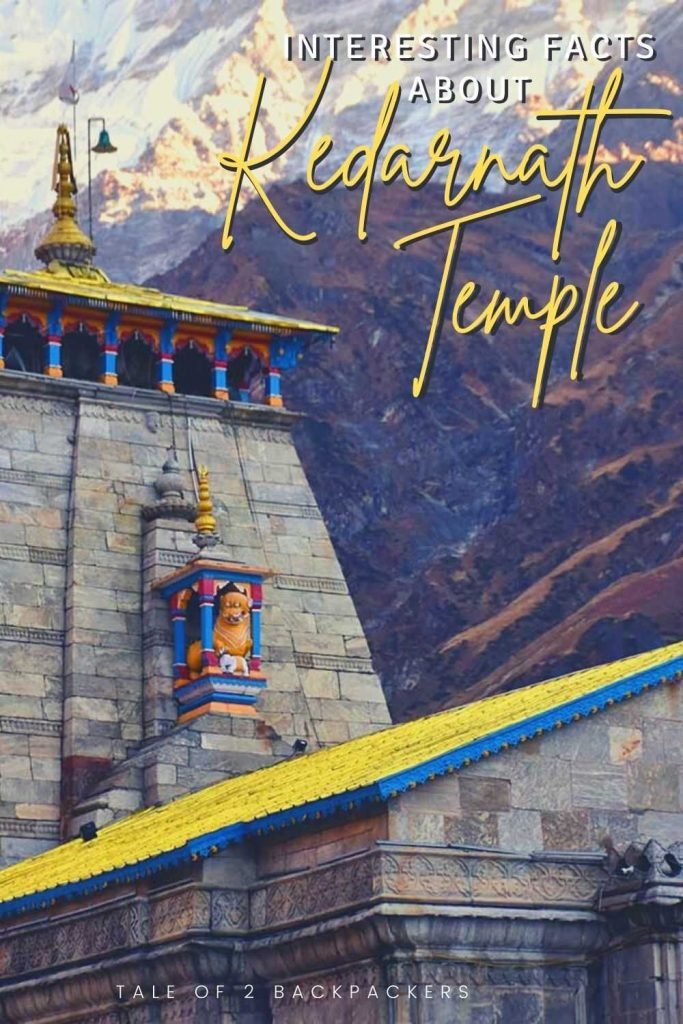
Have you visited Kedarnath? Please let us know your thoughts on this famous pilgrimage. If you liked this post and found it helpful, please share it with your family, friends and neighbours!
Pin it for a later read!
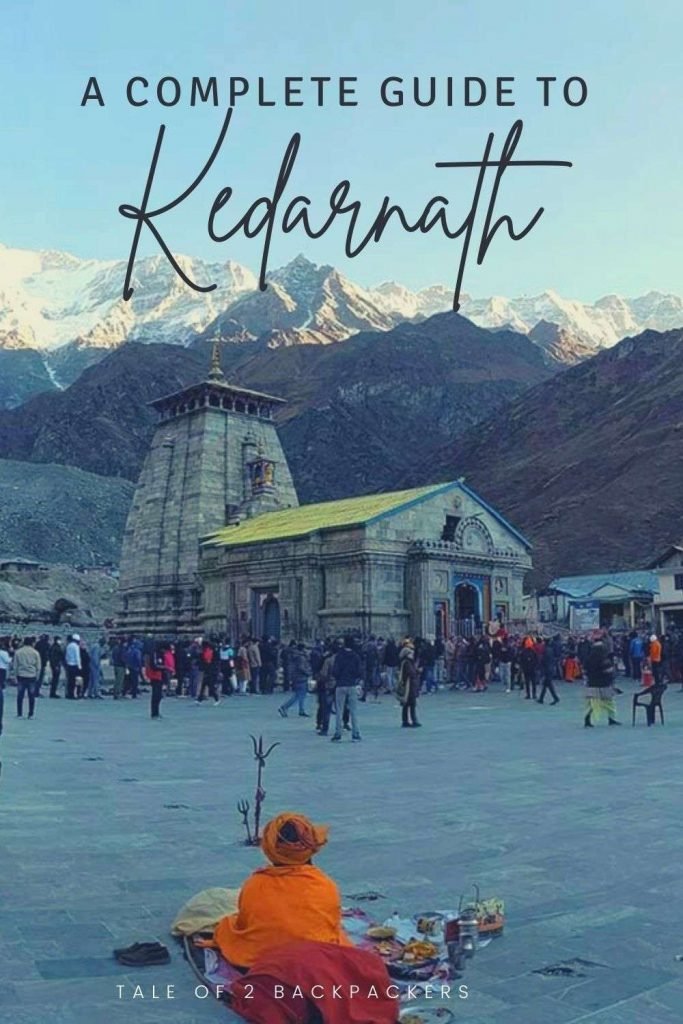
Agni Amrita
Related posts.
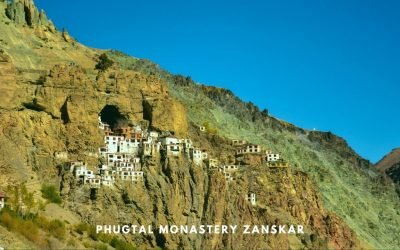
Phugtal Monastery Trek – Guide to the Cave Monastery of Zanskar

DUMAIL TREK KASHMIR – An easy hike from Naranag
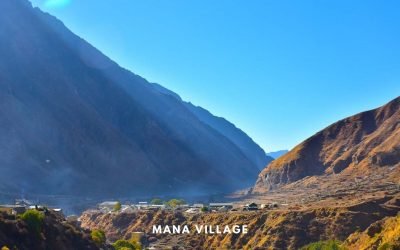
Trip to Mana Village – the Last Village of India
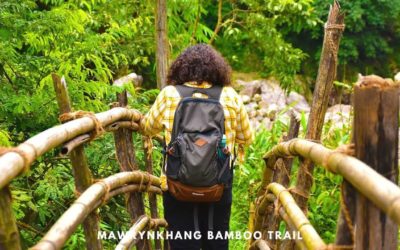
Mawryngkhang Trek (Bamboo Trail) Meghalaya – Guide to The Scariest Trek
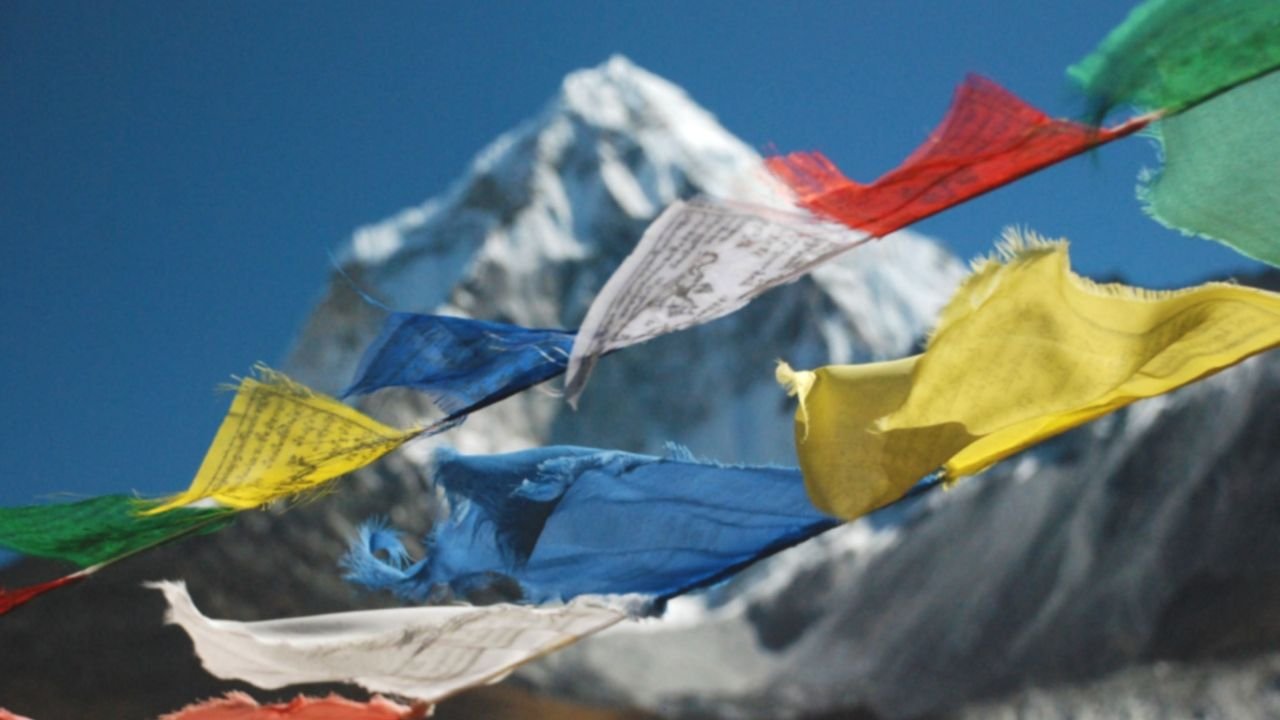
Trekking in Nepal: 15 Best Treks and all that you want to know
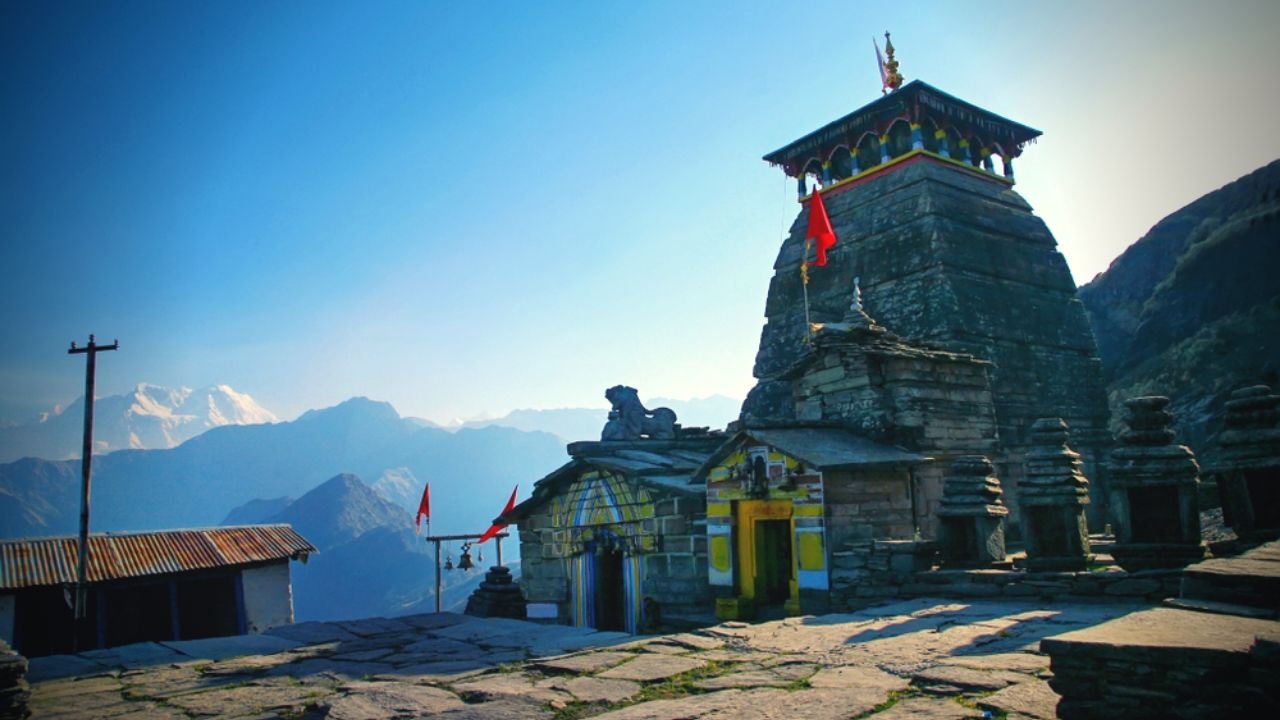
Tungnath Deoriatal Chandrashila Trek Itinerary and details (FAQs answered)
56 comments.
Beautiful content and very informative 🙂 Har har mahadev 🙏🏼
Thank you so much!
Hi, beautiful article, wish had come across your article before, just couple of days back we trekked to kedarnath, myself 55 yrs old and my husband 58 yrs. It was dream come true for me at this age, can you with your rich experience share how to treat aching legs after trek. We use coconut oil, is there any other thing which can be of help. Thankyou. God bless both of you
Hello Ma’am! We are so glad to hear that you had trekked to Kedarnath. Time and again it os proved that age is just a number! As for treating aching legs, we recommend to apply ice pack on the aching area. It will help a lot. Also keep your legs elevated for few minutes every day. Hope this helps!
Very comprehensive and informative! I think these tips and advice are much helpful. Good you explained everything in detail it has been a great help.
A captivating tale of the Kedarnath trek! The personal experiences you share make it feel like we’re trekking right alongside you. The spiritual and natural beauty of the region shines through your words. Thanks for taking us on this unforgettable adventure through your storytelling – it’s both inspiring and informative
Thank you so much for your kind words.
Hi. Its very interesting to hear from you. Congratulation for the trek. Now I booked at gourikund . Can you provide any information the proceedings before start trek from Gourikund. Thanks again.
Thank you so much for your comment. Have a great trip and let us know how it went.
thank you for such a nice, elaborate and interesting blog!! while we have been aspiring to visit Kedarnath and badrinath much in recent times, i was actually looking for a visitor’s experience and just came across yours… thank you once again.
Thank you poorna for the kind words.
Thankyou for the amazing informative content on kedarnath yatra. Everybody needs this informative content keep sharing.
Wonderfully done article..Pretty complete. I am planning to do the Kedar trek with kids 7&12 and planning to rent a car.
You have mentioned you rented a car for 5 days. Does it come with a driver or you drive on your own. Any preferred rental companies for Car?
We had rented a car with driver. We got the car from a rental service at Haridwar. It was near Haridwar Railway Station. Have a wonderful trip to Kedarnath.
Hi… felt like a movie … scenes passes thru my imaginative mind! Clear cut, lively explanation. I am visiting kedar, badri and tungnath this June. Plz help me with a trustable travel agency or travel agents number. We are from bangalore and will come thru flight. Thanks a lot I. Advance. I am inspired to write a page later.. ( in my son’s notebook.. not here 😉 ) ha ha. Will be waiting for the reply
Thank you for a very informative write up. One question, how long did it take you to trek back to Gaurikund? You mentioned you reached at 12.30, but not state the start time. Did you have time to look around in the morning before starting the trek back?
Hello Sharmila! Thank you for reading our blog! And thank you also for pointing out the time. We had reached Gaurikund by 2PM and not 12PM. It was typo error. Now we have corrected it. We had started around 8.30AM after attending the morning aarti and just roaming around the place.
Woooow so nicely explain every minute details. This will help us a lot for sure for our planning.
Nice Blog…. This is really amazing. Great information about Kedarnath trek.
It’s amazing blog and very informative about Kedarnath trek….. This blog will very helpfull for newbies.
Amazing Blog… many things to learn. thanks for sharing.
Good Luck for the upcoming update.This article is really very interesting.
One of my biggest dreams is to go to Kedarnath and in this blog, I got all the information for my next trip. And all the images are extremely beautiful. Thank you so much for sharing all this wonderful info with us.
Thank you so much Shivani! We are so glad you liked our blog.
Hi, How can we book hotels near the temple in Kedarnath? You mentioned that it’s better if done ahead of the travel?
Can it be done online?
There are a few websites from where you can find out the contact numbers of the hotels near Kedarnath Temple. But I doubt whether it can be done online. There are also a number of travel agents in Haridwar and Rishikesh from where you can get your stay. Thank you for stopping by our blog. Keep reading!
this is a great read, very engaging and informative. I have a quick question regarding the stay at Kedarnath, you mentioned your stay at Bikaner house, is there any way to pre-book it?
Thank you so much for the comment. I think the stay at Bikaner House can be pre-booked. Please try calling +91-8191900012.
Amazing Blog, Thank for sharing this wonderful website with us.
I felt as if I were doing the trek with you as I read this. Beautifully covered with useful tips within. I have been meaning to get here and now am even more tempted. Loved your pics of the Sonprayag and the various trekking spots. The history and legends around this place really make it special. I knew the bit about Mahabharat and Shankracharya but did not know about how it was discovered
Thank you so much, Ami!
I’m hoping to go on Kedarnath Yatra after a couple of years. Good to know that they trek is about 16-17km and can be done in a day and there are also some accommodations on the way. Hahaha, it is funny and awesome that you visited Kedarnath as a kid and now your dad managed to give all the embarassing details to Agni. Now that I travel with my toddler, I have quite a bit of such funny and embarassing moments. Hoping to pass it on to her partner in future… Am I evil? Hahaha..
I bet you are! Just imagine my embarrassment when my dad gave all my secrets to my hubby. And he teases me with those till date!
Oh my God! I am bookmarking this post. Kedarnath has been on the top of my list. I want to hike and visit this amazing place, especially to hike. And also take my mother as she loves these kinds of religious places even though I would send her to the temple by other means and not by hiking. Thanks for this post, I will try to visit it as soon as the pandemic is over.
Thank you, Raksha! I am sure you will love Kedarnath.
What a great travel story and also a guide for those who want to do this trek. The views are absolutely breathtaking! And I love all those hidden little stories you mentioned. This trip also get a very personal feeling as other family members told you all those stories. The temples are all beautiful.
Thank you so much, Paula!
So interesting to read about the Kedarnath Yatra pilgrimage. And great to return to a trek that brings back special family memories. I can certainly see why the scenery along the river way to the start of your trek intrigued you. It looks like an interesting trek up to the Kedarnath Temple. Even if there was snow along the way. I might want to visit by helicopter and see those amazing views from above.
Helicopter ride is a good way to reach the place for those who cannot hike. Thank you Linda for the lovely comment!
What a fantastic experience! You provided so much information about Kedarnath, I feel like I could go and have a good idea of what to expect. I think the Kedarnath Trek sounds fascinating, although it must have been tiring the cultural experience and natural views must have been worth it.
Thank you Chloe! Kedarnath trek is quite an experience.
This is a great comprehensive guide! We have never heard of Kedarnath Yatra, but it looks like an interesting place to discover. Spiritual, historic and hiking all in one trip? That sounds like our kind of thing. We’ll definitely include this in our India itinerary when it’s safe to travel.
Wow just look at those mountains. I would love to do this hike and when I visit India I need a long time to see the beautiful places in this country. This looks like a great 2 day and worth it and the views must be amazing during the whole trek. I hope I get to visit one day as it looks amazing.
That I totally agree to. You will need a lot of time to explore India! Thank you for the lovely comment!
I never heard of the Kedarnath and after this in-depth description and experience, I would love to do a trek here. I love a hike with beautiful mountains and culture combined and this has it. The backdrop to the temple is truly amazing and I would just go to the temple just to see that. A lot of information here to consider as well, so I have bookmarked this page as I hope to do some hiking in India once Covid clears off. This part of the world has been on my list for a long time.
Thank you Danik! Kedarnath is one of the spiritual places in India and is absolutely gorgeous.
This is by far the most amazing blog I found on Kedarnath yatra. All the information is quite helpful. I almost felt that I am right there with you on the trek.Thanks for writing.
Thank you so much, for your kind words.
Descriptive blog about Kedarnath, valuable info shared for first-time travelers. Trekking in Kedarnath is an exciting and adventurous journey where you can avail all the accommodation as well as camping facilities with an awestruck top view from hills. Worth visiting along the trails to experience the local life.
Submit a Comment Cancel reply
Your email address will not be published. Required fields are marked *
Submit Comment
This site uses Akismet to reduce spam. Learn how your comment data is processed .
Pin It on Pinterest
Kedarnath Temple Blog
Kedarnath Temple Opening Date, Booking, Distance, Weather, Char Dham Yatra 2024 in Uttarakhand.
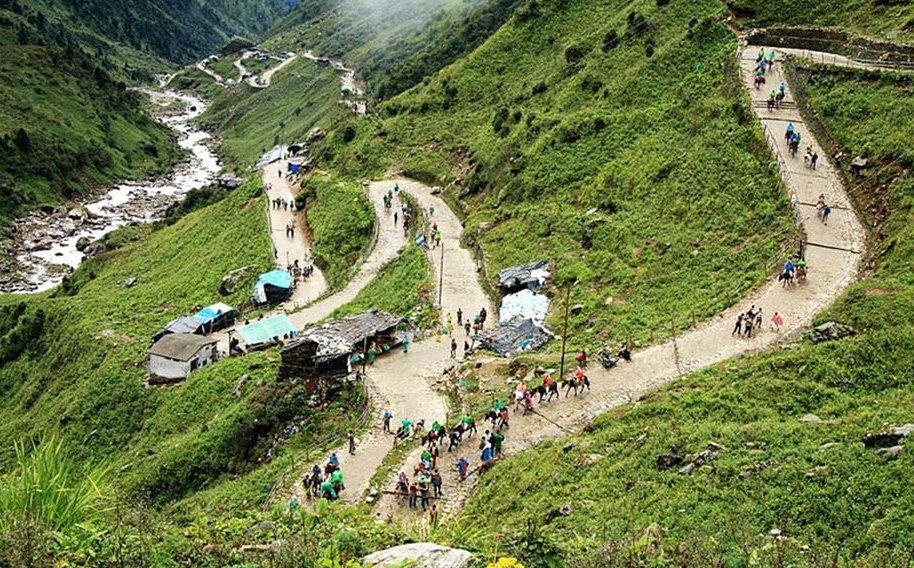
Kedarnath Trek – 16 Km (Travel Guide)
The Kedarnath trek is one of the most challenging and difficult treks in India. But it got easier when pilgrims chant the name of Kedar Baba (Lord Shiva). Here in this article, we have shared a complete travel guide for the trekking tour at Kedarnath Temple.
About Kedarnath Trek
Kedarnath Trek is a popular pilgrimage and trekking destination in the Indian state of Uttarakhand. The trek leads to the Kedarnath temple, one of the four major shrines in Hinduism, located at an altitude of 3,583 meters (11,755 feet) above sea level.
The trek to Kedarnath starts from a place called Gaurikund, which is located at a distance of 16 km from Kedar Nath Temple. The trek takes you through some beautiful and scenic landscapes, including lush green forests, waterfalls, and streams.
The route is steep and challenging in some places, but the stunning views of the Himalayan peaks make it all worth it.

Best Time To Visit Kedarnath Trek
The best time to undertake the Kedarnath trek is from May to June and from September to November, as the weather during these months is mild and pleasant.
During the monsoon season, which is from July to August, the trek can be risky due to the possibility of landslides and flooding.
The Kedarnath trek is considered a holy pilgrimage by Hindus, and thousands of devotees undertake this trek every year to seek the blessings of Lord Shiva.
However, it is also a popular trekking destination for adventure enthusiasts and nature lovers who want to experience the beauty of the Himalayas up close.
Best Time for Char Dham Visit
- Best Time To Visit Kedarnath
- Best Time To Visit Badrinath
- Best Time To Visit Gangotri
- Best Time To Visit Yamunotri
Kedarnath Trek Distance and Time
- The distance of the Kedarnath Trek is around 16 km (one way) from Gaurikund to Kedarnath Temple.
- The trek can be completed in a minimum of 2 days, with a one-night halt at Kedarnath, or it can be completed in a single day by experienced trekkers.
- The trek from Gaurikund to Kedarnath takes around 6-7 hours to complete, depending on the fitness level of the trekker.
On the first day, trekkers usually cover a distance of around 7-8 km from Gaurikund to Kedarnath. The trek route passes through scenic locations like Jangal Chatti, Bheembali, Rambara, Lincholi, and Chhani Camp which are popular camping sites, and there is a hot water spring also.
On the second day, trekkers can explore the Kedarnath temple and surrounding areas and start the return journey to Gaurikund. The return journey takes around 5-6 hours to complete and covers a distance of around 9 km.
Can I Complete Kedarnath Trekking Non-stop?
Yes, Most of the young people complete the Kedarnath trek in one go. and Stay at Kedarnath Temple at the night and then return the next day.
- A young person with a good fitness level can complete this 16km trek in 6-7 hours (non-stop) while going upside to the temple. (Upward direction)
- Returning time for the same distance will be around 5 hours . (Down direction)
Up-Down Daily Timings by the Temple Authority
- Last Timing for Upcoming Visitors – 5 Pm (Evening)
- Last Timing for Downgoing Visitors – 6:30 PM (Evening)
It is important to note that the duration of the trek may vary depending on the fitness level of the trekker and the weather conditions.
It is always advisable to undertake the trek under the guidance of an experienced trekking guide and to carry essential gear and supplies for the trek.
Don’t forget to check out this Best-selling TREKKING Bag on Amazon

Kedarnath Trek Route Map (New)
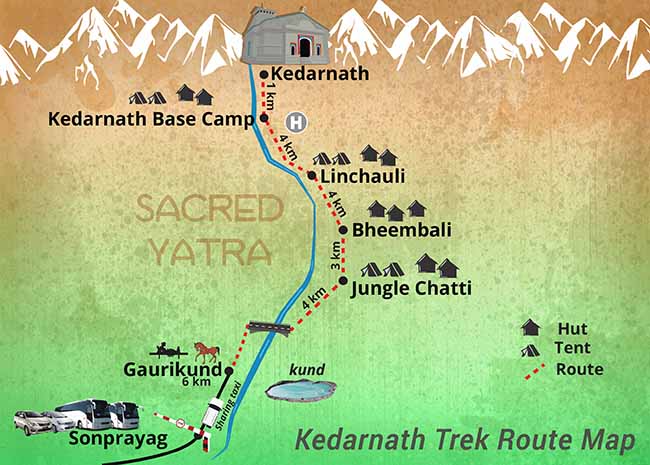
There are mainly 10 Checkpoints in the route of the Kedarnath Trek. These checkpoints are shown below in the order they come during the 16km trekking.
- Gaurikund (गौरीकुंड)
- Jangal Chatti (जंगल चट्टी)
- Bheembali (भीमबली)
- Rambara (रामबाड़ा)
- Chhota Lincholi (छोटी लिंचोली)
- Lincholi (लिंचोली)
- Chhani Camp (छानी कैंप)
- Rudra Point (रूद्र पॉइंट)
- Base Camp (बेस कैंप)
- Kedarnath Temple (केदारनाथ मंदिर)
Kedarnath Trek Route Length
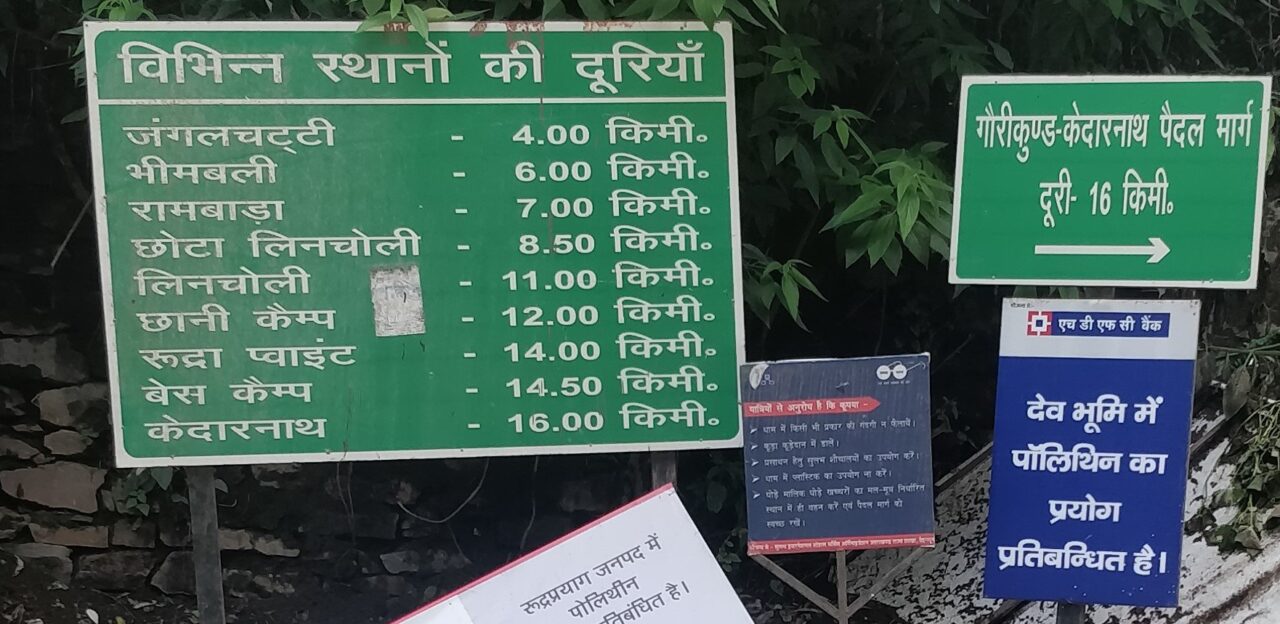
- Gaurikund To Jangle Chatti/Bhairon Chatti distance is 4 km.
- Jangle/Bhairon Chatti To Bheembali distance is 3 km.
- Bheembali To Linchauli distance is 4 km.
- Linchauli To K. Base Camp distance is 4 km.
- K. Base Camp To Kedarnath Temple distance is 1 km.
Char Dham Distance from Delhi
- Delhi to Kedarnath (466 km)
- Delhi to Badrinath (555 km)
- Delhi to Gangotri (530 km)
- Delhi to Yamunotri (485 km)
Gaurikund to Kedarnath Trek
Gaurikund is a Hindu pilgrimage site and base camp for trek to Kedarnath Temple. It is situated at an altitude of 6502 feet above mean sea level in the Garhwal Himalayas in the Rudraprayag district of Uttarakhand.
There are various options available at the starting point (Gaurikund) of the Kedarnath Trek. To complete the trek route, you have three options there.
- by Walking (Trekking)
Read More: Gaurikund to Kedarnath Guide
Explore Kedarnath
- History of Kedarnath
- Weather i n Kedarnath
- Hotels i n Kedarnath
- Meditation Cave i n Kedarnath
- 21 Facts About Kedarnath
- Kedarnath Yatra 2023 Guide
Here are the most Frequently Asked Questions about Kedarnath Trek.
How long is Kedarnath Trek?
The length of the Kedarnath Trekking route is around 16-18 kilometers from Gaurikund to Kedarnath temple.
How much time does it take for Kedarnath Trek?
The Kedarnath Trekking usually takes 2 days to complete (If stops midway for rest). And for a young fit person, it takes 6-7 hours to reach the Kedarnath temple. (nonstop)
From Where Does Kedarnath Trek Start?
The Kedarnath Trekking route starts from Gaurikund.
How difficult is Kedarnath Trek?
The Kedarnath Trekking is considered a moderate to difficult level.
How many km is Trek to Kedarnath?
The trekking route to Kedarnath is around 16 kilometers one way.
How to prepare for Kedarnath Trek?
To prepare for the Trek, one should focus on physical fitness, pack appropriate clothing and gear, carry essential items like water and food, and acclimatize to the high altitude.
What to wear in Kedarnath Trek?
For Trekking at Kedarnath, it is recommended to wear comfortable trekking shoes, quick-drying pants and t-shirts, a warm jacket, a hat, sunglasses, and sunscreen. It is also important to carry rain gear and warm clothes for the night as the temperature can drop significantly.
Which trek is more difficult Kedarnath or Amarnath?
Kedarnath and Amarnath’s treks are both considered challenging, but the Kedarnath trekking is comparatively easier than the Amarnath. (due to the difference in the distance)
How steep is Kedarnath Trek?
The Kedarnath Trek is considered a moderate to difficult level, with several steep ascents and descents along the route.
The trekking route involves walking uphill for a significant portion of the journey, with an altitude gain of around 3,550 feet (1,082 meters) from Gaurikund to Kedarnath.
The terrain can be rocky and uneven at times, and there are several sections of the trail that require careful footing and a good level of fitness. The steepness of the trek can vary depending on the specific route taken and the individual’s level of physical fitness.
Overall, the Kedar Trek is a challenging but rewarding experience, with stunning views of the Himalayan mountain range and opportunities to explore the region’s natural beauty and cultural heritage. It is important to prepare properly and take necessary precautions to ensure a safe and enjoyable trekking experience.
Things to carry for Kedarnath Trek?
Some of the essential things to carry for the Kedarnath Trekking are comfortable trekking shoes, warm clothes, rain gear, sunscreen, sunglasses, a hat, a first aid kit, sufficient water and snacks, and a backpack to carry all the gear. It is also recommended to carry a trekking pole and a camera to capture the beautiful views.
Here is a list of things to carry for the Kedarnath Trekking:
- Clothing: Carry warm clothing such as thermals, fleece jackets, and windcheaters. It can get chilly at night, so bring a warm hat and gloves as well. Wear quick-dry, breathable clothes that are comfortable to trek in. Also, carry an extra set of clothes for emergencies.
- Footwear: As discussed earlier, wear comfortable and sturdy hiking boots or shoes with good grip and ankle support.
- Backpack: A good quality backpack with a capacity of around 40-50 liters is recommended to carry your essentials. It should have padded straps and a waist belt for better support.
- Sleeping Bag: Carry a good quality sleeping bag that is rated for the appropriate temperature range.
- Trekking Poles: Trekking poles help provide extra support and balance on uneven terrain. They are particularly useful when ascending or descending steep slopes.
- Water Bottles : Carry at least 2-3 liters of water, and ensure drink enough water throughout the trek.
- First Aid Kit : Carry a well-equipped first aid kit with essential medicines, band-aids, antiseptics, pain relievers, and any prescription medication you may require.
- Sunscreen, Sunglasses, and Hat : Protect yourself from the harsh sun by carrying sunscreen with SPF 50+, sunglasses with UV protection, and a hat.
- Personal Toiletries : Carry a small towel, hand sanitizer, wet wipes, toilet paper, and any personal toiletries you may require.
- Power bank and Extra Batteries : Carry a good quality flashlight or headlamp with extra batteries for use during early morning starts, late evening walks, or in case of power outages.
Remember to pack light and carry only essentials for the trek. Avoid carrying unnecessary items that add weight to your backpack.
Kedarnath Trek Itinerary?
Here’s a brief itinerary for the Kedarnath Trek:
- Day 1: Reach Gaurikund and hike to Kedarnath (16-18 km)
- Day 2: Explore Kedarnath and acclimatize to the high altitude
- Day 3: Trek back to Gaurikund (16-18 km)
Note : The duration of the trek can be extended depending on the fitness level of the trekker and weather conditions.
Best shoes for Kedarnath Trek?
The best shoes for Kedarnath Trekking are comfortable and sturdy trekking shoes with good grip, ankle support, and waterproofing to tackle the steep and rocky terrain.
Some good options for shoes for the Kedarnath Trek include hiking boots or shoes from well-known brands such as Salomon, Merrell, or The North Face. It is important to break in your shoes before the trek and wear them around for a few weeks to ensure that they are comfortable and fit well.
Trekking to Kedarnath at the night is generally not recommended as it can be quite risky and dangerous. The trek is quite challenging, and even during the day, it requires a good level of fitness and stamina.
Trekking at night can be more challenging due to low visibility and increased chances of slipping, tripping, or losing the trail.
Moreover, the trail to Kedarnath is located in a remote mountainous region with steep inclines, rocky terrain, and unpredictable weather conditions. It can be risky to trek in the dark without proper lighting, equipment, and a guide. There have been cases of trekkers getting lost or injured during night treks to Kedarnath.
Therefore, it is advisable to trek to Kedarnath during the daytime when the weather and visibility are better, and there is more help available in case of emergencies.
If you do plan to trek at night, it is essential to prepare adequately, carry appropriate gear, and seek the advice of experienced guides or local authorities.
1 thought on “Kedarnath Trek – 16 Km (Travel Guide)”
- Pingback: How To Reach Kedarnath From Delhi: Route Distance (466 km)
Leave a Comment Cancel reply
Save my name, email, and website in this browser for the next time I comment.
.png?w=auto&h=400)
Kedarnath Trek
Kedarnath trek overview.
Kedarnath trek is a remote trek that starts at Gaurikund, which is the base camp of the trek. It is a moderate-level trek and can be embarked on by even novice trekkers without any prior experience. The Kedarnath trek distance is 16 km and you will need to trek for 5 to 6 hours to reach the Kedarnath base camp at an altitude of 3583 m. Trekkers who are not accustomed to long journeys and high altitudes may find it difficult to complete the trek. Hence reasonably good physical fitness is required for this trek.
Experience the incredible natural beauty as you journey from Rishikesh to Sonpragyag. The first base camp of the Kedarnath trekking is at Gaurikund, which offers a magnificent range of himalayan range which can be explored by a jeep or shuttle feeling spellbound looking at the surroundings.
The trek from Gaurikund will start the next day and for 5 to 6 hours you will be captivated with the beauty of the surrounding mountains, running streams and greenery. See the tips of the snow covered mountains which will become more and more visible with your ascend. Witness the peaceful energy as you get to see the famous Kedar Nath Temple as your top destination. Get blessings from one of the temples of the Chota Char Dham of Uttarakhand which is dedicated to Lord Shiva. There will be several points on the way where you will be able to make a stop including Jungle Chatti, Bheem Bali, Linchauli and finally Kedarnath Base camp.
Book Kedarnath Trek Package
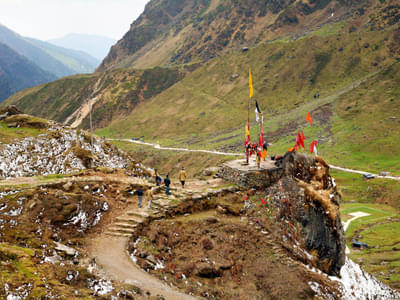
Experience a thrilling and challenging trekking experience to the Kedarnath temple, built in the 8th century and standing at an elevation of around 3,583 meters (11,755 feet) above sea level.
Pass through some scenic trails and diverse terrains, including steep trails and rocky paths. Be amazed by breathtaking views of the Himalayan peaks like Swargarohini and Sumeru, and alpine meadows along the way.
Marvel at the wonderful architecture of Kedarnath Temple which is adorned with intricate carvings and designs. It stands as a symbol of ancient craftsmanship and cultural heritage.
Explore the Panch Kedar circuit, with Kedarnath being one of the five sacred temples dedicated to Lord Shiva, and gain some insights into the significance of these sacred sites.
Take a remarkable journey to this sacred and revered Kedarnath Temple, which is believed to be a place of immense spiritual significance in the world.
- Avoid consuming any intoxicants in the course of the trek.
- Consider consulting your physician before going for the trek.
- Discard all wastes carefully and responsibly and avoid littering the trek.
- Remember to carry a first-aid kit with basic medications along with you for the trek.
- Remember to wear a pair of good quality trekking shoes that will be of much help in hiking through the steeper terrains.
- Pay attention to the trek instructor and follow the traditional Kedarnath trek route.
- This Kedarnath trek package is not recommended for pregnant women and people having knee, hip, shoulder, or heart problems.
You May Also Book
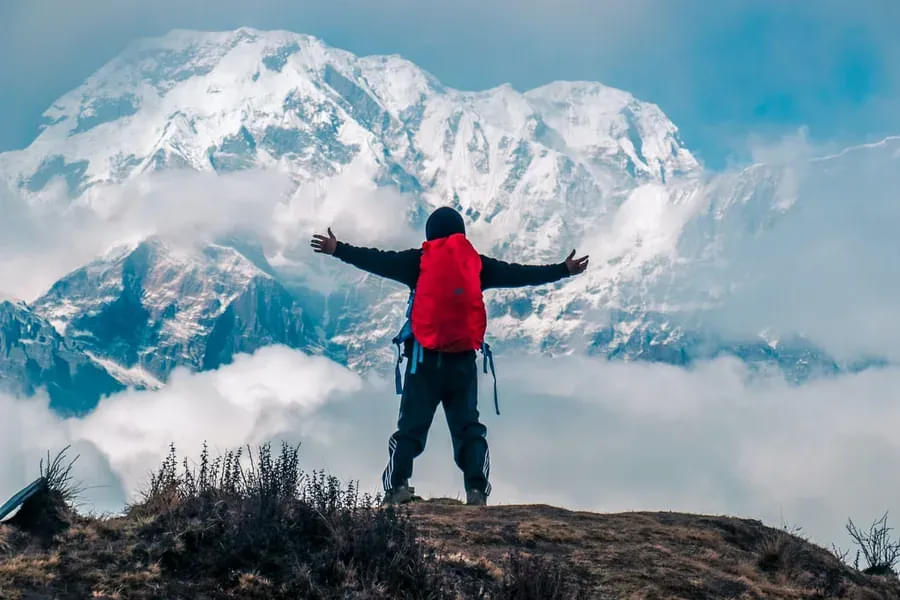
Quick Facts of Kedarnath Trek
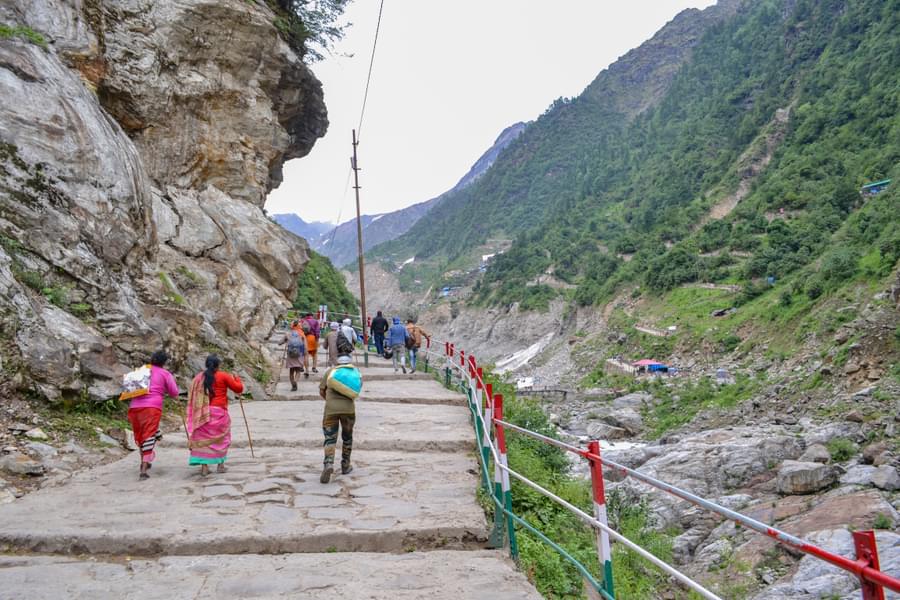
Kedarnath Trek Maximum Altitude: 3583 m
Grade: Moderate
Kedarnath Trek Duration: From Gaurikund to Kedarnath: 7 to 8 hours
Trekking distance: From Gaurikund to Kedarnath: 16 km
Trail type: Medium to steep
Railhead: Nearest Railway station is Rishikesh Railway station, 221 km from Kedarnath
Airport: Jolly Grant Airport, near Dehradun, about 239 km from Kedarnath.
Snow Season: November to April
Service from: Delhi
Base camp: Gaurikund
Best season: Summer (April to June)
Region: Garhwal Himalayan range near the Mandakini river, in the state of Uttarakhand, India.
Who can participate: Anyone who is physically fit can participate as there is no prior experience that is required for this trek.
Short Itinerary for Kedarnath Trek
Day 1: Arrival in Delhi
Day 2: Travel from Delhi to Haridwar (By Train - 217.6 km)
Day 3: Drive from Haridwar to Guptkashi (Altitude 1,319 m) (By Road - 203.5 km)
Day 4: Travel from Guptkashi (Altitude 1,319 m) to Gaurikund (Altitude 1982 m) and then Trek to Kedarnath (Altitude 3583 m) (By Road - 15.3 km & Trek - 14 km)
Day 5: Trek to Vasukital( Altitude 4,135 m) (Trek - 8 km) and Back to Kedarnath(Altitude 3583 m) (Trek - 8 km)
Day 6: Trek to Gaurikund (Altitude 3583 m) (Trek - 14 km) - Drive to Rudraprayag (Altitude 690 m) (Drive - 41.2 km)
Day 7: Drive back to Rishikesh (By Road - 141.7 km)
Day 8: Travel back to Delhi
Kedarnath Trek Detailed Itinerary

Arrival in Delhi
Your Kedarnath trek will start as soon as you arrive at Indira Gandhi International Airport in Delhi.
You will be transferred to your hotel in a spacious and comfortable vehicle.
Check in for the night and take a rest in the hotel after enjoying a delicious dinner.
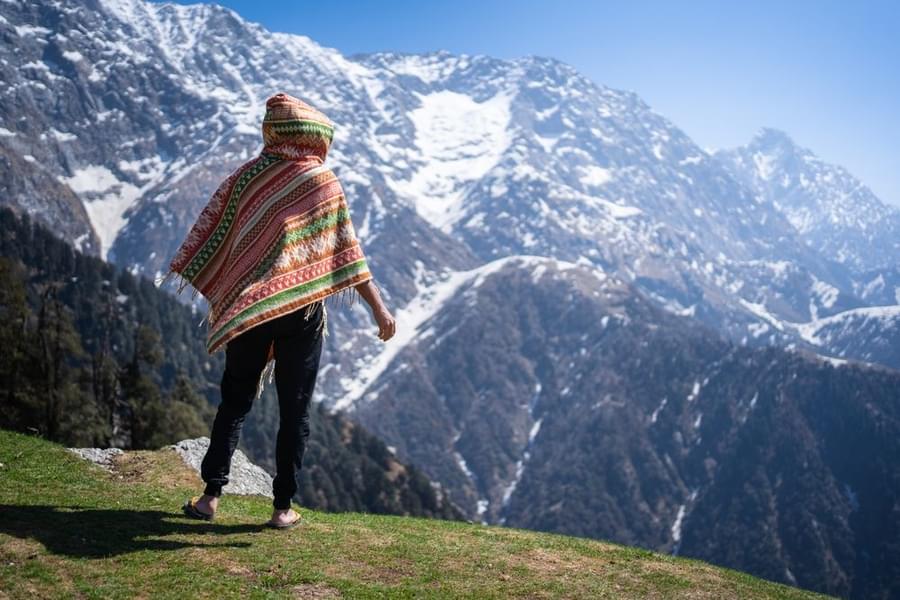
Travel from Delhi to Haridwar by train
Distance: 217.6 km
Duration: 6 hours and 20 minutes
On the second day of your Kedarnath trekking trip, you will need to wake up early in the morning and check out of your Delhi hotel after having a sumptuous breakfast.
You will be taken to the railway station in a comfortable vehicle and board the train for Haridwar.
Enjoy the journey to Haridwar for 6.5 hours and arrive at the Haridwar railway station.
You will find yourself heading towards your place of accommodation in a spacious and comfortable car.
Spend the evening exploring the local attractions of the town at a leisure pace on your own.
Return to the hotel to have a delicious dinner in the night.
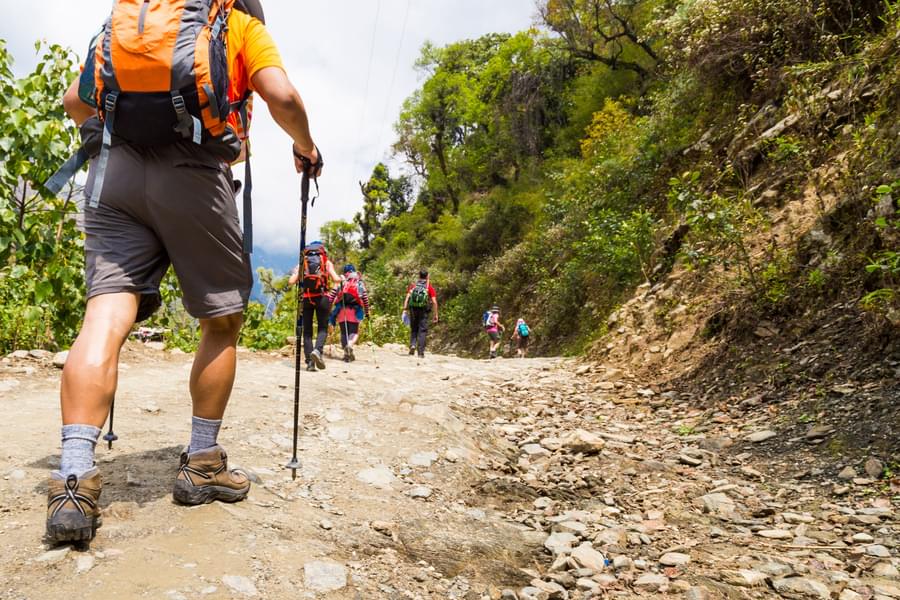
Drive from Haridwar to Guptkashi
Altitude: 1,319 m
Distance: 203.5 km
Start your day 3 with a hearty breakfast and then check out of your Haridwar hotel.
You will be proceeding towards Guptkashi by road. You will be traveling 203.5 km via National Highway 7.
Reach Guptkashi after 6 hours and 20 minutes and check-in your hotel.
Freshen up, spend some time exploring the city and then enjoy a scrumptious dinner, and rest overnight at your hotel.
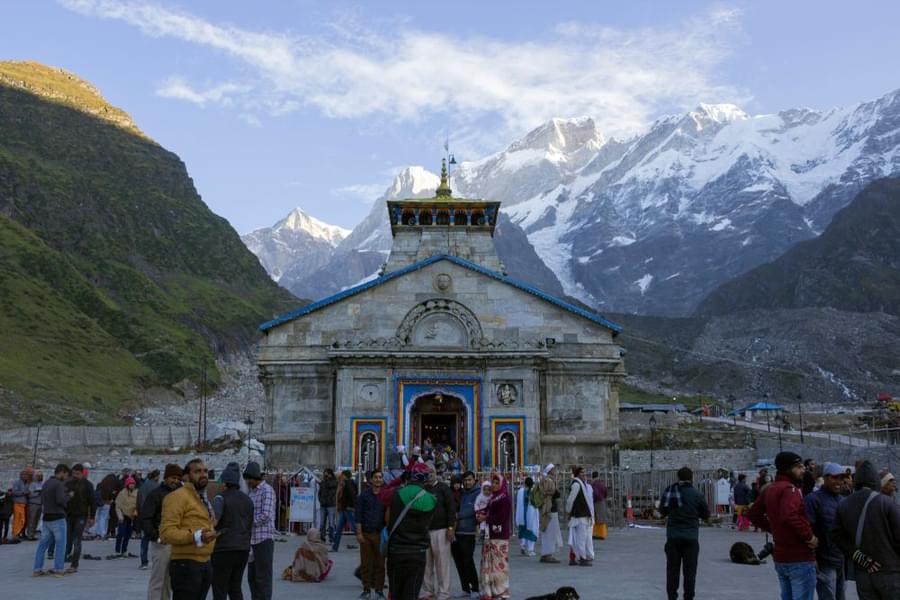
Travel from Guptkashi (Altitude 1,319 m) to Gaurikund (Altitude 1982 m) and then Trek to Kedarnath (Altitude 3583 m)
Altitude: 1,319 m to 1982 m to 3583 m
Distance: By Road - 15.3 km & Trek - 14 km
Duration: By Road - 1 hr 12 min & Trek - 6 hours
Start your morning with a delicious breakfast and feel energized to start the most important day of your trekking tour when you will finally trek to Kedarnath dham.
Check out of your hotel and proceed on your journey to the base camp of the Kedarnath trek, Gaurikund from where you will proceed to Kedarnath temple located at an altitude of 3583 m.
Ensure you start on time to reach there on time as trekkers are only allowed between 4:00 AM to 1:30 PM.
The Kedarnath trek distance is 16 km and will take you 5 to 6 hours to reach.
Carry your packed lunch and start your trek.
Your 1st stop will be Jungle Chatti at 4 km from Gaurikund which you will reach after trekking through the Rambara Bridge.
Take a break to enjoy the stunning view before you continue for another 3 km to reach Bheembali.
Your scenic journey to Bheembali will include a magnificent view of snow-covered mountains and temple walls.
Continue on Kedarnath trekking for 4 km more to reach Linchauli and take a break and enjoy the stunning mountain view.
Next, proceed towards Kedarnath base camp which is at a distance of 4 km from Linchauli and located at an altitude of 3583 m.
From this location, you will be able to watch the panoramic view of the valley, where you can enjoy the tranquil ambience of the place and explore the lush surroundings.
Reach Kedarnath and stay overnight at the hotel after a mouthwatering dinner.
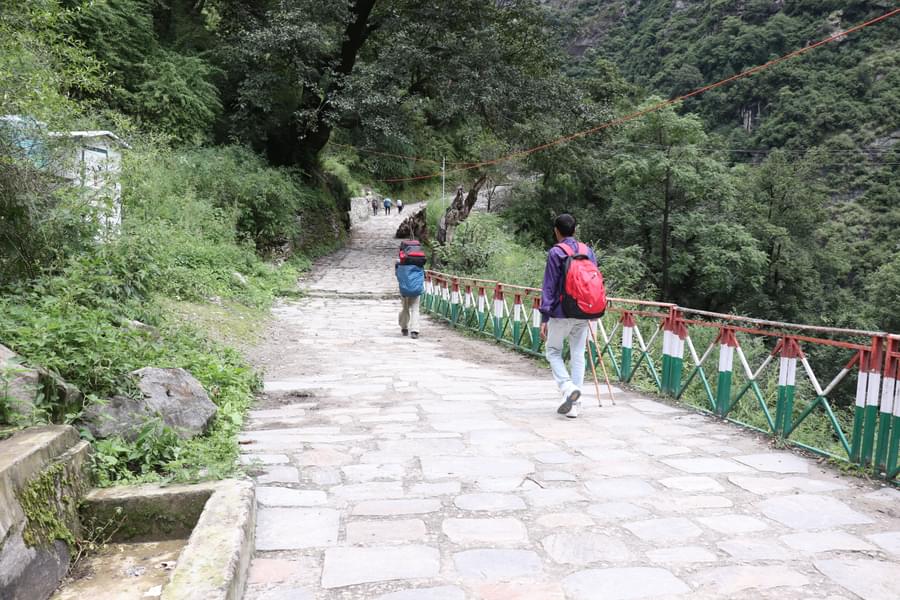
Trek to Vasukital( Altitude 4,135 m) (Trek - 8 km) and Back to Kedarnath(Altitude 3583 m) (Trek - 8 km)
Altitude: 3583 m to 4,135 m
Distance: 8 km
Duration: 5 -6 hours one way
Start your morning with the breathtaking view of the surrounding mountains and get ready for visiting one of the famous temples of India. Visit the temple to offer your prayers and receive Lord Kedarnath’s blessings.
Carry your packed lunch and start your picturesque trek to Vasuki Tal.
Reach Vasuki Tal and feel enchanted looking at the beauty of the pristine and explore the area to enjoy the natural splendors for a while.
Start your descent to Kedarnath in the evening and reach your hotel to enjoy a piping hot dinner and retire for the night.
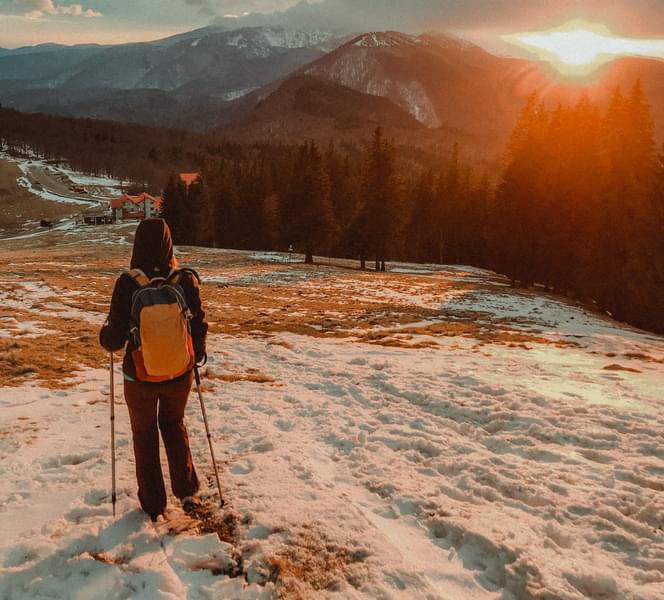
Trek to Gaurikund (Altitude 3583 m) (Trek - 14 km) - Drive to Rudraprayag (Altitude 690 m) (Drive - 41.2 km)
Altitude: 3583 m to 690 m
Distance: Trek - 14 km & By Road 41.2 km
Duration: Trek - 6 hours, Drive - 2 hr 46 min
Wake up to the scenic beauty and tranquil ambience of Kedarnath and enjoy a healthy breakfast at your hotel.
Start your descending trek to Gaurikund and carry a packed lunch with you.
Trekking for 6 hours to cover the distance of 14 kms down to reach Gaurikund.
Once you reach Gaurikund, you will start your journey to Rudrapayag by road. Reach Rudraprayag after travelling for 2 hr 46 minutes.
Reach your hotel, have a mouthwatering dinner and rest overnight.
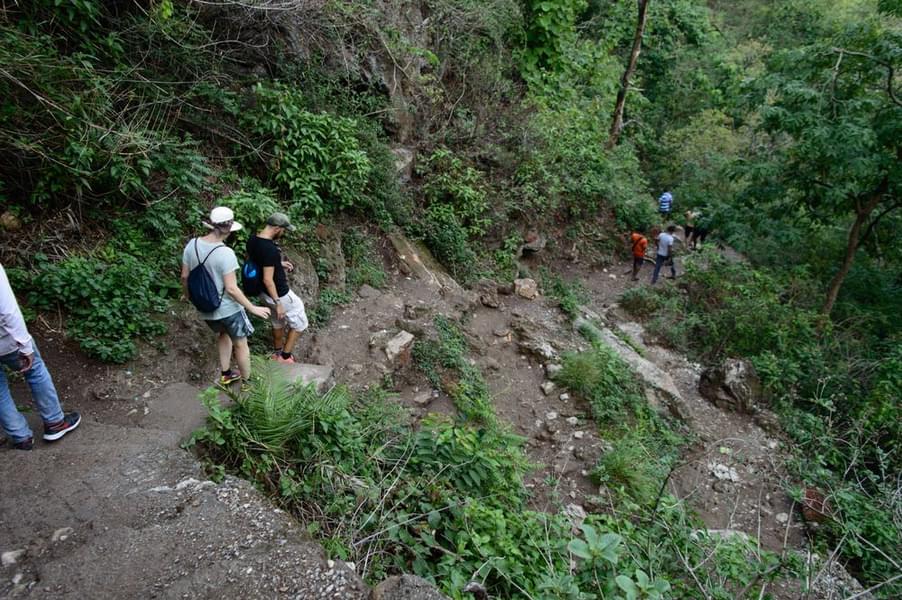
Drive back to Rishikesh (By Road - 141.7 km)
Distance: 141.7 km
Duration: 4 hr 10 min
Wake up in the morning and enjoy a flavourful breakfast at your hotel.Check out of your hotel and proceed on your journey to Rishikesh by road.
Reach the city of Rishikesh in about 4 hours and 10 minutes, travelling a distance of 141.7 km.
Reach Rishikesh, check-in your hotel and freshen up.
Enjoy a delicious hot dinner before you retire to rest overnight at your hotel.
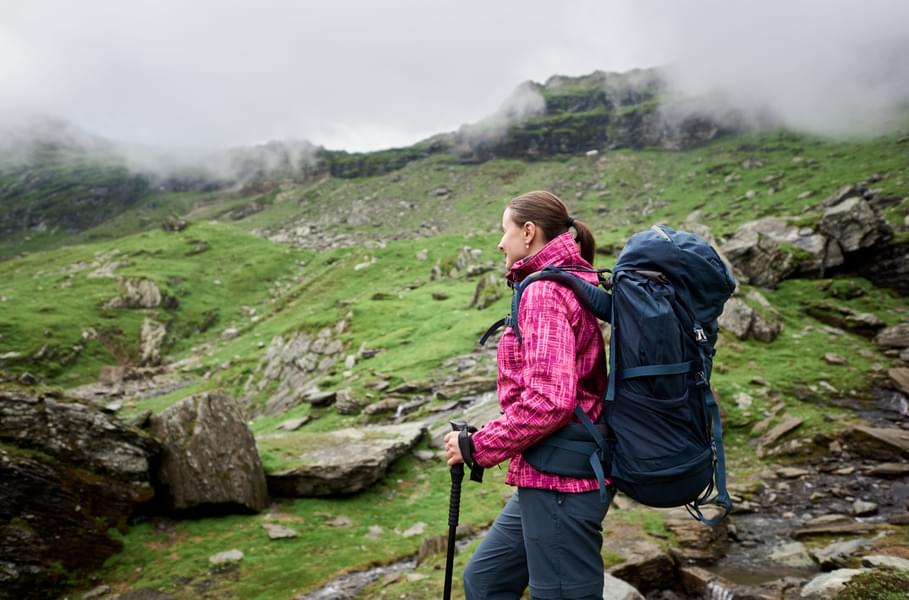
Travel back to Delhi
Distance: 268.1 km
Duration: 5 hr 7 min
Wake up on the last morning of your Kedarnath trek to the serene atmosphere of Rishikesh and enjoy a hearty breakfast at your hotel.
Check out of your hotel and proceed for a sightseeing tour of the Yoga Capital of India.
Complete sightseeing by evening and proceed towards the Haridwar railway station in a comfortable and spacious vehicle and leave for Delhi.
Your trekking trip comes to an end at Delhi railway station from where you will proceed on your onward journey back home with wonderful memories of the amazing places you have visited.
Things to Carry for Kedarnath Trek
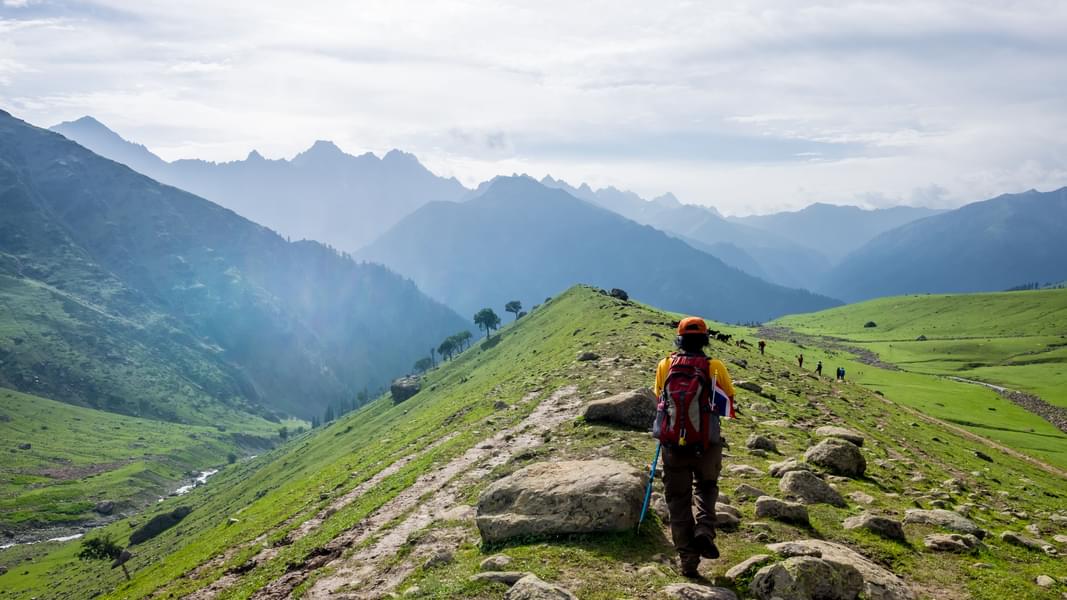
Mandatory Documents:
- Original as well as photocopy of any government photo identity card such as Driving License, Aadhar Card, Voters ID, etc.
- Passport and Visa need to be provided by International Travelers
- Medical Certificate (the first part needs to be filled by a registered Doctor and you will need to fill up the second part)
- Certificate of Declaration
- Trek Pants will be more comfortable during the trek than jeans or trousers.
- Jackets to protect you against chilly weather.
- Warm clothing such as fleece or woollen layers for nights.
- Thermals to keep you warm at night.
- T-shirts which are more comfortable than shirts and dry fast.
- Raincoat to keep you dry in case there is rain.
- Head cover such as a cap or balaclava to protect your head during the trek.
- Socks (woolen and regular)
- Do not carry too many clothes as you have to carry them during your trek.
Get yourself sturdy well-fitted trekking footwear so that your feet do not hurt during the trek.
Other Essentials:
- A strongly built 50 to 60 liters backpack with a good support is an absolute must for a trek. Ensure there is a rain cover as well.
- Personal toiletry items such as toothpaste, toothbrush, toilet paper, sanitiser etc. and must carry sunscreen to protect your skin.
- Personal medical kit with items such as prescribed medicines and common ones for altitude sickness, pain relief, headache, fever, stomach problem, motion sickness, allergies, diarrhea, etc. Also an antiseptic cream, a pain relief spray, bandage and cotton for cuts.
- Hiking pole for support during the trek.
- Water bottle to refill with water to hydrate yourself during the trek.
- Sunglasses for protecting the eyes.
- Woolen and waterproof gloves to protect your hands.
- Torch to use at night.
- Camera with rechargeable batteries to capture the scenic beauty.
Know Before You Go for Kedarnath Trek
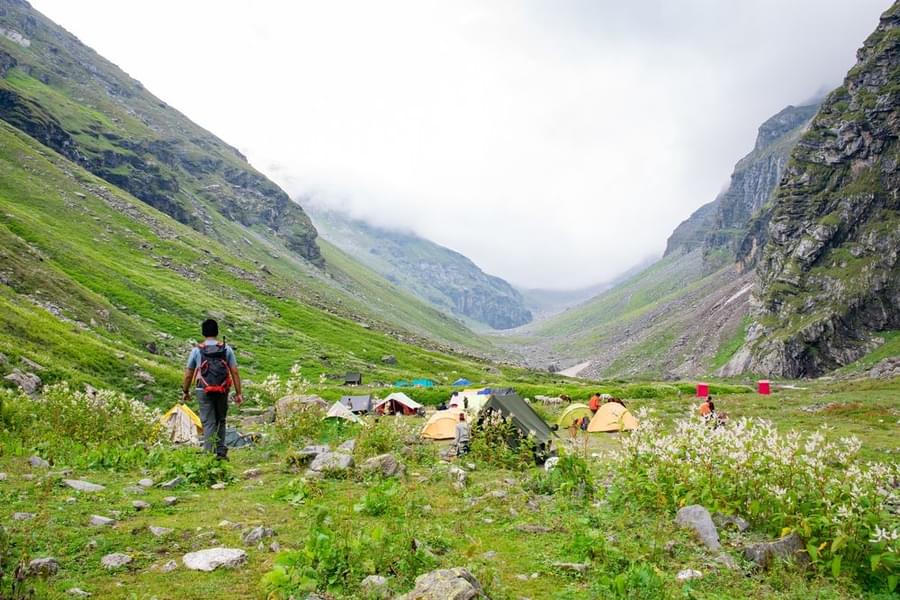
Get your medical checkup done to ensure fitness before you go on a trek.
People with heart, respiratory and blood pressure problems should not go trekking without a doctor’s advice. The trek is also not recommended for pregnant ladies.
You will need to abide by government rules and complete the trek within the stipulated time frame of 4 am to 1.30 pm.
Pay attention to your trek instructor and follow the traditional Kedarnath trek route.
If you are unable to complete the trek in a day, there are several places in between where accommodations are available.
Carry some light snacks such as dry fruits to keep you energized. You can also stop at the several food stalls and eateries on the way to get some food.
Wear clothes and shoes that are comfortable for trekking.
Carry a medical kit which may come in handy for sprains, cuts etc.
Be careful as you walk. Do not get distracted while walking, which might result in losing your foothold and spraining your legs.
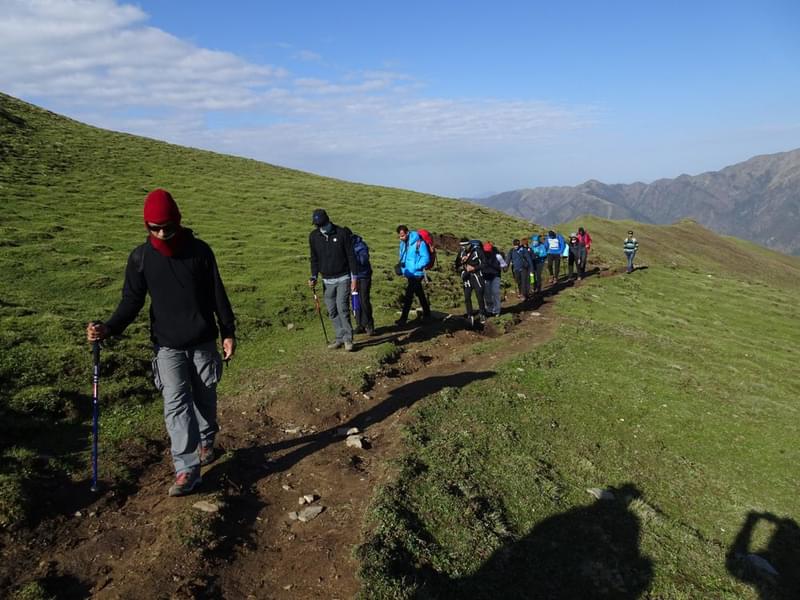
There is only one route which you will be taking when you go on your Kedarnath trek.
Base Camp: Gaurikund: You will be starting at the base camp at Gaurikund which is located 5 km from Sonprayag. Your vehicle will take you to Sonprayag and from there you have to travel by shuttle or jeep to reach Gaurikund.
First Stop: Jungle Chatti: Once you start from Gaurikund, you will need to trek through the Rambara Bridge for 4 km to reach Jungle Chatti.
Second Stop: Bheem Bali: The trek from Jungle Chatti to Bheem Bali is 3 kilometers and has a spectacular view of snow-capped mountains and temple walls. There are accommodations available here for those who want to take a break or stay the night.
Third Stop: Linchauli: Next is the 4 km trek from Bheem Bali to Linchauli. The trail has a stunning mountain view for you to enjoy. Linchauli also has accommodations for those who wish to stop and stay the night.
Fourth Stop: Kedarnath Base Camp: You will need to travel for 4 km from Linchauli to reach the base camp. You can opt to stop here for the night or proceed to reach the temple.
Final Destination: Kedarnath Temple: You will only need to travel for 1 km to reach the Kedarnath Temple, your final destination.
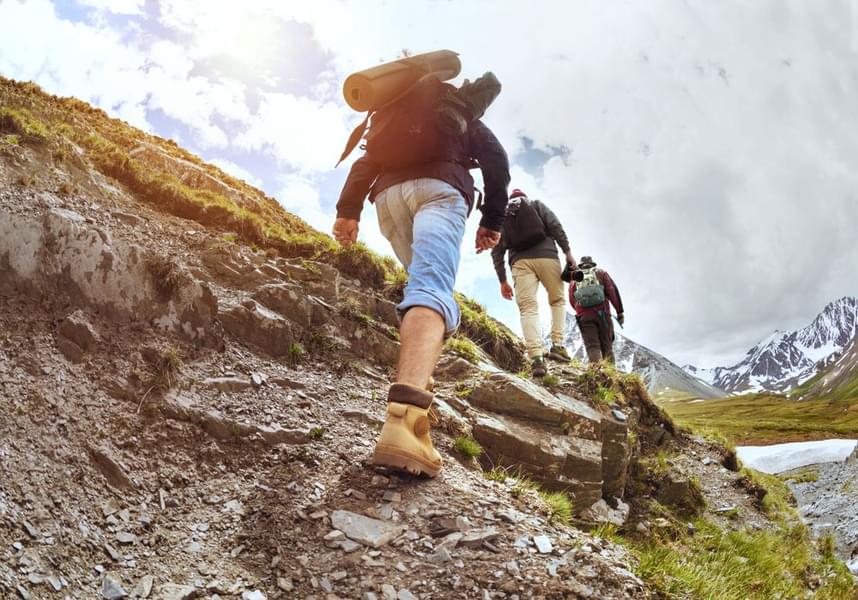
Summer (April to June): During this time, the weather is comparatively warm and there is no rain and snowfall. You will be able to enjoy trekking during these months as the temperature will be mild. Also, the weather is ideal for visiting the temple, sightseeing and indulging in activities. The temperature is around 17 degrees during these months.
Autumn (September to October): The weather during these months is favourable, making it ideal for trekking. You will be able to enjoy the scenic beauty of the surroundings with the clear sky while travelling during these months.
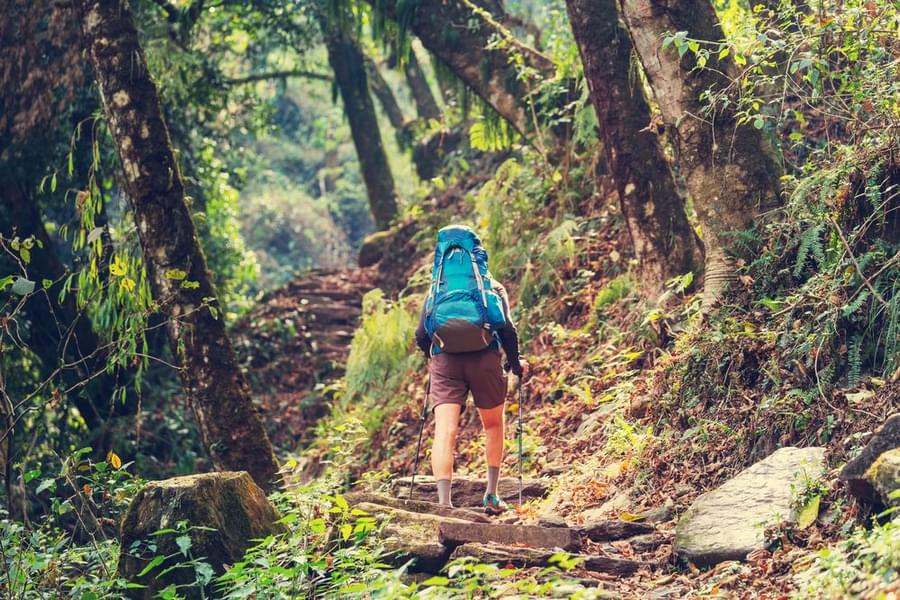
By Air: Rishikesh does not have an airport of its own but you can fly to its nearest airport, Jolly Grant Airport in Dehradun. The airport received daily flights from several major cities in India. You will need to travel for 35 km to reach Rishikesh from Dehradun. You can opt for a taxi or go for bus services available from Dehradun. The other alternative is to reach Delhi by flight and take a bus to reach Rishikesh.
By Road: Rishikesh is well connected with several cities and states by road by National Highway 58. You can get buses from Delhi, Haridwar, Dehradun and other places and reach one of the two bus stands of Rishikesh - the Main Bus Stand and the Yatra Bus Stand. Alternatively, you can also take a rented vehicle and travel by road. If you are traveling from Delhi, you can reach in 6 to 7 hours via Modinagar and Roorkee. Those traveling from Dehradun can also opt for a shared jeep.
By Train: Rishikesh has its own railway station but only few trains which run on a daily basis. Hence, it might be better to travel by train to Haridwar which is well connected with major cities of India. Once you reach Haridwar, you will need to travel for 25 km to reach Rishikesh by a bus or a taxi.
General Trivia About Kedarnath
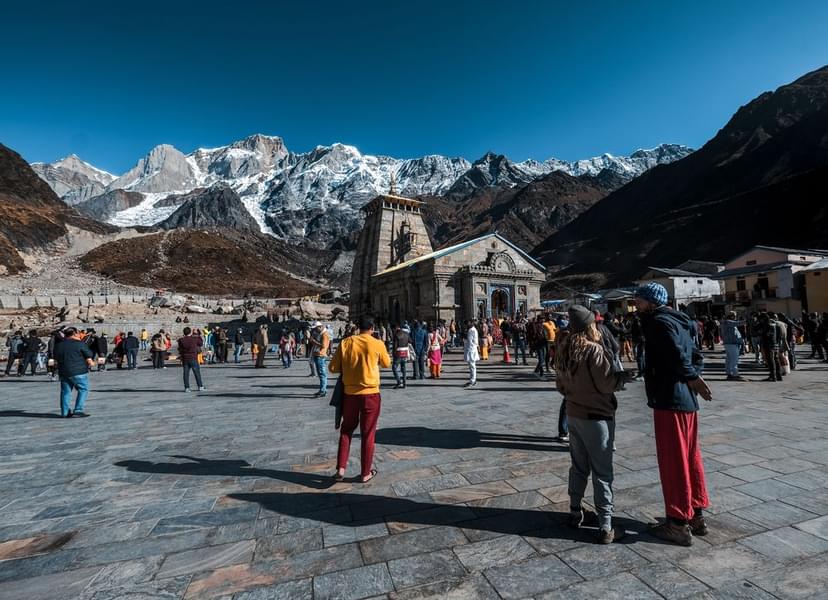
Kedarnath in local dialect means ‘lord of fields’, named after Kedar, the deity who is an incarnation of Lord Shiva who is considered to be the embodiment of all passions - love, fear, hatred, death and mysticism, expressed through his various forms.
Legend has it that Lord Shiva hid in a form of bull to avoid the Pandavas. One of the Pandavas, Bhima recognised him and tried to capture the bull from behind. But before Bhima could catch the bull, it disappeared, and later the hump of the bull appeared in Kedarnath and is worshiped since then.
Why to Go for Kedarnath Trek?
Going for the Kedarnath trek is one of the most popular and scenic treks in India, where you find beauty, peace, and amazing memories. It is a highly celebrated pilgrimage site and is one of the Chota Char Dham or Char Dham of Uttarakhand. The temple is located at an astonishing height of 3583 m and is very near to Chorabari Glacier, the birthplace of the Mandakini River. The whole area is covered with snow-capped mountains and is spectacular to look at. Once you start your journey from Rishikesh, you will be mesmerized by the stunning scenic view, first of the Ganges flowing along with you and then by the beauty of the famous Kedarnath Mountain. The trail is not too difficult, hence if you enjoy a good health condition, you can go for this trek, even if you are a novice.
FAQs of Kedarnath Trek
How difficult is the kedarnath trek.
Being at an elevation of 3583 m, Kedarnath trek may prove to be a moderate-level trek, which is strenuous for those trekkers who are beginners. Hence, it is strongly advised that they go for a medical fitness test to ensure that they are physically fit. They should also learn about altitude sickness and inform their trekking guides as soon as any symptom is noticed. People with heart, respiratory and blood pressure problems should not go trekking without a doctor’s advice. The trek is also not recommended for pregnant ladies. Those who feel that they will not be able to continue the trek for 5-6 hours may take a break at Bheembali or Linchauli and stay overnight and continue the journey the next day.
Is the Kedarnath trek safe?
Yes, the Kedarnath trek is very safe and reliable, in spite of being located at a high altitude. The government has taken initiative to build new trails and better safety protocols to ensure safety for all trekkers.
Can the Kedarnath trek be completed in one day?
Yes, it is possible to complete the trekking in one day. The trekking trail from Gaurikund to Kedarnath camp is 16 km and it takes 5 to 6 hours to reach there. If you start early in the day, it is possible to complete the trek in a single day. However, the Kedarnath trek is also adventurous and strenuous, so you will need to plan the trip as per your ability.
Can we do the Kedarnath trek at night?
No, as per Government norms, you can only do the Kedarnath Trek between 4 am till 1:30 pm. This timing has been set keeping in mind the safety of the travelers. So if you start late and cannot complete the trek by 1:30, you can make a stopover at Jungle Chatti, Bheem Bali or Linchauli and start your journey the next morning.
What clothing should I wear for the Kedarnath trek?
It is preferable to wear clothes which are comfortable. The best is to wear trek pants, t-shirts and a jacket. You must carry woolens as it will be chilly once you reach the top. Wear a head cover such as a cap to cover your head. Wear a sunglass for eye protection and wear sturdy well-fitted trekking footwear so that your feet do not hurt during the trek.
Where should I stay while trekking in Kedarnath?
There are several hotels and guest houses at Sonprayag as well as Gaurikund where you can stay before or after your trek. Guest Houses and cottages are also available at Kedarnath Base Camp for you to stay in once you reach the final destination. You can also stay at guest houses and dormitories near the temple as well. If you need to stop during your journey from Gaurikund to Kedarnath Base Camp, you can stay at accommodations available at Jungle Chatti, Bheem Bali or Linchauli.
What are the common mistakes that you need to avoid while trekking?
Do not carry too much weight.
Do not hike too fast or slow.
Do not wear clothes which can make you uncomfortable.
Do not go on the trek without consulting a doctor to ensure fitness.
Do I need to register with the Uttarakhand Government before going for the Kedarnath trek?
Yes, you will need to register with the Uttarakhand Government before going for the Kedarnath trek. You can either register online beforehand or register at Sonprayag before your trek.
More Treks in Himalayas
- Treks in Himachal
- Treks in Uttarakhand
- Weekend Treks in India
- Treks in Ladakh & Kashmir
- Treks in Nepal
- Treks in Sikkim
.png?w=auto&h=400)
The content and images used on this site are copyright protected and copyrights vests with the respective owners.
Wildcraft App
Easy Checkout & Free Shipping in App

- BULK ENQUIRY
Use code APP10 during checkout for additional 10% OFF (Applicable only for app transaction). Use code SAVE10 for additional 10% OFF on min cart of 1500 (Applicable only for mobile site and desktop transactions + Not applicable on Backpacks)

TOP SEARCHES
- RAIN CHEATER
- HIKING SHOES
- TRAVELCASES
- Jackets & Cheaters
- Sweatshirts & Pullovers
- Joggers & Trackpants
- Pants & Cargos
- Shorts & Cargo Shorts
- Shirts & Tshirts
- Rain Jackets
- Rain Suits & Ponchos
- Thermal Tops
- Thermal Bottoms
- Caps & Hats
- Mufflers & Gaiters
- Travel Cases
- Soft Trolleys
- Hard Trolleys
- Hybrid Trolleys
- Travel Gear
- Duffle Bags
- Duffle Trolleys
- Belts & Wallets
- Travel Accessories
- Technical Gear
- Sleeping Bags & Tents
- Laptop Backpacks
- Messengers & Portfolios
- Trousers & Trackpants
- Capris & Leggings
- WiKi Essentials
- WiKi Rainwear
- Campus Backpacks
- WiKi Boy Backpacks
- WiKi Girl Backpacks
- WiKi Junior Backpacks
- WiKi Slings & Messengers
- Wiki Disney Collection
- WiKi Accessories
- WiKi Lunch Bags
- WiKi Pencil Pouches
- WiKi String Bags
- Wiki Disney Accessories
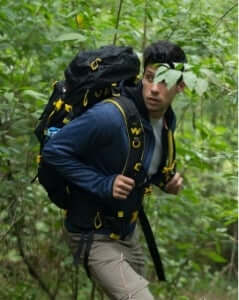
- Luggage Sizes
- Check-in Bags
- Teen's Packs
- Teen's Accessories
- Men's Clothing
- Men's Jackets & Cheaters
- Men's Sweatshirts & Pullovers
- Men's Tracksuits
- Men's Joggers & Trackpants
- Men's Pants & Cargos
- Men's Shorts & Cargo Shorts
- Men's Shirts & Tshirts
- Men's Rain Jackets
- Men's Raincoats
- Men's Rain Pants
- Men's Rain Suits & Ponchos
- Men's Essentials
- Men's Briefs
- Men's Trunks
- Men's Vests
- Men's Socks
- Men's Caps & Hats
- Men's Mufflers & Gaiters
- Men's Gloves
- Men's Thermal Tops
- Men's Thermal Bottoms
- Men's Supermasks
- Women's Clothing
- Women's Jackets & Cheaters
- Women's Sweatshirts & Pullover
- Women's Shirts & Tshirts
- Women's Trousers & Trackpants
- Women's Capris & Leggings
- Women's Rain Jackets
- Women's Raincoats
- Women's Rain Pants
- Women's Rain suits & Ponchos
- Women's Essentials
- Women's Socks
- Women's Caps & Hats
- Women's Mufflers & Gaiters
- Women's Gloves
- Women's Supermasks
- Teen's Clothing
- Teen's Essentials
- Men's Shoes
- Hiking & Trekking
- Even Terrain Running
- Travel Sandals
- Women's Shoes
Kedarnath Trek - A Complete Travel Guide & Tips

Introduction
The best time to visit, the trek itinerary, highlights of the journey, things to keep in mind, things to carry, frequently asked questions (faqs), what is required for kedarnath trekking.
The Kedarnath trek is of moderate difficulty and would require you to carry: A 20-30L capacity rucksack, warm clothes ( jackets , windcheater, and thermal wear), accessories like head gear, gloves, and muffler, personal medical kit and rain cover.
How difficult is the Kedarnath trek?
It is quite easy to cover the Kedarnath Trek, especially since there are multiple transport options available there to make it smoother.
How long is Kedarnath trek?
The Kedarnath Trek covers a distance of 16km and takes almost 6 hours to complete.
Which month is best for Kedarnath?
April-June is the best month to undertake the Kedarnath Trek as the days are quite pleasant, with temperatures ranging between 15 and 25°C with cool breezes.


- Group Tours Calendar
- Planning, Sightseeing & Routes
- Preparing for Ladakh Trip
- Stay, Eat, Permits & Others
- Taxis, Self-Drives & Bike Rentals
- Public Transport & Budget Travel
- Preparing for Spiti Valley Trip

Kedarnath – How to plan a trip [Complete Travel Guide]
Kedarnath is a divine Hindu settlement situated in Rudraprayag district of Uttarakhand. It is one of the Char Dhams located in the Himalayas, and is situated at an astounding height of 3584 meters above sea level near the head of Mandakini River.
The Kedarnath temple lies amidst the majestic snow-capped Garhwal Himalayan ranges and is thronged by thousands of tourists and pilgrims each year. Also, the Kedarnath trek is stunningly beautiful and quite eclectic, even in the trekking circuit.

Famous for the ancient shrine devoted to Lord Shiva, it offers a calm atmosphere with a beautifully painted backdrop thanks to the rhododendron woods, snow-covered mountains, and splendid sights of nature. An amalgamation of devoutness and adventure is what makes it incomparable. A MUST VISIT for one and all.
Let's quickly dive into the details:
About Kedarnath
Kedarnath literally means the Lord of the field, and it is so called because the “crop of liberation” grows here. While it is not certain who constructed the temple or when! One of the earliest references of Kedarnath is in the 7th or 8th century. It is also believed that Adi Shankara died near the sanctuary.
History & Mythology
It is believed that post the battle of Kurukshetra, Pandavas went on a journey to Banaras in order to repent killing their own and seek blessings from the Lord. But, Shivji wanted to avoid meeting with the brothers, and thus, took solace in Guptakashi.
However, Pandavas were relinquishing in their search for the Lord and when they found him, Shivji decided to take the form of buffalo so that they couldn’t recognize him. Now, when Shivji saw the Pandavas approaching closer, he wanted to hide even further.
Thus, He took the decision to also become invisible by way of going underground. However, brother Bhīma tried hard to stop him from leaving by holding on to the legs and tail of the bull. Unfortunately, the Lord dived and evaporated at that place leaving behind his hump which is now worshipped at Kedarnath Temple.
It is however believed that through cosmic energy, the Pandavas were exempted from their sins and Shivji informed that from then onwards He would be present in Jyotirlinga form at Kedarnath.
Located in the Rudraprayag district, Kedarnath is the most remote of all Chota Char Dham sites. Situated near the Chorabari Glacier – the source of the Mandakini river, Kedarnath is flanked by snow-capped peaks – most prominently the Kedarnath mountain (6,940 mts) and the Kedar Dome (6,831 mts). Located at a distance of 223 KM from Rishikesh, the town is built on a barren stretch of land on the shored of the river.
The town unfortunately suffered extensive destruction during 2013 due to flash floods caused by torrential rains in Uttarakhand. The temple magnificently survived the harsh calamities!
In line with the Himalayan weather, Kedarnath experiences cool summers while the winters are extremely difficult and harsh. Summer is ideal for all sight-seeing, temple visits and experiencing nearby attractions as well. The average temperature is around 17 degrees in the summer.
Monsoon months are difficult and the area has suffered extreme rainfall many times, particularly in 2013. Monsoon weather is around 12 degrees. Winters are cold, complex and inhabitable. The palki of Lord Kedarnath is transferred to its winter abode near Guptakashi – Ukhimath from November to April. Weather in this season is always in the negative!
Dheeraj Sharma
Best time to visit Kedarnath
Right at the beginning of the season in April till the onset of monsoons and post-monsoon till close of the season. Kedarnath has a cold climate for most part of the year and the best months to travel are May, June, September, October.
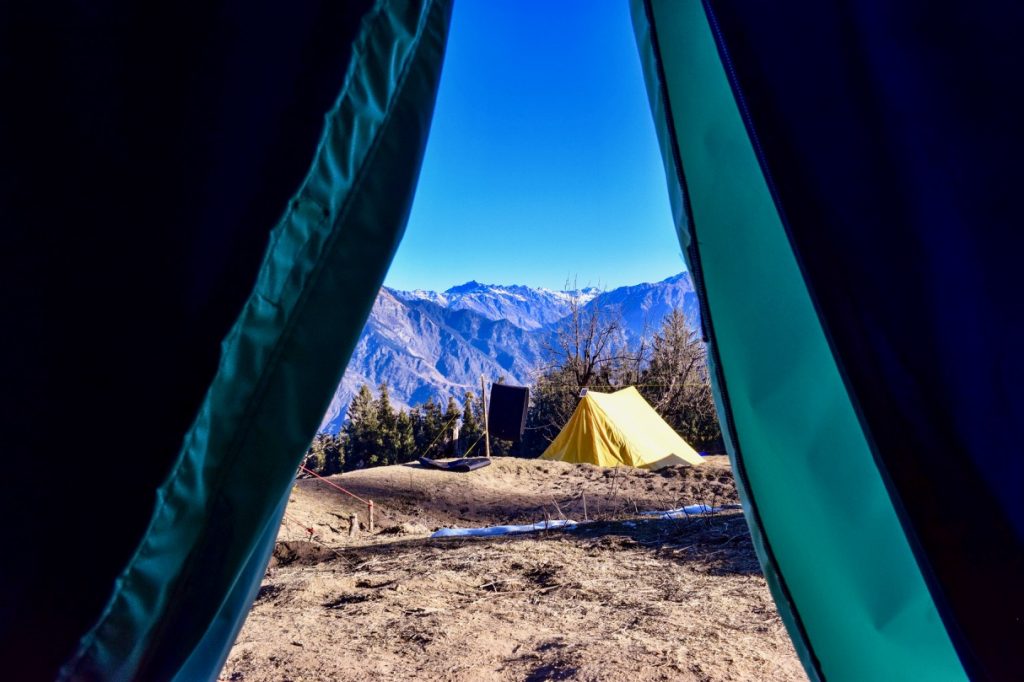
How to get there
Kedarnath is well connected with most of the important towns of Uttarakhand. The nearest road head to Kedarnath is about 18 KMs later, Gaurikund.

Jolly Grant Airport, Dehradun is the closest airport, at a distance of 238 KMs. The airport is well connected to Delhi with daily flights. Taxis are easily available from the airport to Gaurikund.
The nearest railway station to Kedarnath is Rishikesh, at a distance of 216 KMs before Kedarnath on NH58. Further, Gaurikund is well connected by motorable roads with Rishikesh. Taxis and buses are easily available to reach Gaurikund.
Prior to reaching Kedarnath, the last motorable point is Gaurikund. From there on out, you’ll be trekking for 16-odd-km. Gaurikund is connected with major destinations in North India. Buses and shared cabs are available from Haridwar, Rishikesh & Rudraprayag to Sonprayag, the last point until which private vehicles are allowed.
Buses to Rishikesh and Shrinagar are available from ISBT, Kashmiri Gate. From Sonprayag, there is a shared cab facility offered by the government, where the cab will drop you in Gaurikund for a fee.
Helicopter Options
You may even get a helicopter ride if you’re not into trekking (although I strongly recommend the trek!). The services are available from different helipads such as Guptkashi, Sersi, Phata etc.
What to do in Kedarnath
Given that Kedarnath is a religious destination, clearly the centermost attraction are places with mythological connotations.
Kedarnath Temple
Enveloped in the mighty Garhwal Himalayas, the Kedarnath Temple is one of the twelve Jyotirlingas of Lord Shiva. Dedicated to Lord Shiva, Kedarnath Temple is among the 275 temples of Paadal Petra Sthalams (the most powerful Shiva temples in the world) and is also the most important among the Panch Kedars.
With fresh air synonymous with the hills and stunning views that you have to earn – you will lose all sense of time here! For thousands of year, this place has been worshipped and the energy of the region is that of positivity, hope and beliefs for the future.
Inside the temple, you’ll be greeted with a small hall with images of Parvati as well as the Pandavas. The hall is decorated with statues of Krishna, Pandavas, Draupadi, Virbhadra and many other deities! There is a conical rock inside the temple which is worshipped as the Sadashiva (forever Shiv).
Made from grey stones which are interlocked with the use of iron clamps – the temple is truly striking in the backdrop of Himalayas.
Gandhi Sarovar
Gandhi Sarovar is a small crystal clear lake, also known as Chorabari Tal. This is so because it is situated on the mouth of Chorabari Bamak glacier. Gandhi Sarovar lies on the foot of Kedarnath and Kirthi Stambh peak at an astounding altitude of 3,900mts above sea level. The lake comes after completed further 4 KMs trek from Kedarnath Temple.
Kalimath is a religious place located on the banks of Saraswati river. Located at a height of 1800 mts, Kalimath is one of the 108 Shakti Peeths in India. Kalimath lies on lap of nature offering salubrious and divine environment. Goddess Kali Temple is located in Kalimath. Legends believe that after killing Raktbeej, Kali Goddess went underneath the ground at this place!
Bhairav Temple
Bhairavnath Temple or Bhairon Baba Mandir is situated south of the Kedarnath temple on the eastern hill of the lofty Himalayas of Uttarakhand. The temple is dedicated to Bhairav – the fierce manifestation of Lord Shiva associated with destruction and devastation. The temple offers some stunning views of the Himalayas and it is a beautiful portion of your journey to Kedarnath!

Gaurikund Temple
Gaurikund temple is a temple dedicated to Goddess Parvati. According to myths and legends, this is the place where Goddess Parvati did penance involving ascetic and yoga practices to win over Shiva’s heart. It is believed that Lord Shiva admitted his love for the Goddess here and they then married at Triyuginarayan temple.
Shankaracharya Samadhi
Adi Shankaracharya was a philosopher, credited with unifying and establishing the main thoughts in Hinduism. At the age 32, he decided to attain moksha at Kedarnath and merged under with the land near the Kedarnath Temple. The samadhi is situated right behind the temple.
What to do around Kedarnath
There is so much to explore around the Kedarnath Temple. So, remember to keep some time at hand to truly immerse yourself into the experience!
Vasuki Tal Lake
Vasuki Tal is a high glacial lake situated at an impressive altitude of 14,200 feet above sea level near Kedarnath Dham. One can spot Brahma Kamal and other Himalayan flowers blooming around the placid lake, making for some spectacular views.
Ideally, I would suggest you complete the route in the day time itself, and spend the night at Kedarnath! The trek distance from Kedarnath temple is 8 KMs, initial 3-4 KMs is easy before the ascend begins. The icy Vasuki Tal is just 900 meters downhill from Vasuki top.
Guptkashi is situated 47kms before the holy shrine of Lord Shiva, Kedarnath. It is located on the route to Kedarnath on a ridge on the west side of the Mandakini river valley at an elevation of 1,319mts above sea level.
Guptkashi is a religiously important town of Uttarakhand as it houses ancient temples like Vishwanath temple and Ardhnareshwar temple. A highly revered attraction, Manikarnika Kund is where two streams of the Ganga and Yamuna meet.
Kedarnatha Trek
Kedarnatha trek is in one of the most significantly religious areas, especially in the Hindu Mythology. The Temple of Lord Kedarnatha (Shivji), which sits at the base of the summit, has stood the test of time and is revered amongst spiritual believers.
Millions of pilgrims move mountains to offer their prayers and seek blessings of the Hindu Deity each year. The temple itself lies at the base of the Kedarnath Peak, facing the Kedar Parvat. A beginner level trek, Kedarnath is especially beautiful in the winter months.
One of the most remarkable crests in the Himalayan region, both nature lovers and ardent trekkers tend to enjoy the experience.
Char Dham Yatra
The Chota Char Dham Yatra of Uttarakhand is the four abodes of holy shrines – Badrinath , Kedarnath, Yamunotri, and Gangotri . All four of these temples are situated within the Garhwal region of Uttarakhand. The prominence of the Charm Dham Yatra is immense amongst Hindus.
Moreover, it is believed that every Hindu should do Char Dham Yatra at least once in their lifetime. The Great Reformer and Philosopher, Adi Shankaracharya, gathered together these Holy Pilgrimage places into a spiritual circuit around the 8th century.
Generation followed generations and hundreds of thousands of devotees have kept up the tradition of covering these pilgrimage spots every year. Thus, it is very common to complete the circuit in one religious pilgrimage!
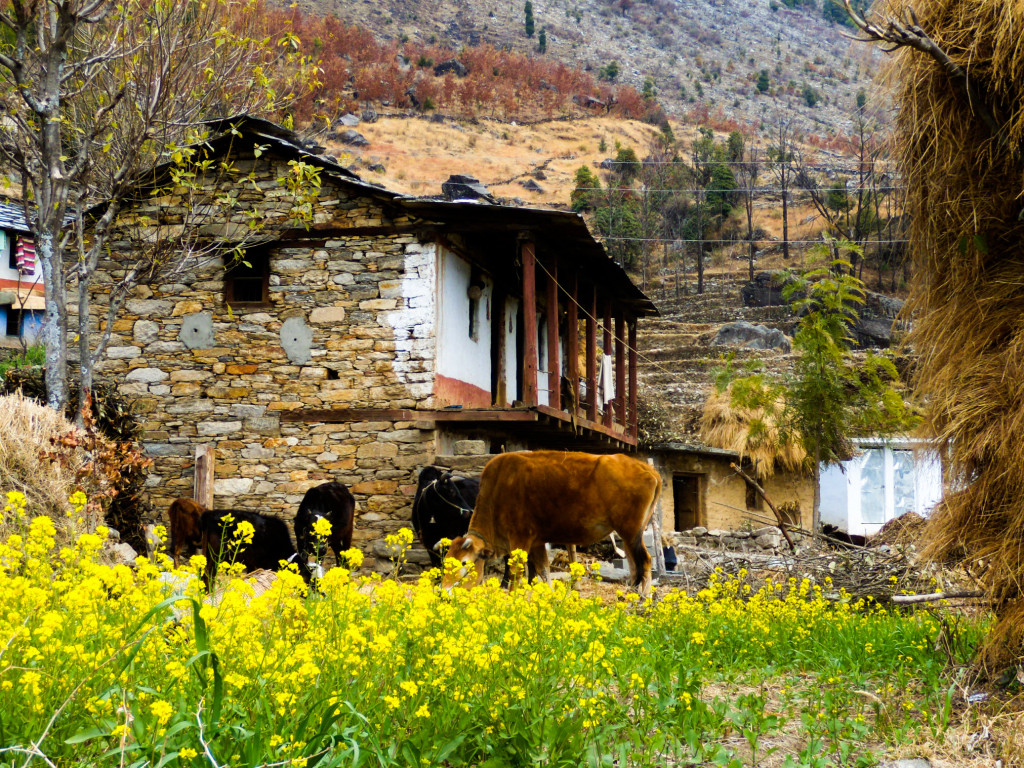
Best places to stay near Kedarnath
There is a huge government-run tented colony along with cottages as well as rooms run by GMVN. These are sufficient to home more than a thousand pilgrims and visitors. Also, there are hotels, guest houses, and Dharamshala as well.
A lot of folks have started taking the journey via helicopters and thus stay locations can be Phata, Rampur, Gaurikund, Sitapur etc.
Best places to eat
Unfortunately, the only option for decent food here is the food stalls and roadside dhabas. Food available is mostly north Indian cuisine. Of course, given the highly revered place in Hinduism that Kedarnath holds, it should come as no surprise that alcohol and non-vegetarian food is not served/ is prohibited.

Things to keep in mind
- As instructed by the Uttarakhand government, it is necessary for every traveler to do bio-metric registration. The facility is available online as well. Alternatively, you may also do the same at Sonprayag.
- You can easily find mules & porters to accompany you on your journey. Do remember to check the prices officially posted so as to avoid paying a larger sum
- Also, if you are hiring porters or mule owners – remember to check their official IDs
- It is always wise to avoid the hilly terrain in the monsoon season. Especially given the tragedy of 2013, and how badly Kedarnath was hit. If you are still heading there in the monsoon period – do check with officials and local authorities
- Photography is not allowed in the temple premises. Be mindful of the fact and abide by the rules of the temple authorities.
Tips when travelling to Kedarnath
- The trek is 16 KM long and will take you 6 hours, depending on your health
- Try to start your trek early in the morning to avoid the harshness of the afternoon sun
- Remember to eat a hearty (though not heavy) breakfast
- Drink water and stay hydrated. However, do remember to carry your own water bottles.
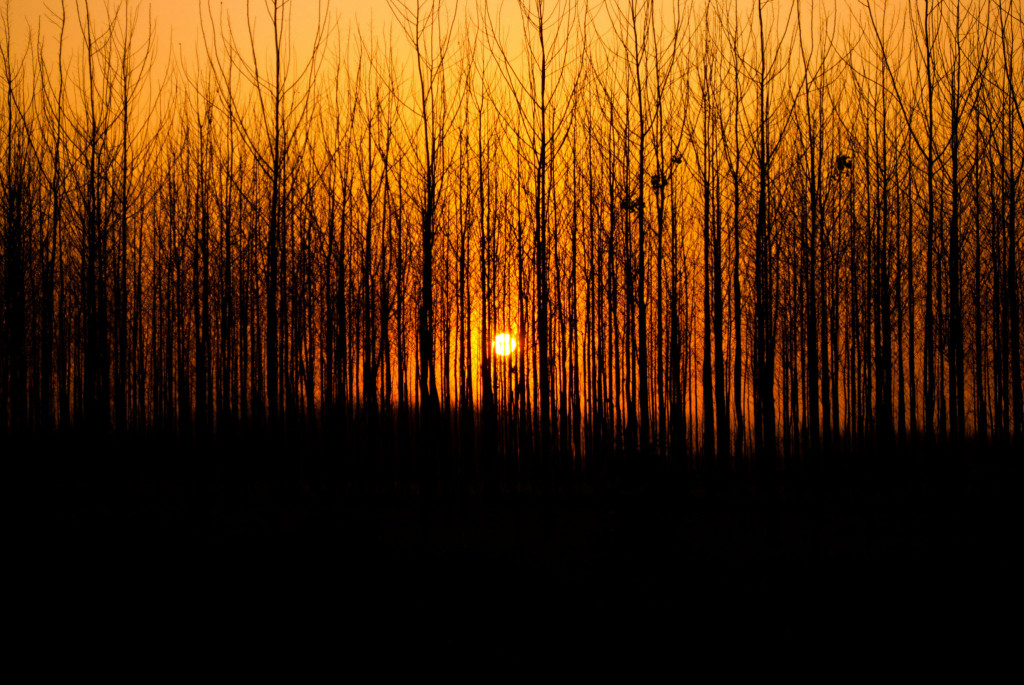
If connecting with nature and the Gods, rejuvenation and some adventure is on the cards for you on your next holiday – head on over to Kedarnath. This place will take you back to a time of simplicity and authenticity.
You will fall in love with the quaint life of the hills and revered by the sheer power of belief. If you have any questions regarding this beautiful wonderland – do comment below and I will be happy to answer any of your queries.
Happy travelling!
Shefali spends most of her time day dreaming about her next big vacation. A happy-go-lucky personality, she is an amalgamation of all the places she’s lived in and experienced! She is always confused as to where to call home, having lived in Chandigarh, Shimla, Dehradun, Mumbai, Hyderabad in India and Vancouver, Abbotsford in Canada. Her love for travel is only challenged by her love for reading and eating delicious food! In order to sustain her dreams, she brought out her inner geek, got an MBA and has a job in the corporate world crunching numbers. Do follow @notravelplans on Instagram for updates on her next great adventure.
Related Posts
Garhwal in uttarakhand – most common itinerary [day by day plans], harsil – gangotri trip | most common itineraries [day-by-day plans], mukteshwar in uttarakhand – the most complete travel guide.
Comments section gets closed in 90 days. To ask your travel questions, you can follow my YouTube Channel for a faster reply or for a much slower reply follow me on Instagram . :)
Hi Shefali, Your article about Kedarnath is really good and contains all the necessary details to plan a trip there. However, I had one query – is it a good idea to plan the trip in the 1st or 2nd week of July this year? Actually I am having some other schedule in May, June and in September and October 2021. So, thinking of going there in July 1st or 2nd week.
July shall be fine to visit Kedarnath, just keep a check on the weather and usually, it shall be OK to visit before mid of July
Type above and press Enter to search. Press Esc to cancel.
Privacy Overview
Ad blocker enabled.

A Guide for Kedarnath Trek

Kedarnath Route Map
Planning to go for the Kedarnath Yatra ? If yes then make sure you have a complete guide for the 18 km long Kedarnath Trek and thus enable yourself to have a journey that is satisfying and fulfilling both in terms of divinity and comfort. If you are looking for a travel guide for the Kedarnath Trek then look no more as we have prepared for you a complete catalogue of the Kedarnath Trek that will make your journey to Kedarnath easy and joyous.
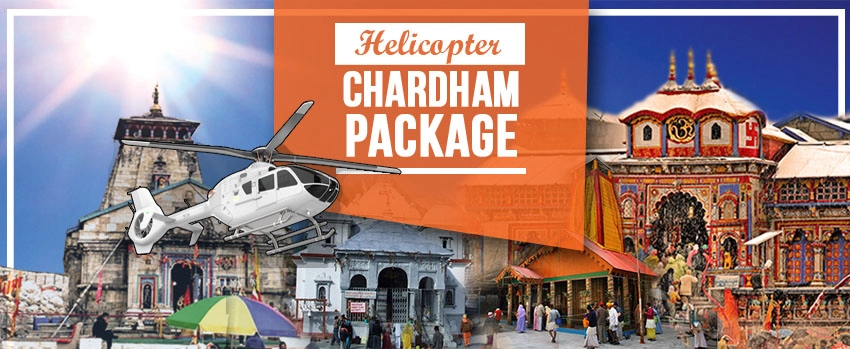
Visit Kedarnath by Road (Till Sonprayag)
To reach at Kedarnath by road you need to book a taxi or bus service which can be privately run or by the GMOU ltd. To reach at Kedarnath from Delhi you need to travel till Dehradun for which you can choose any medium be it road, rail or airways. From Dehradun travel till Haridwar and from Haridwar the following route will be your Guide to the Kedarnath Trek.
New Delhi to Haridwar 206km >> Haridwar to Rishikesh 24km >> Rishikesh to Devprayag 74km >> Devprayag to Srinagar 34km >> Srinagar to Rudraprayag 33km >> Rudraprayag to Gaurikund (via Tilwara-Agastmuni-Chandrapuri >> Kund >> Guptkashi >> Phata >> Sitapur >> Sonprayag) 74km >> Gaurikund to Kedarnath (by trek) 18km.
You can also visit Kedarnath from Delhi by boarding a direct bus from Delhi Bus Stand Kashmiri Gate to Gaurikund which is run by the Uttarakhand Transport Corporation. From Gaurikund further continue your trek to Kedarnath.
Visit Kedarnath by Air
To reach Kedarnath by air you can book a seat for yourself in a helicopter. If travelling by a helicopter till Kedarnath you can from Dehradun as well as Haridwar and Rishikesh .
From Dehradun- travel till the Shastradhara Helipad in Dehradun. The Helicopter will drop yoiu at your destination within a time period of 40 minutes.
From Haridwar/Rishikesh- If you are planning to travel to Kedarnath from Rishikesh/Haridwar via Helicopter then travel from Haridwar/Rishikesh till Phata via taxi which is at an approx distance of 200km and 195km respectively.
Kedarnath Trek Guide – How to Reach Kedarnath by Trek
After you reach till Sonprayag you will have to travel in a shared cab which charges Rs 20 per person this cab will take you till Gaurikund, Further from Gaurikund the trek to Kedarnath begins the directions of which are listed below as your Guide to Kedarnath Trek.
Kedarnath Trek Distance
The trek to Kedarnath is a 18 km trek which starts from Gaurikund till Kedarnath. The trek has changed since the 2013 flood disaster in Uttrakhand and since then the 14 km trek to Kedarnath has increased to a 16km trek.
Route Map of the Kedarnath Trek
The Kedarnath trek is a 18 km trek which starts from Gaurikund. Earlier the route followed was from Rambara, it was a well developed, well fenced and a facilitated trek route. However the Gov has now changed the trek Route of Kedarnath after the 2013 disaster as the old trek route to Kedarnath was completely erased. The New Trek Route to Kedarnath is given below which will be your Travel Guide to Kedarnath Trek .
- Reach at Gaurikund (6km approx) through shared taxi from Sonprayag
- Gaurikund to Jungle Chatti(6km) through the Rambara Bridge.
- Jungle Chatti to Bheembali (4km)
- Bheembali to Linchauli (3km)
- Linchauli to Kedarnath Base Camp (4km)
- Kedarnath Base Camp to Kedarnath Temple (1km)
Features of the Kedarnath Trek
The Kedarnath Trek is a 18km medium to steep trek which requires a good level of physical fitness. Before going for the trek every pilgrim has to get themselves checked that whether they are capable of trekking or not. Timings of Kedarnath Trek from Gaurikund commences from 04:00AM in the morning till 01:30PM. This timing is fixed because Kedarnath is located in the Kedarnath Wildlife Sanctuary and therefore the pilgrims are not allowed to trek anytime. No pilgrim is allowed to leave after this specific time. These are high altitudes trek so it is advisory for the ones with respiratory problems to first consult with a doctor before trekking.
Facilities at the Kedarnath Trek
The Kedarnath Trek facilities include the services of Palki/Dandi, Kandi & Mule/Ponies. Anyone can book these services from the booking counter at Gaurikund/Sonprayag. Different distances have different rates such as the Gaurikund to Kedarnath Dandi will cost Rs 4450, Kandi will cost Rs 3350 and the Poni will cost Rs 4100. In the midst of the trek there are proper facilities of tented accommodation, drinking water and small shops/ restaurants are also there in the trek route. There is also Helicopter services from the Kedarnath helipad to Phata and other helipads.
Things to Remember Before Going on the Kedarnath Trek
- Do get a check up before going on the trek to Kedarnath.
- People with Respiratory disorders and High Blood Pressure should not trek to Kedarnath.
- If you want to travel through Kandi, Ponies and Palki make sure that the prior booking is done at Gaurikund/Sonprayag booking counter.
- Trek between 04:00AM to 01:30PM as this is the only time when pilgrims are allowed to trek to Kedarnath.
- In case you won’t be able to cover the trek till late evening you can take Palki or Ponies to reach to your destination. You can also stay in the camps which are set up in between the trek at Jungle Chatti, Bheem Bali and Lincholi for a night and start journey next morning.
So here is a Complete Guide to Kedarnath Trek for you which will help you to analyze and go for your Kedarnath Yatra, making it more divine and comfortable.
Get Tour Details
Add comments and suggestions or ask questions about "a guide for kedarnath trek".
We would be glad if you can comment below and provide your valuable suggestions and feedback on A Guide for Kedarnath Trek. If this A Guide for Kedarnath Trek page have any wrong information/list or out of context content, then you can report us as well.
If you have any questions, you can also ask as in the following comments section. Our team will try to provide you answers/solutions.
Why the prices are not as per the MRP? And why the prices of room is too high no fixed price, no proper facilities, they are cheating the pilgrims, shared taxi in which 12 people has to sit otherwise they will wait there. The trek is full of donkey sit all the way
What is the height at base camp and pick at kedarnath
Can we visit Kedarnath, Badrinath, gangotri and yamunotri
I am Heart patient should i go kedarnath after check up
Yes you can go if you are fit, The trek is too steep if you are planning then take proper medicine along with you
Is the Kedarnath trek open a day before temple opening? I want to go there on 8th May and stay overnight to offer prayers next day. The temple opens on 9th May. Can I trek on 8th May?
Yes, trek will be open by then.
Thanks for the question even i am trekking on 8th will see you

Destinations
Char dham yatra tour packages.
- Char Dham Packages
- Badrinath Packages
- Kedarnath Packages
- Gangotri Packages
- Yamunotri Packages
- Teen Dham Tours
- Do Dham Packages
- Chardham Helicopter Packages
- Chardham Leisure Hotels
- Fixed Departure Tours
- GMVN Tour Packages
- Hemkund Tours
- Winter Chardham Packages
- Chardham Packages 2024
Char Dham Hotels
- Chardham Hotels
- Hotels in Badrinath
- Hotels in Kedarnath
- Hotels in Gangotri
- Hotels in Yamunotri
- Hotels in Barkot
- Hotels in Joshimath
- Hotels in Auli
- Hotels in Srinagar
- Hotels in Devprayag
- Hotels in Guptkashi
- Hotels in Harsil
- Hotels in Ukhimath
- Hotels in Uttarkashi
- Hanumanchatti
- Rudraprayag
- Sayanachatti
- Srinagar Garhwal
- Karanprayag
- Jankichatti
Packages
tours, book now.
A Complete Guide for Kedarnath Trek
Are you planning on taking the Kedarnath Yatra? If yes then make sure that you are equipped with the right knowledge about your destination which will take you through one of the most spiritual and holy pilgrimages of 16 kms to this holy temple. This guide will allow you to enjoy the Yatra journey in complete comfort and allow you to have a tranquil experience. Here is a detailed guide to a journey of a lifetime that will make your Yatra even more easy and joyous.
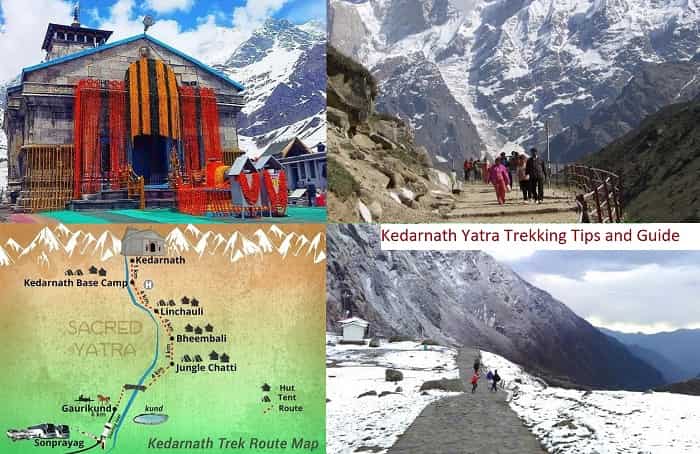
How to Reach Kedarnath by Road (up till Sonprayag):
In case you are planning to reach Kedarnath via a road journey then you will be required to book a taxi or bus service that are run privately by the GMOU ltd. In order to reach Kedarnath Dham from Delhi you will be required to first reach till Dehradun either by road, train or by air. From Dehradun you will be making your way to Haridwar and from this holy city you will be taking the route heading for the path leading to the Kedarnath trek.
Here is a brief route map that you will be taking on your journey to Kedarnath from Delhi:
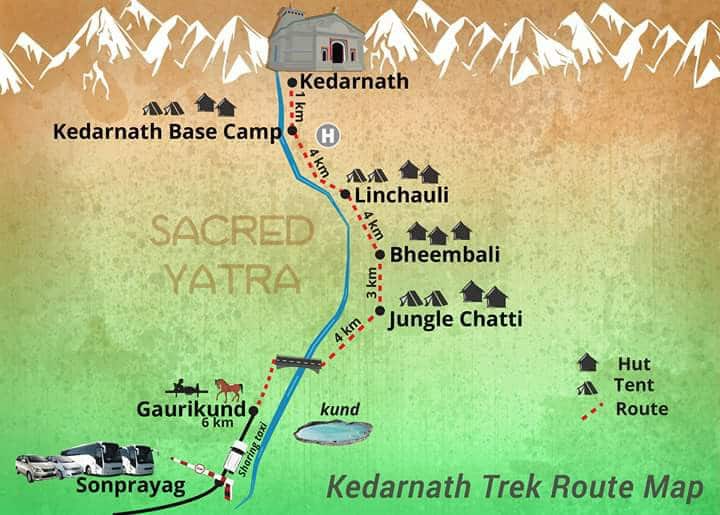
New Delhi – Haridwar (206 km) – Rishikesh (24 km) – Devprayag (74 km) – Srinagar (34 km) – Rudraprayag (33 km) – Gaurikund (via Augustmuni – Guptkashi – Phata – Sitapur – Sonprayag 74 km) – Kedarnath by trek (16 km)
You can also make your way to Kedarnath Dham by taking a direct bus from the bus stand at Kashmiri Gate in Delhi that will drop you to Gaurikund. These services are run on a regular basis by the Uttarakhand Transport Corporation. Once you reach Gaurikund you will be completing the journey on foot via trekking up to the main temple of Kedarnath.
How to Reach Kedarnath by Air:
In case you decide on taking up the Kedarnath Dham yatra journey by air then you have the option of availing the Kedarnath helicopter yatra service. This service can be undertaken from Dehradun, Haridwar as well as Rishikesh.
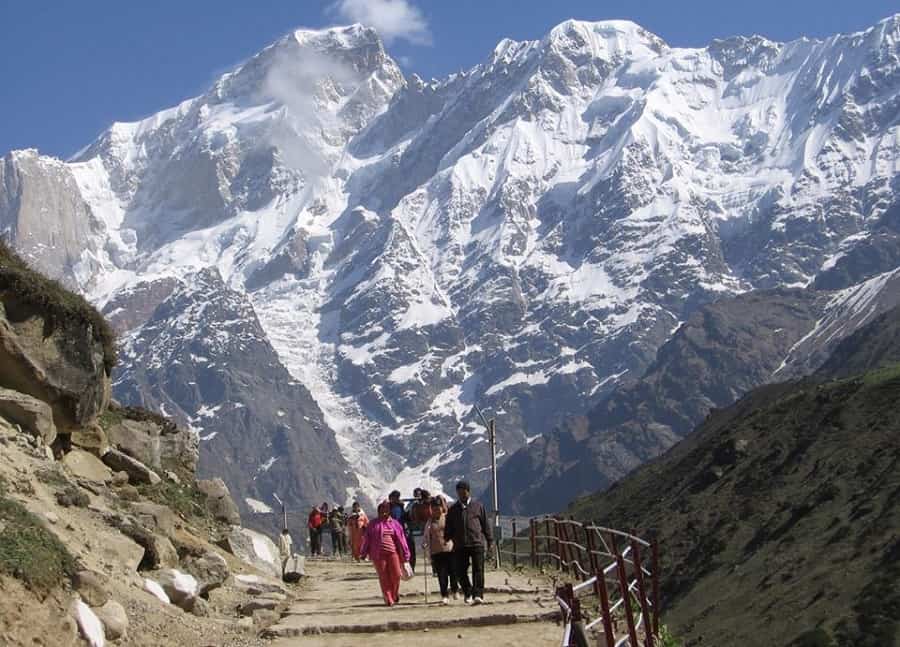
From Dehradun – You will be traveling till Sahastradhara helipad at Dehradun from where the chopper service will drop you till your final destination within 40 minutes.
From Haridwar / Rishikesh – I case you decide on traveling to Kedarnath from the holy cities of Rishikesh / Haridwar via a helicopter journey then you will be traveling from Haridwar / Rishikesh to Phata via a taxi service which will be covering a distance of almost 200 kms.
How to Reach Kedarnath via Trekking:
Once you make your way till Sonprayag you will be required to travel in a shared cab that charges Rs. 20/- per person and is one of the cheapest ways of traveling. This shared cab will take you to Gaurikund and once you debark at Gaurikund your trekking journey to Kedarnath will commence and given below are the detailed directions for Kedarnath trek.
Trekking Distance for Kedarnath:
The trekking journey to Kedarnath is an overall distance of 16 kms that starts from Gaurikund and concludes at Kedarnath Dham. The trekking routes had changed and rebuilt ever since the sudden and devastating flash flood disaster had hit this region in 2013.
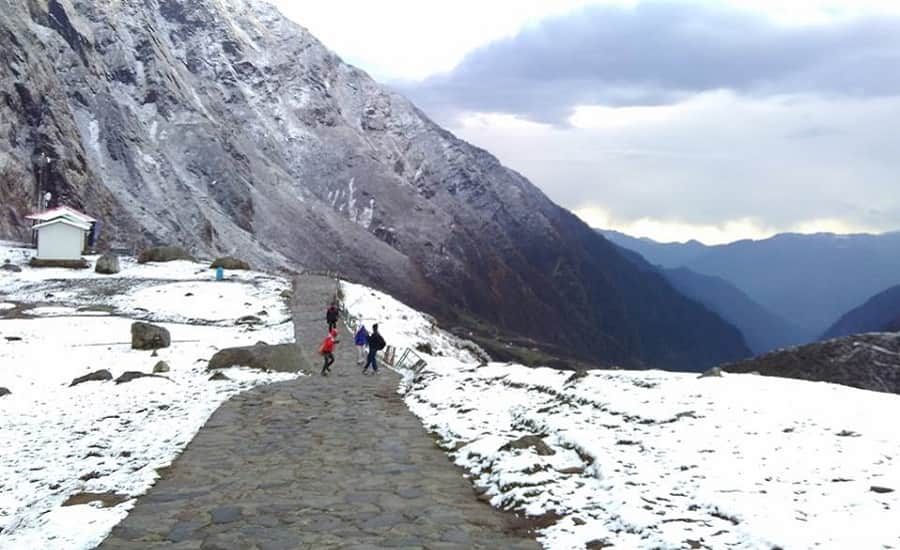
Here is a Detailed Route Map of the Trekking Journey to Kedarnath:
The 16 kms of the trekking journey to Kedarnath Dham commences from Gauri Kund. Earlier, prior to the disastrous flood, the trekking route had made its way through Rambara which was well developed with strong fencing and properly facilitated routes. However, now the government has made changes in this route leading up to Kedarnath Dham by creating a new trekking trail and now the old trekking route is now completely erased.
Given Below is the New Trekking Route for Kedarnath Dham:
- Reach Gaurikund via taxi from Sonprayag (approx. 6 kms)
- Gaurikund – Jungle Chatti via Rambara bridge (4 km)
- Jungle Chatti – Bheembali (3 km)
- Bheembali – Linchauli (4 km)
- Linchauli – Kedarnath base camp (4 km)
- Kedarnath base camp – Kedarnath temple (1 km)
Important Features of Kedarnath Trek:
The 16 kms of trekking distance that leads up to Kedarnath temple requires the pilgrim to be tough and a good level of physical fitness, therefore, prior to commencing the trekking journey each pilgrim should get themselves properly checked up and get to know if you are eligible to complete this trekking journey or not. The Kedarnath trek from Gaurikund starts at 4 am early in the morning and goes on till 1:30 pm in the afternoon and these timings are fixed since Kedarnath Dham is located inside the Kedarnath wildlife sanctuary and this is the reason why pilgrims are not allowed to trek any time after this. After the said time no pilgrims are allowed to leave. Since this trekking journey is high altitude and it is advised to the pilgrims who are suffering from respiratory problem should consult the doctor prior to taking up the trekking journey.
Facilities at Kedarnath Trek:
The Kedarnath trek is equipped with a number of facilities and services like Palki or Doli, Kandi, and mules or ponies that serve as alternate methods of travelling to main Kedarnath Dham. People can book these services at various booking counters at Gaurikund or Sonprayag. The cost for the services differ with distance covered for example – a Palki service from Gaurikund to Kedarnath will cost around Rs.4,450/-, a kandi service will cost you around Rs.3,350/- and a pony journey will cost you around Rs. 4,100/-. Amidst this entire trekking journey there are various proper services available in the form of tented accommodation, clean drinking water as well as small shops, restaurants and Dhabas. Helicopter services are also available from the helipad at Kedarnath to the helipad at Phata and others.
Things to Remember Prior to Going on Your Trek to Kedarnath:
- Prior to going on Kedarnath trek you should get a complete medical checkup done.
- People suffering from respiratory disorders and high BP problems should not go on this trekking journey to Kedarnath Dham.
- In case you decide on travelling to the Dham via a Kandi, pony or a palki then make sure that all your bookings are done way before hand at the booking counter present in Gaurikund or Sonprayag.
- The pilgrims are permitted to trek only between 4 am and 1:30 pm as per the government rules.
- In case you have some time constraints and you won’t be able to cover the entire trekking route then you can take the services of palki or ponies to get to your destination. You also have the option of staying in camps or tented accommodation that are present along the trekking routes of Jungle Chatti, Bheembali and Linchauli for the night and you can start your journey, early in the morning next day.
Trekking Tips and Guide
- Gaurikund is the place from where you can hire a palanquin or a pony service to kedarnath which can be availed by paying a fixed rate to the porters directly which will cut down on your walking journey. If you hire some alternative travel options form someone other than the government approved ones then make sure that they are registered with a government number.
- Per pony only up to 10 kgs of travel luggage is permitted and in the same way only 5 kgs of luggage is allowed in Helicopter services in kedarnath. This is done to regulate the weight distribution and make the journey eventually a comfortable experience for you.
- Remember that the temple is situated at a height of 11,000-12,000 feet above sea level and it is not a good idea for people suffering from respiratory or heart diseases to make the journey due to low oxygen levels in the air there. You can choose to make yourself fit for the journey by practicing pranayama, breathing exercises, yoga or other forms of physical activity to prepare yourself for these difficult conditions.
- At all costs avoid wearing sarees for the journey since it will definitely cause a hindrance to your holy journey. You can choose to wear salwar kameez along with a good pair of sneakers and spots shoes which will make your walking comfortable and you will be able to cover larger distances this way.
- Remember while trekking to Kedarnath not to tire you out or exert yourself too much. Do not lose your breath while walking and halt if you think that you are experiencing shortness of breath. To deal with this you should practice the famous breathing of Anulom Vilom on a daily basis till the commencement of the journey.
- You will definitely get hungry on your way which can be dealt with if you are carrying some packaged food items or dry fruits along with you. The routes are also lined with food stalls and eateries from where you can acquire drinking bottled water.
Overall Experience
Honestly speaking, the trekking journey will be extremely testing if you are not physically prepared for the journey. You should work out every half n hour at least 3 to 4 months before the commencement of the journey. But if you are in shape and love nature then your Kedarnath yatra experience will be extremely rejuvenating. For me, the journey was fairly difficult and it in fact reminded me to work out a little bit every day. The facilities here were helpful for the pilgrims and the routes were also well built that ensured I was kept safe and secure throughout the journey.
This trekking guide lets you analyze the entire trekking to Kedarnath situation and make your journey even more enjoyable and comfortable.
Suggested Tour
- Kedarnath Yatra Package from Haridwar
- Kedarnath Yatra Package from Delhi
- Kedarnath Yatra by Helicopter
- Badrinath Kedarnath Yatra Package
- Do Dham Yatra by Helicopter
Plan Your Trip Our expert will get in touch with you shortly
Mobile No *
We never share your Information.

Recent Posts
Importance of char dham yatra, how to plan chardham yatra from ahmedabad.
- How to Plan For Amarnath Yatra by Helicopter 2024
- How to Plan Kailash Mansarovar Yatra
Planning a Badrinath Kedarnath Yatra from Delhi
- Andaman and Nicobar Islands
- Andhra Pradesh
- Arunachal Pradesh
- Chhattisgarh
- Ajanta Ellora Caves
- Valley of Flowers
- West Bengal
- United States of America
- Kailash Mansarovar Yatra
- Eco Tourism
- Hill Stations
- Travel Ideas
- Travel News
The Chardham Yatra, a pilgrimage to the four sacred sites nestled in the Himalayas, holds profound significance in Hindu spirituality. Every year, thousands of devout Hindus undertake this arduous journey, drawn by the call of the divine and the opportunity for spiritual elevation. In this comprehensive exploration, we delve into the myriad reasons why every Hindu should consider undertaking the t...
The Char Dham Yatra is not just a journey; it's a sacred pilgrimage deeply embedded in the hearts of millions of devout Hindus. From the bustling city of Ahmedabad, this spiritual odyssey unfolds, promising moments of introspection, devotion, and divine connection....
Embarking on a journey to the sacred shrines of Badrinath and Kedarnath from Delhi is a profound pilgrimage experience cherished by millions of devotees. Nestled amidst the majestic Himalayas, these two revered sites hold immense significance in Hindu mythology and...
How to Plan Your Chardham Yatra Package
Embarking on a spiritual journey is a deeply enriching experience, and one such pilgrimage that holds great significance for Hindus is the Chardham Yatra. Located in the picturesque state of Uttarakhand in India, Chardham refers to the four sacred sites of Yamunotr...
Kedarnath Trek - Discovering its Mystique.
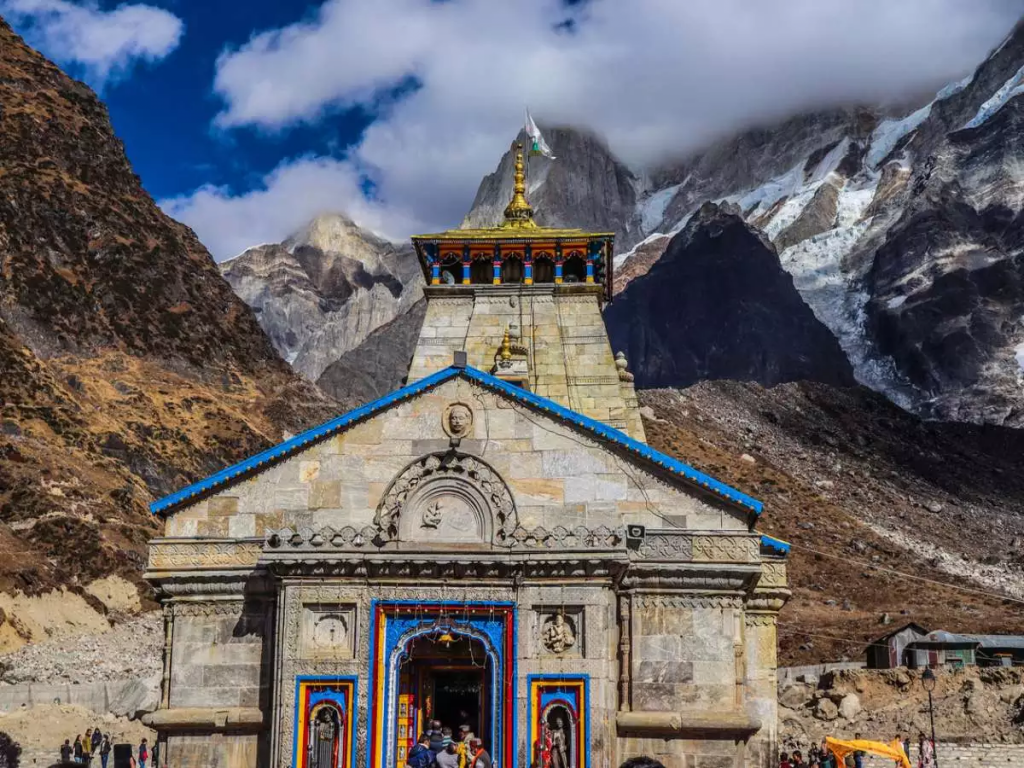
Introduction:
Kedarnath Trek – Nestled amidst the mighty Himalayas lies the sacred destination of Kedarnath, a revered pilgrimage site for Hindus and a trekker’s paradise. The Kedarnath Trek offers not only breathtaking views of nature but also a glimpse into the rich history and spirituality of the region.
History and Mythology: Kedarnath Temple
The history of Kedarnath is intertwined with Hindu mythology. Legend has it that after the great Mahabharata war, the Pandavas sought redemption for their sins of fratricide. Lord Shiva, unwilling to forgive them, took the form of a bull and fled, diving into the ground at Kedarnath. The hump remained visible, thus giving rise to the revered Jyotirlinga of Kedarnath.
The Trekking Experience: Kedarnath Trek
Embarking on the Kedarnath Trek is not just a physical journey but a spiritual odyssey. The trek typically starts from Gaurikund, where devotees take a dip in the hot springs before commencing their journey. The trail winds through picturesque landscapes, lush forests, and challenging terrains, offering a test of endurance and faith.
Attractions of Kedarnath / What to See in Kedarnath
Kedarnath Temple : This ancient Hindu temple dedicated to Lord Shiva is the main attraction of the town. It’s one of the twelve Jyotirlingas and holds immense religious significance for Hindus. The temple’s architecture, nestled amidst the Himalayas, is awe-inspiring. Chorabari (Gandhi Sarovar) : This glacial lake is located around 3 km from Kedarnath and is believed to be the place where Mahatma Gandhi’s ashes were immersed. The trek to Chorabari offers serene views of the surrounding mountains and glaciers. Bhairavnath Temple : Situated around 1 km away from Kedarnath Temple, this temple is dedicated to Bhairava, a fierce manifestation of Lord Shiva. It’s believed that visiting this temple is essential for a complete pilgrimage to Kedarnath. Vasuki Tal : A picturesque lake located at an altitude of around 4,150 meters above sea level, Vasuki Tal is surrounded by breathtaking Himalayan peaks. It’s a popular trekking destination, offering stunning views of the surrounding landscapes. Trijuginarayan Temple : Located around 5 km away from Kedarnath, this temple is believed to be the place where Lord Shiva and Goddess Parvati got married. The eternal flame burning at this temple is said to have witnessed their wedding. Gaurikund : Situated around 16 km from Kedarnath, Gaurikund is a small town known for its hot water springs. It’s also the starting point for the trek to Kedarnath Temple. Rambara : Located en route to Kedarnath Temple, Rambara is a scenic spot surrounded by lush greenery and towering mountains. It’s a popular camping site for trekkers and pilgrims..
Activities in Kedarnath
Spiritual exploration:.
- Visit Kedarnath Temple : Explore the ancient and revered Kedarnath Temple dedicated to Lord Shiva.
- Offer Prayers : Participate in religious rituals and offer prayers at various temples and sacred sites.
- Attend Aarti : Experience the divine atmosphere by attending the evening aarti (ritual of worship) at Kedarnath Temple.
Nature and Adventure:
- Trekking : Embark on treks to scenic spots like Vasuki Tal, Chorabari, and Gaurikund.
- Pilgrimage Trek : Undertake the pilgrimage trek from Gaurikund to Kedarnath Temple.
- Scenic Views : Enjoy panoramic views of the Himalayas and surrounding landscapes.
- Photography : Capture the breathtaking natural beauty of the region through photography.
Cultural Immersion:
- Explore Local Culture : Interact with locals and learn about their customs, traditions, and way of life.
- Visit Trijuginarayan Temple : Explore the historic Trijuginarayan Temple associated with the marriage of Lord Shiva and Goddess Parvati.
- Attend Festivals : If your visit coincides with local festivals, participate in the celebrations to experience the vibrant culture of the region.
Relaxation and Reflection:
- Meditation : Find peace and tranquility amidst the serene surroundings for meditation and introspection.
- Hot Springs : Relax and rejuvenate in the natural hot water springs of Gaurikund.
- Nature Walks : Take leisurely walks amidst the lush greenery and serene atmosphere for relaxation and reflection.
Adventure Sports (Depending on Availability):
- Helicopter Ride : Experience a thrilling helicopter ride offering aerial views of Kedarnath and the surrounding Himalayan peaks.
- Pony Rides : Enjoy pony rides for a unique perspective of the landscape, especially during the trek to Kedarnath Temple.
Wildlife and Nature Observation:
- Bird Watching : Explore the rich avifauna of the region through birdwatching expeditions.
- Flora and Fauna : Observe the diverse flora and fauna of the Himalayan ecosystem.
Environmental Conservation:
- Responsible Tourism : Practice responsible tourism by minimizing your environmental footprint and respecting the local ecosystem.
- Educational Tours : Participate in educational tours or workshops focused on environmental conservation and sustainability.
Inspire Tourist in Kedarnath
🌟 discover divine majesty in kedarnath 🌟.
Welcome to a land where spirituality gracefully intertwines with splendor, where ancient temples majestically stand tall amidst the towering Himalayan peaks, and where every step becomes a profound journey of self-discovery. Welcome to Kedarnath!
Embark on a Spiritual Odyssey :
Embark on a journey deep into the heart of Hindu spirituality as you gracefully visit the sacred Kedarnath Temple, a timeless symbol of devotion and faith. Let the echoes of hymns resonate within you and the soothing scent of incense gently guide you on a soul-stirring pilgrimage.
Embrace Nature’s Magnificence :
Immerse yourself in the breathtaking beauty of the Himalayas as you gracefully trek through pristine forests, marvel at cascading waterfalls, and deeply breathe in the crisp mountain air. From the tranquil shores of Vasuki Tal to the majestic vistas of Chorabari, every moment unfolds as a captivating brushstroke of Mother Nature’s masterpiece.
Experience Cultural Richness :
Immerse yourself deeply in the rich tapestry of Kedarnath’s culture and traditions. Explore the historic temples, witness the age-old rituals, and engage with the warm-hearted locals, whose hospitality knows no bounds. Let every encounter along the way be a joyous celebration of unity amidst diversity.
Renew Your Spirit :
Reconnect deeply with yourself amidst the serene surroundings of Kedarnath. Meditate in the tranquil meadows, soak in the healing waters of Gaurikund, and find solace in the comforting embrace of the mountains. In Kedarnath, every moment graciously extends an invitation to rediscover inner peace and serenity.
Create Unforgettable Memories :
Whether you’re a seeker of adventure or a seeker of the soul, Kedarnath graciously offers experiences that will linger with you forever. Capture the breathtaking sunsets that paint the sky in hues of gold, embark on thrilling treks that courageously test your limits, and forge bonds that beautifully transcend language and borders.
Come, Be Enchanted :
Allow Kedarnath to gracefully weave its magic upon you. Let its timeless allure gently awaken your spirit, ignite your senses, and tenderly leave an indelible imprint on your heart. In every whisper of the wind and every gentle rustle of the leaves, hear the resounding call of the mountains, warmly beckoning you to embark on a journey of a lifetime.
Kedarnath Awaits Your Presence!
SEASONS OF KEDARNATH:-
Kedarnath experiences distinct seasons throughout the year, each offering its own unique charm and opportunities for exploration. Here’s a glimpse into the different seasons of Kedarnath:
Spring (March to May) :
- As spring gracefully unfolds in Kedarnath, a sense of renewal permeates the air as the snow begins to melt, revealing the lush green meadows and vibrant blooming flowers. The weather during this season is pleasantly mild, making it ideal for trekking and engaging in various outdoor activities. Pilgrims can joyfully embark on their sacred journey to Kedarnath Temple amidst the vibrant colors of nature, further enriching their spiritual experience.
Summer (June to August) :
- During the summer months, Kedarnath welcomes visitors with mild temperatures during the day and pleasantly cool nights, creating an ideal atmosphere for exploration. It marks the peak pilgrimage season, with a significant influx of devotees making their way to the revered Kedarnath Temple. Amidst this bustling period, the surrounding Himalayan landscapes reveal their most picturesque vistas, enticing adventurers with abundant opportunities for trekking and sightseeing.
Monsoon (July to September) :
- During the monsoon season, Kedarnath experiences heavy rainfall, often resulting in landslides and disruptions in travel. Despite the challenges posed by the rain, the region’s lush greenery flourishes, imbuing the surroundings with a serene and refreshing atmosphere. Pilgrims are advised to exercise caution and stay updated on weather conditions before planning their visit during the monsoon.
Autumn (October to November) :
- As autumn gracefully unfolds in Kedarnath, it heralds a transitional period characterized by clear skies, pleasant temperatures, and breathtaking views of the surrounding Himalayas. Following the monsoon season, the crowds gradually thin out, offering travelers a more serene and peaceful experience amidst the majestic landscape. This season presents an excellent opportunity for trekking and engaging in various outdoor activities before the arrival of winter.
Winter (December to February) :
- As winter descends upon Kedarnath, it gracefully blankets the landscape in a layer of snow, transforming the region into a pristine winter wonderland. During this season, the Kedarnath Temple remains closed, safeguarded from the heavy snowfall and harsh weather conditions. However, adventurous travelers can still immerse themselves in the beauty of Kedarnath through activities like snow trekking and photography. Nevertheless, such endeavors demand careful planning and thorough preparation to ensure a safe and memorable experience amidst the snowy wilderness.
Each season in Kedarnath offers a unique perspective and presents travelers with diverse experiences, whether it’s the spiritual journey of pilgrimage, the thrill of adventure amidst nature, or the simple joy of witnessing the changing seasons in the lap of the Himalayas.
ENQUIRY NOW
- FEATURES OF KEDARNATH
Sacred Pilgrimage Site:
- Kedarnath is revered as one of the holiest pilgrimage sites in Hinduism, drawing devotees from around the world to pay homage to Lord Shiva.
Historic Temple:
- The ancient Kedarnath Temple, dating back over a thousand years, stands as a testament to architectural brilliance and spiritual devotion.
Breathtaking Location:
- Perched amidst the Garhwal Himalayas, Kedarnath offers awe-inspiring views of snow-capped peaks, verdant valleys, and pristine alpine meadows..
Challenging Trek:
- The journey to Kedarnath involves a challenging trek spanning approximately 16 kilometers, rewarding trekkers with adventure and spiritual fulfillment.
KEDARNATH– VITAL INFORMATIONS
- TEMP –May- June-20℃/Min- 5 ℃
- Best time to visit Chopta.-(May-Jun)/(Sep-Oct)
- Kedarnath Situated in – Ukhimath
- Recommended days in Chopta –4 D & 3N
- Nearest Railways Station from Kedarnath – Rishikesh
- Nearest Airport from Kedarnath- Jolly Grant
- Kedarnath is Famous for – the Shiva Temple, Snow-clad peaks, and Natural Beauty.
CHOPTA TRAVEL GUIDE
- Trekking in Kedarnath
- Camping in Kedarnath
- Kedarnath in Summer
- Kedarnath in Monsooon
- Kedarnath in Winter
- Adventure Activities in Kedarnath
- KedarnathFAQs
KEDARNATH TRAVEL TIPS
Kedarnath map direction tip.
- Before embarking on the journey to Kedarnath, ensure you have a reliable map or GPS navigation system. The trekking route is well-marked but can be challenging in certain sections, so having a map handy can help you stay on track and reach your destination safely.
Kedarnath Trek Tips
- Be prepared for the trek by wearing comfortable trekking shoes, carrying sufficient water and snacks, and dressing in layers to adapt to changing weather conditions. Start early in the day to avoid trekking during the hottest hours, and take regular breaks to rest and acclimatize to the altitude.
Kedarnath Tour Transport Tip
- The nearest major town to Kedarnath is Gaurikund, which is accessible by road from cities like Rishikesh and Haridwar. From Gaurikund, the trek to Kedarnath begins, and pony and palanquin services are available for those who prefer not to trek the entire distance.
Kedarnath ATM’s Tip
- There are limited ATM facilities in Gaurikund, so it’s advisable to carry sufficient cash with you for the duration of your stay and trek. It’s also recommended to inform your bank about your travel plans to ensure seamless transactions if using international cards..
Kedarnath Market Tip
- Gaurikund has a small market where you can purchase essential supplies like snacks, water, trekking gear, and religious offerings. However, the options may be limited, so it’s best to carry any specific items you may need during your trek.
- Best Hotel of Chopta – Hotel Gokuldham
KEDARNATH IMAGES | BEST TIME TO VISIT KEDARNATH | HOW TO REACH KEDARNATH | KEDARNATH ACTIVITIES | KEDARNATH TOURS | KEDARNATH WEATHER
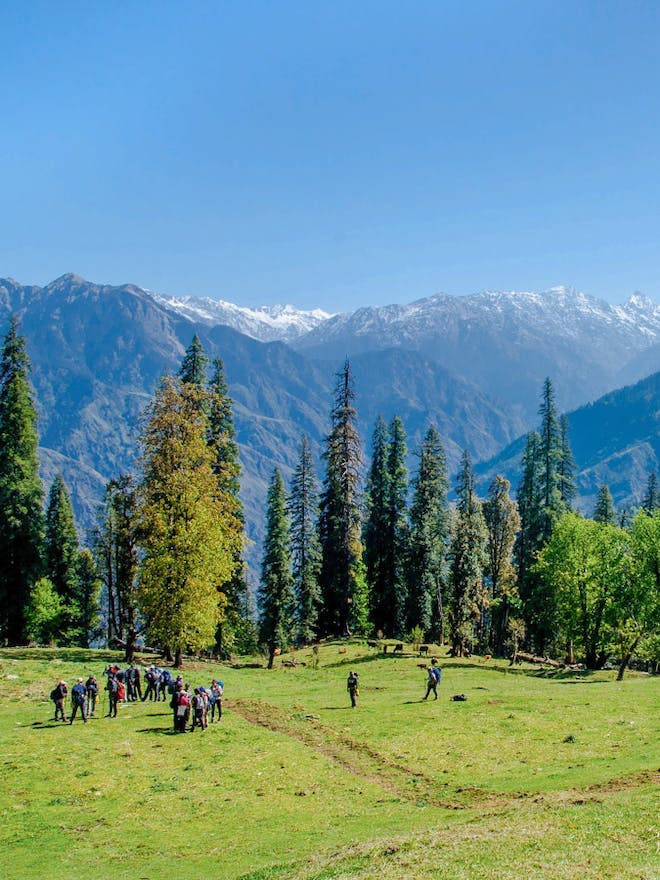
KEDARKANTHA TREK
The finest summit climb for beginners
TREK DIFFICULTY
Easy Moderate
TREK DURATION
HIGHEST ALTITUDE
12,500 feet / 3,810 metres
Kedarkantha (not to be confused with the popular Temple Kedarnath) is a 6-day long trek in Govind Pashu Vihar National Park in Uttarakhand (6 when including the travel days from Dehradun to the base camp and back). Kedarkantha is easily one of the most popular treks in India — popular amongst seasoned trekkers and beginners alike.
There are many reasons why it is a very popular trek to do in the Indian Himalayas. The most important of them is this — the summit climb .
The summit climb of Kedarkantha is a very rewarding one. Right from the base camp of the trek, the summit looms large. As you start your trek in the early hours of the morning and steadily climb up the steep slope of snow, the world opens up around you.
The climb is not easy. The entire stretch is steadily steep. As you get closer to the summit, it gets tricky as well. But the big mountains of the upper Himalayas keep you company until you finally reach the summit.
As you stretch yourself and take in the views of the Himalayas from the summit, you feel a strong sense of satisfaction and accomplishment. This is an unparalleled feeling.
Did you know Indiahikes was the first to explore and document Kedarkantha? Read the untold story here.
Very few treks offer the same adventure, making it popular among beginners for its finest summit climb.
Outside the summit, the trek is also unique for its beautiful clearings . Very rarely you will find stunning clearings on a trek that makes way for some rest spots and beautiful campsites . This trek is filled with clearings on all the different routes. What's more, the clearings are just at the right locations, giving you beautiful vantage points to appreciate the trek and its views.
The third biggest reason this trek is unique is its beautiful forests . All three routes have beautiful diverse forests that will immerse you. If you are not careful, you will get lost in them (in a good way).
Ever since Indiahikes explored and opened up Kedarkantha as a winter trek in 2011, many other organisers have followed suit. Having explored and trekked this route for over a decade, we know every nook and corner on the trail.
Kedarkantha Videos
Recommended Videos Before Going For The Trek

Kedarkantha - Complete Trek Information
We have always wanted trekkers to be well-informed before they go on a Himalayan trek. Knowledge is the difference between a safe trek and a dangerous one. It’s also the difference between a wholesome experience and a superficial experience.
Use this section to learn about the Kedarkantha trek. It has in-depth information about each day of the trek, what to expect, and how you need to prepare for it. Many years of expertise have gone into this content. Trekkers find that extremely useful.

Quick Itinerary
Get your trek plan

How Does Each Day Look
Complete day-wise guide

How Difficult is the Kedarkantha Trek?
This will tell you just how fit you must be

Best Time to do the Kedarkantha Trek
Time your trek well

How to Reach the Base Camp
Plan your travel

Packing List
Things you must take on the trek

Why get fit for Kedarkantha Trek
Fitness matters for the trek

Frequently Asked Questions
Get your questions answered here
Photo Gallery
Winter (Dec-Feb)
Spring & Summer (Mar-Jun)
Latest Photos
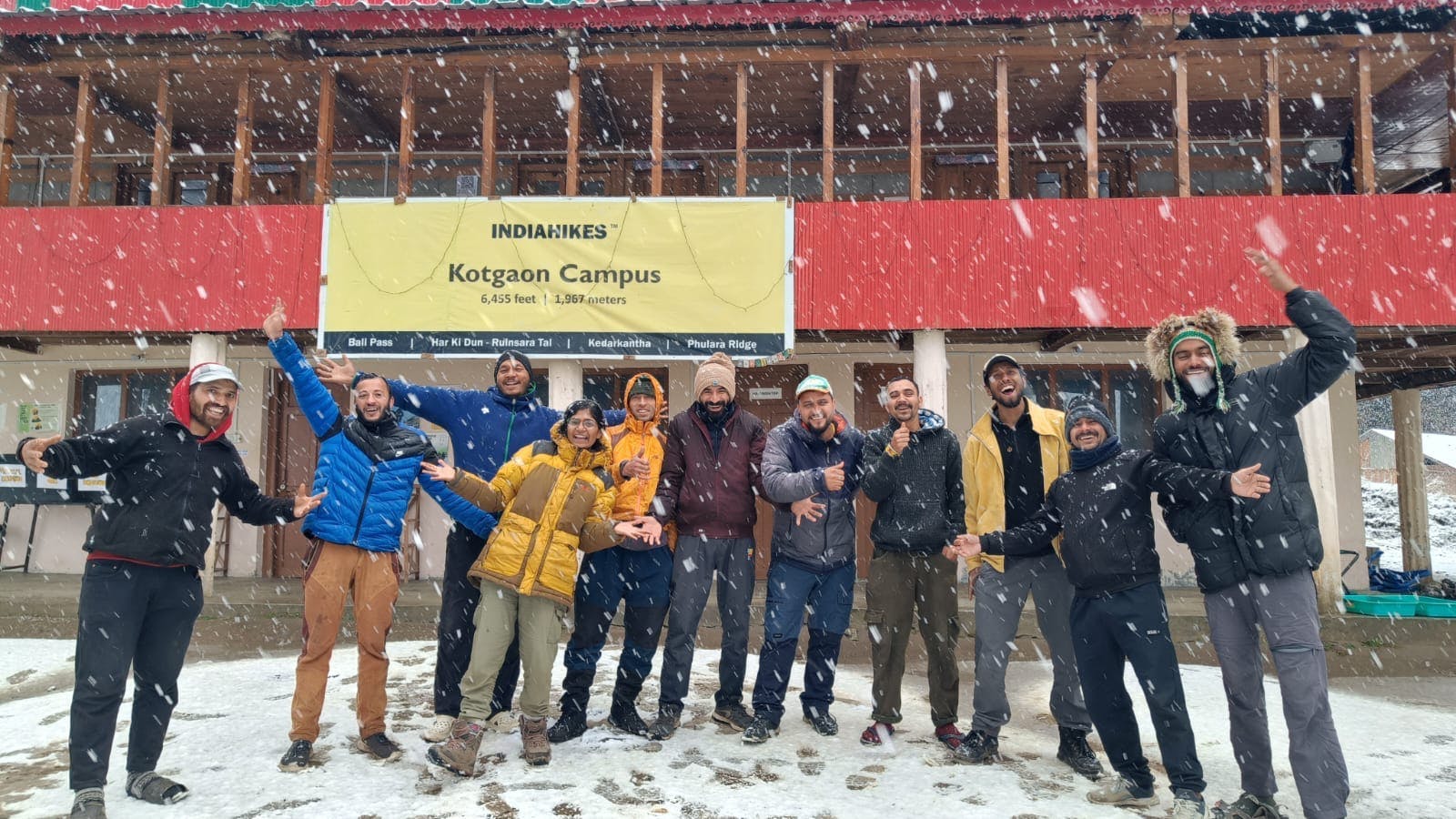
Introducing the
Kedarkantha summer camp.
Adventure & Camping In The Himalayas For 10-14 Year Olds
View details

Expert Speak
Lakshmi Selvakumaran, Head of Experience

Lakshmi Selvakumaran heads the Experience team at Indiahikes. She handles the Learning and Development and Training functions of Indiahikes. She is keen to make Indiahikes the best learning place for everyone. With her team, she is constantly working toward making trekking a more sustainable sport in India. She is a strong advocate of zero waste and a vegan lifestyle.
Here’s Lakshmi talking about one of the top treks in our country.
What I Like and Don’t Like About the Kedarkantha Trek
What I Like About the Kedarkantha Trek
Lakshmi Selvakumaran heads the Experience team at Indiahikes. She handles the Learning and Development and Training functions of Indiahikes. She is keen to make Indiahikes the best learning place for everyone. With her team, she is constantly working toward making trekking a more sustainable sport in India. She is a strong advocate of zero waste and a vegan lifestyle. Here’s Lakshmi talking about one of the top treks in our country.
1 . The Drive to the Base Camp
It is one of the most beautiful drives you will ever have to any trek. The 18 km stretch of the dense pine forest after Purola and the drive through the Mori valley alongside River Tons will stay with you for a long time. Do not miss to watch out for them.

The drive from Purola to Kotgaon snakes through lovely pine forests. It’s worth the long journey! Picture by Sreenath
2 . The culture of Kotgoan
If you are trekking with Indiahikes, you are in for a treat. Very rarely will you get to experience how the local people live? In this trek, you get to see it. You will be spending both your first night and the last night at our campus in Kotgaon.
Although they are close to each other, their houses look different, they dress different and their lifestyle is a little different. You will get to experience this up close.

A temple located in the quaint village of Kotgaon - the base camp of your trek. Picture by Jothiranjan
3 . The Forests
When you are in the forests of Kedarkantha, especially the stretch from Kotgaon to the summit, you will feel this sense of oneness with your surroundings more strongly.
Many factors bring this about:
– The forests in this stretch are the least travelled. Apart from the villagers, only our trekkers take this route. So in a lot of ways, this route has stayed pristine. If you are not careful, you can get easily lost.
Unlike the other forests, where the forest looks almost manicured and arranged, this stretch of the forest has its wilderness intact. You will feel it strongly the moment you enter it.
– The forest is extremely dense and immersive. The sun plays hide and seek and this makes this stretch all the more magical.
– It is also diverse. Along with Deodar, Pine and Oak, you will see more variety of trees and shrubs that you do not see on the other side.
The forest from Kotgaon to the summit is one of my favourite forests that I have ever trekked in. The diversity, contrasting colours, and the density – all give a very surreal feel to this section.
I would be most happy to do this trek again and again just for these forests. However, the other sides of Kedarkantha equally offer some of the most beautiful forests climbs in the Himalayas.
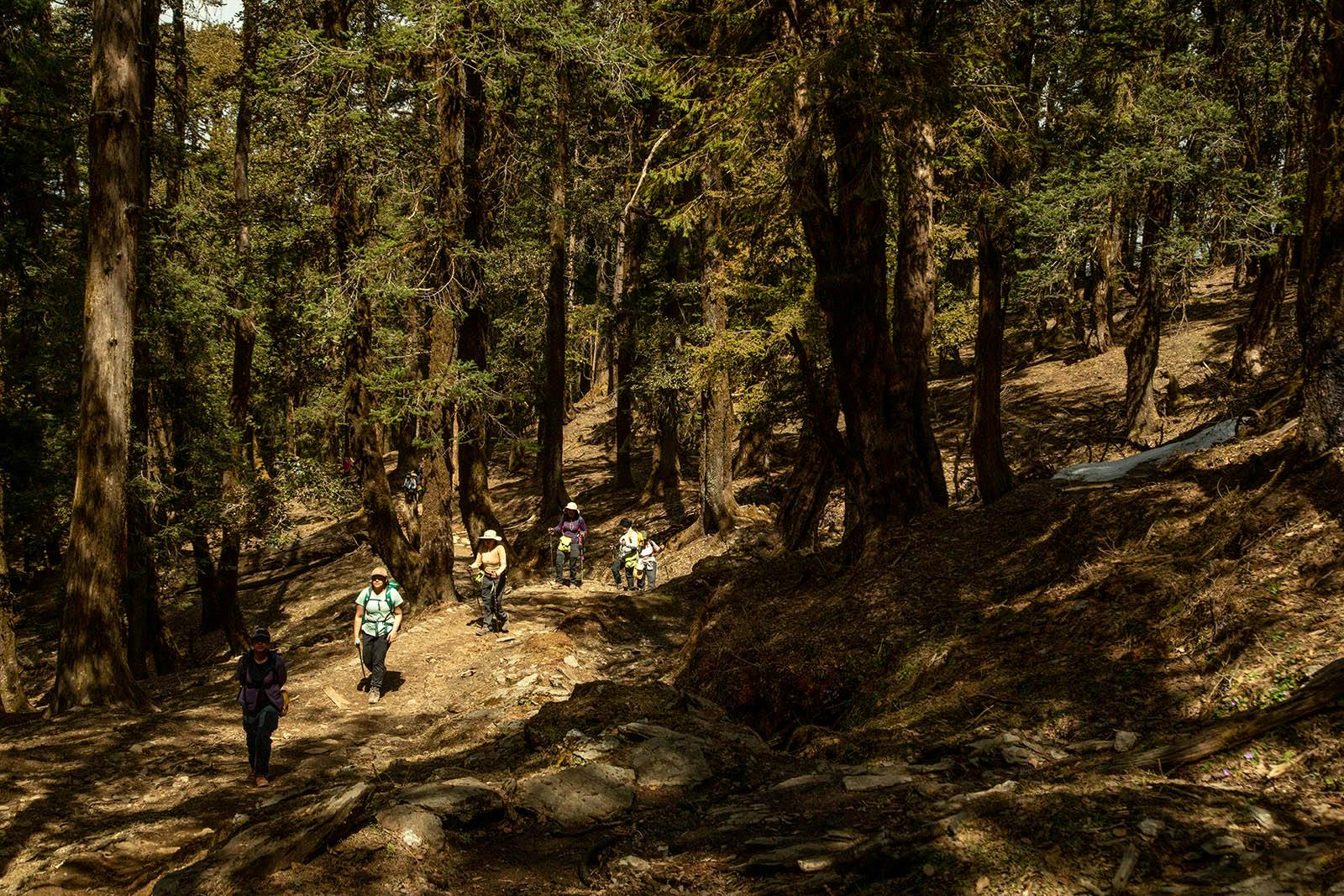
You’ll not see golden Oak forests like the Kedarkantha trek on any other trail. Picture by Jothiranjan
4 . The Clearings
Kedarkantha has many such clearings on all sides. No other trek offers such clearings. I have done almost 11 treks so far and I am yet to find a trek that has such beautiful clearings.
It is one trek in the entire Himalayas, where you have no dearth of campsites. One of the reasons we have been able to open multiple routes in this trek is because of these clearings.
Other factors make these clearings even more special. They are:
– Each of the clearings on this trek is so uniquely different from the other.
– The views you get from each of the clearings are stunning. The sunsets from these clearings are absolutely out of the world.
– The clearings are very well spaced along the route. So, with the forest and the clearings together, each day’s trek feels complete. You will find a clearing every 2 hours of the trek. Such is the number and ideal placement of these clearings.
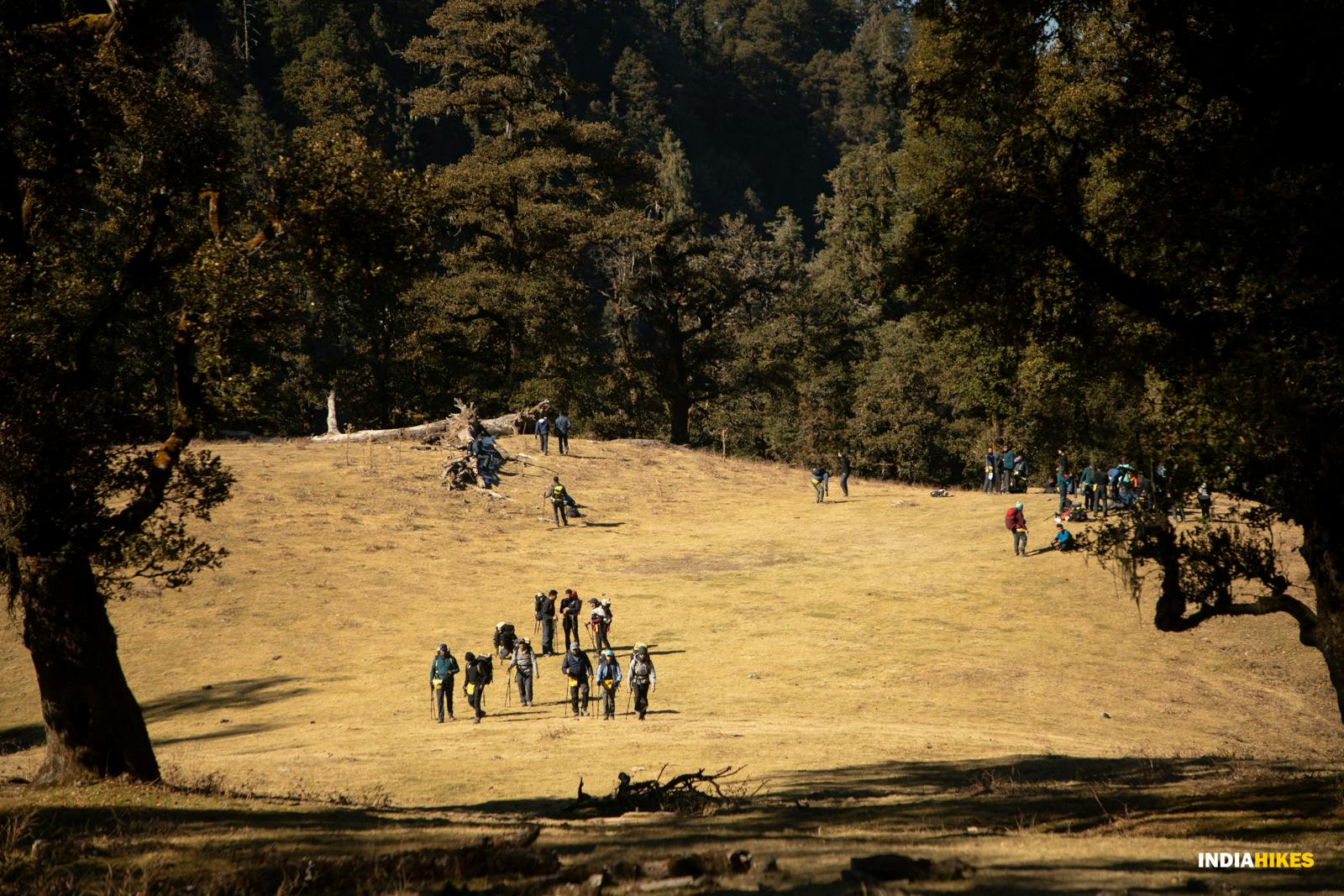
One of the clearings on your way to the Kedarkantha summit. Picture by Jothiranjan
5 . Multiple Routes
Being a standalone mountain, this trek is blessed with multiple routes to reach the summit and all of them are unique and beautiful in their way.
This allows everyone to explore this trek in the way we want to – going with the popular route or choosing the quieter trail, adapting the route depending on the weather, etc. There are plenty of ways to reach the summit.
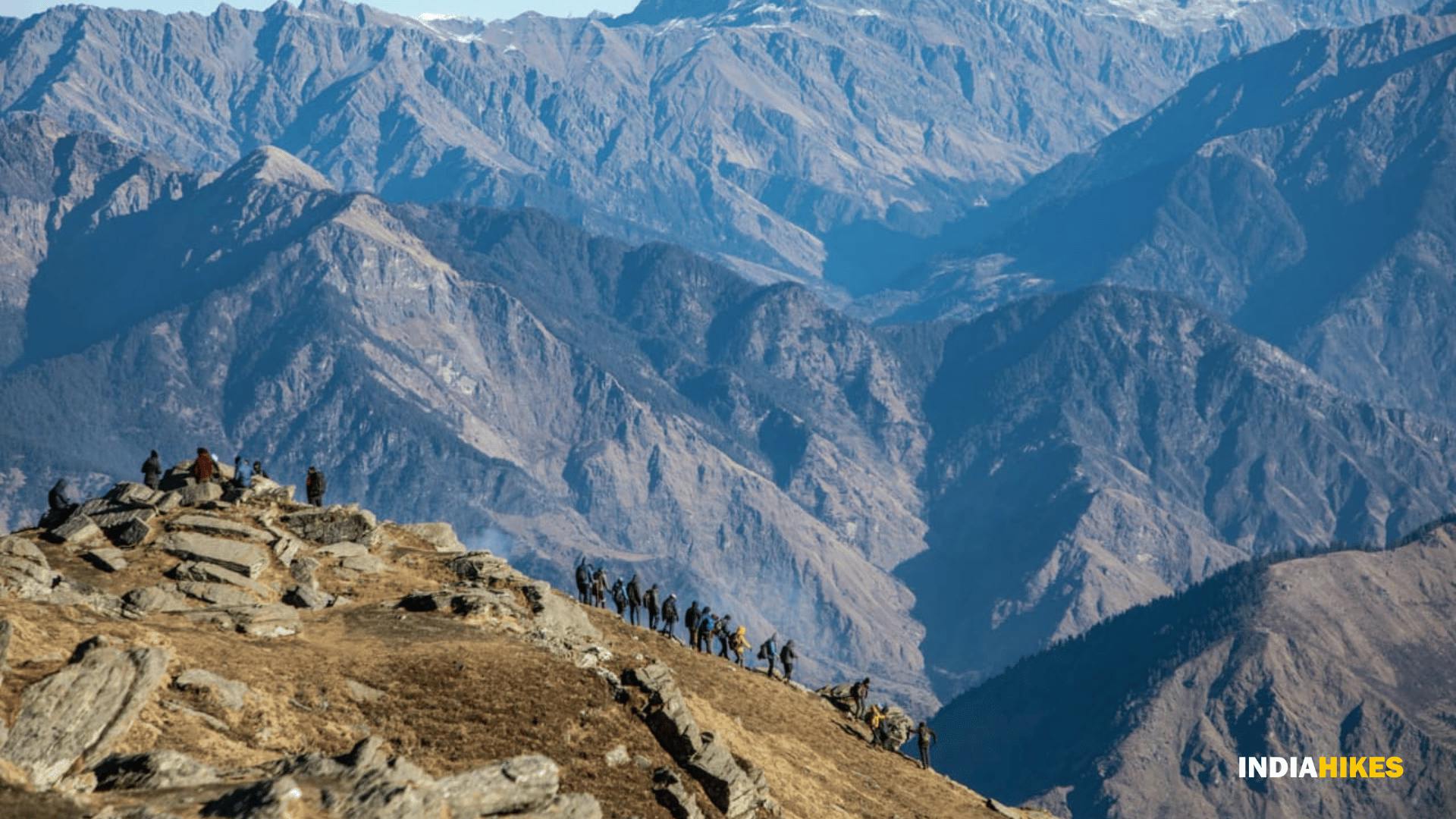
The summit climb to the Kedarkantha is one of the most challenging sections on the trek. Picture from Indiahikes Archives
6 . The Sunsets
This trek offers some of the most dramatic sunsets and it is precisely so because of the placement of the campsites. The campsite Bhoja Dhadi faces the western side of the sky and is wide open to the sky. This makes the sunsets along this trail absolutely must watch on the trek.
The sunsets I have witnessed have stayed with me until now. All I need to do is close my eyes and remember to be transported back there.
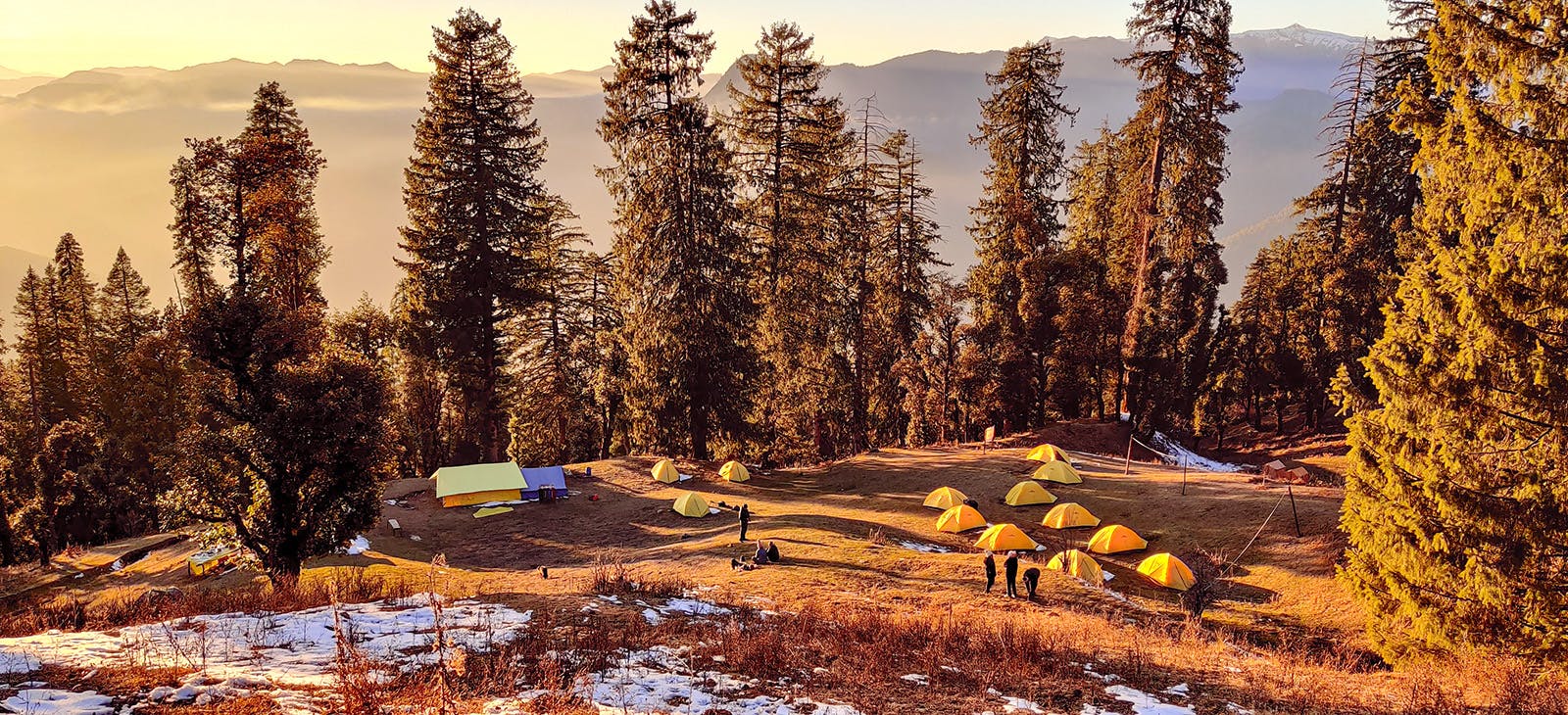
The sunsets on the Kedarkantha trek is an absolute treat to watch. Picture by Vasudev Sharma
7 . The Summit
The trek is famous for its summit and is rightly so. The first is that this is a proper summit marked by a cairn. Of all the 12,500 ft treks in the Himalayas, Kedarkantha is one of the two summit treks. The rest are all mostly passes or high points on a range.
This itself is special. The second is the route to the summit. As soon as you clear the tree line, the summit is right in front of you. So, right from the beginning of the trek, you know where you are trekking to and it creates an instant aspiration. This builds the challenge of the trek right from the beginning of the summit day.
The third is the slope. The summit is a steady climb at almost an inclination of 45 to 60 degrees. In many places, especially in snow, it gets challenging even for experienced trekkers. This again makes the summit climb a rewarding one.
Fourth, is the views that accompany along. Although the views are not the most prominent or the highlights of the trek, the upper Himalayas do accompany the entire way up. This does add a charm to the entire climb giving respite when you take a break.
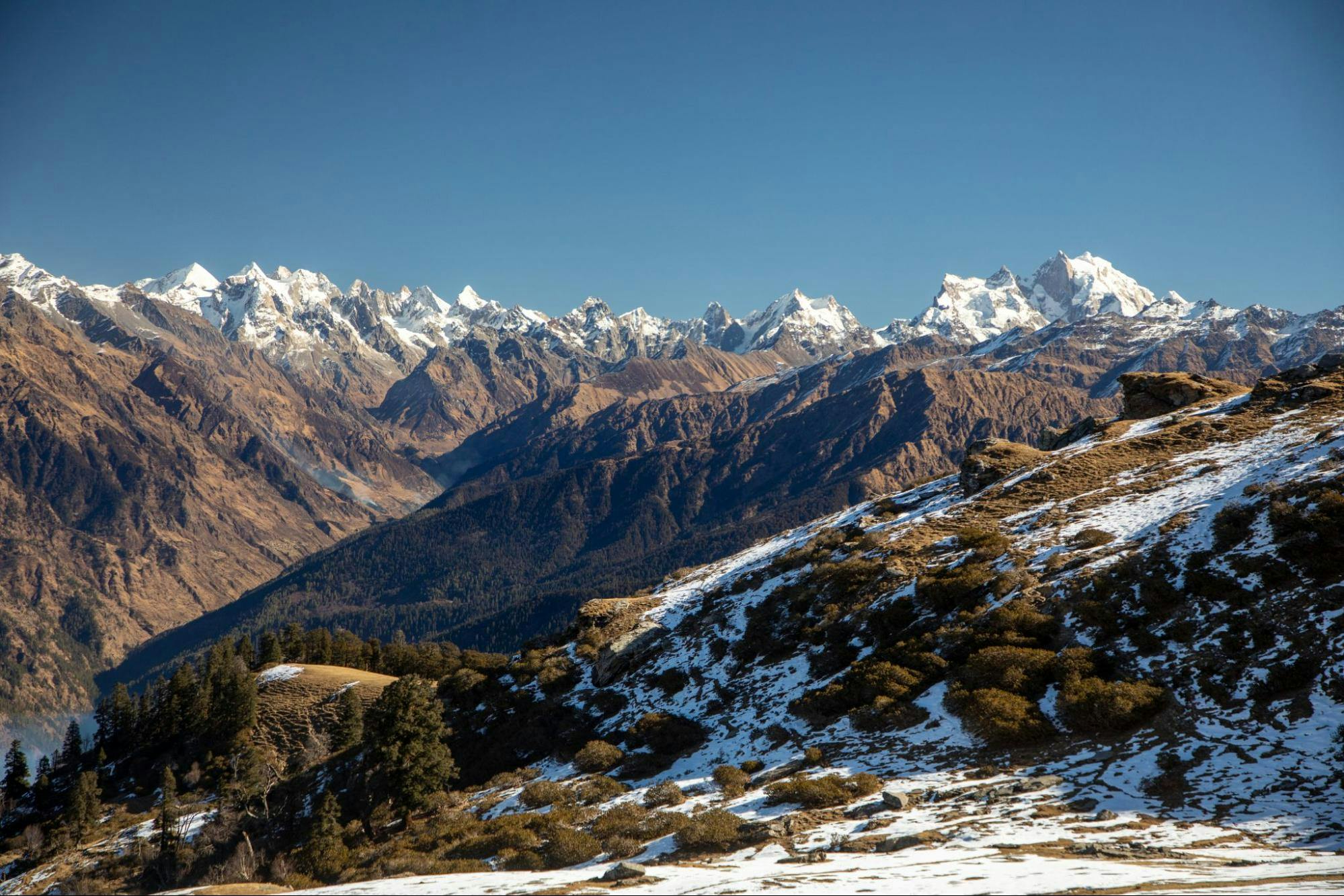
The view from the Kedarkantha summit is extremely rewarding with the Garhwal Himalayas spreading to the horizon. Picture by Jothiranjan
What I Don't Like About the Kedarkantha Trek
1 . The Crowd
I will be very frank here that during the peak winter season, the Sankri route is extremely crowded. As a person looking for peace, I would not want to do the trek during this time. But luckily, we do have the alternative routes that we, at Indiahikes, run precisely to give you the exclusiveness you will want while trekking.
We talk about this route in more detail below but just giving you an idea of what you can expect if you want to take the Sankri route normally.
2 . The Hydro Project
As I mentioned before, the trip to the base camp is one of the most beautiful ones – especially driving by River Tons from Mori till Naitwar. However, this charming route has changed dramatically ever since the Hydroelectric project started along this route. Frankly, I am not a fan of it. Because of the deforestation that this stretch has seen ever since the project started.
So, there you go. Aside from these, there is hardly anything that I will fault with this trek. Precisely why, I believe it is one of the most famous treks in the Indian Himalayas today.
Trek Trivia
Things Nobody Tells You About Kedarkantha
- The Rich Wildlife Sanctuary
- Culture and Religion of the Land
- Treks around Kedarkantha
Did you know that you'll be trekking inside a wildlife sanctuary on the Kedarkantha Trek?
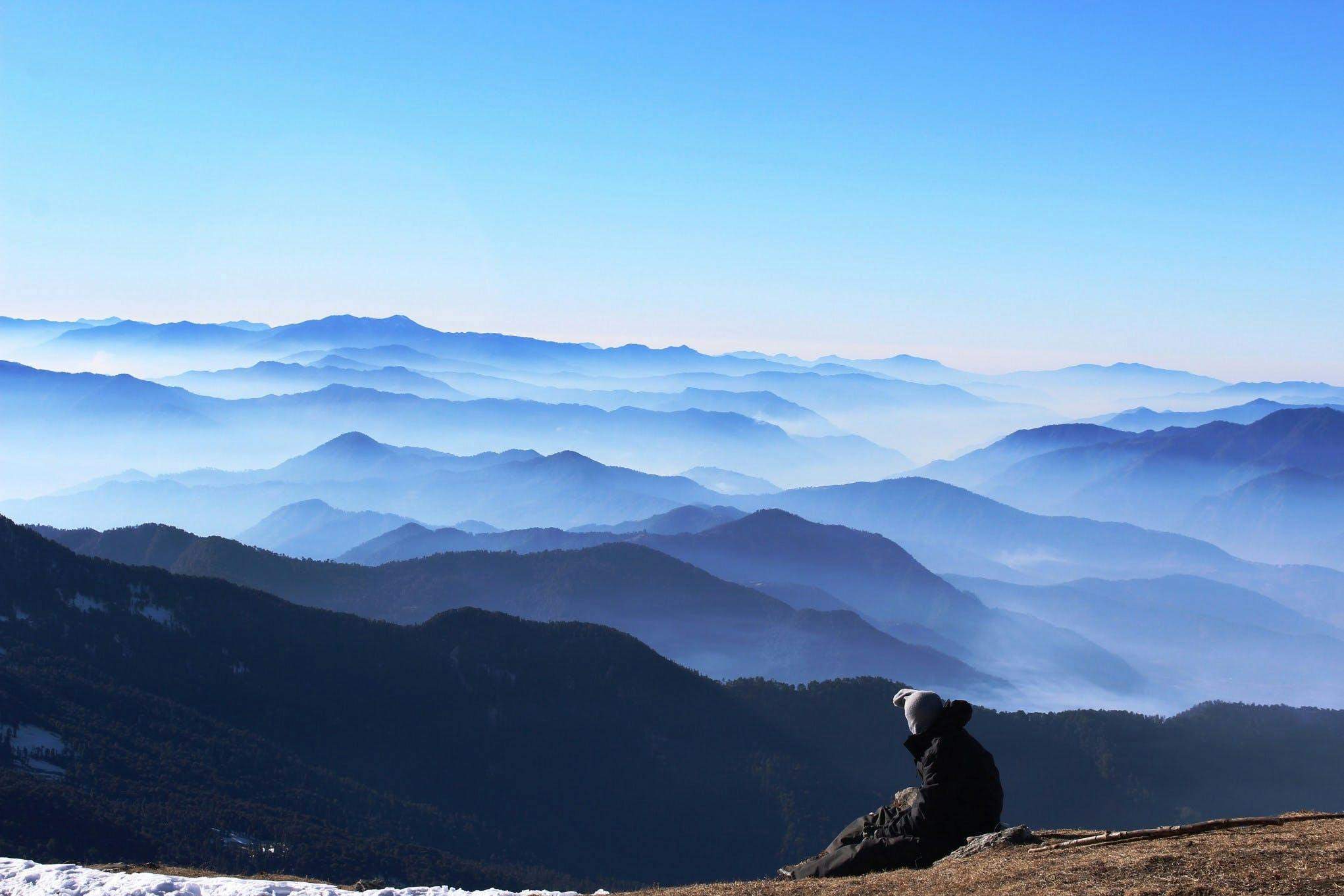
The Kedarkantha trek begins in the majestic Govind Pashu Vihar Sanctuary and National Park. The area is rich and filled with biodiversity. Flora and fauna in the sanctuary are of a Western Himalayan type.
There are three categories of Western Himalayan flora: Broadleaved forests, Subalpine conifer, and Subalpine shrubs and bushes. One of the best things about Kedarkantha is that you get to witness all three kinds.
During the ascent, you'll notice the striking change in flora and fauna. From forests and shrubs to vast meadows, Kedarkantha has it all.
In Kedarkantha, you get breathtaking views of the river Tons and Thamsa. The blue turquoise colour of river Tons can wash away your worries.
Not only this, India's first Snow Leopard project began here. Huge efforts have been made to conserve the Snow Leopards by the Govind Wildlife Sanctuary.
Did you know the religious significance and culture of Kedarkantha?
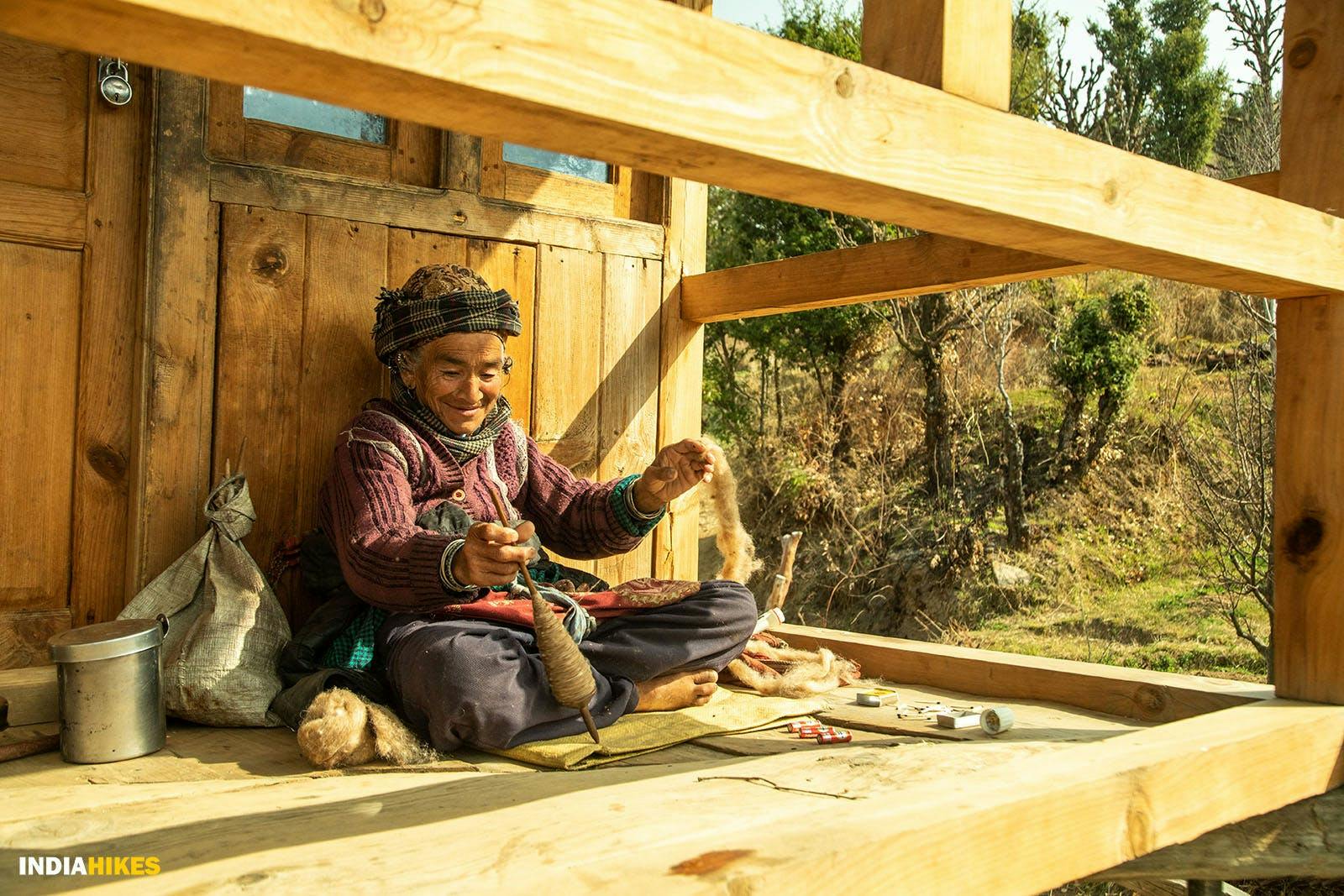
Kedarkantha holds great religious significance among the locals. It is believed that the mighty Lord Shiva came here to hide from a demon and stayed there for a while. The three villages, Sankri, Gaichawan Gaon, and Kotgaon, have a temple dedicated to Lord Shiva.
While 'Kedar' means Lord Shiva, 'Kantha' is translated to be his neck. The locals consider this mountain to be holy and worship Lord Shiva religiously.
Although Kedarkantha is in Uttarakhand, the Kinnaur culture greatly influences the people. They dress up and talk similarly too. Since Kedarkantha is located close to Himachal Pradesh, the culture crosses over and merges with them.
Do you know about these treks around Kedarkantha?
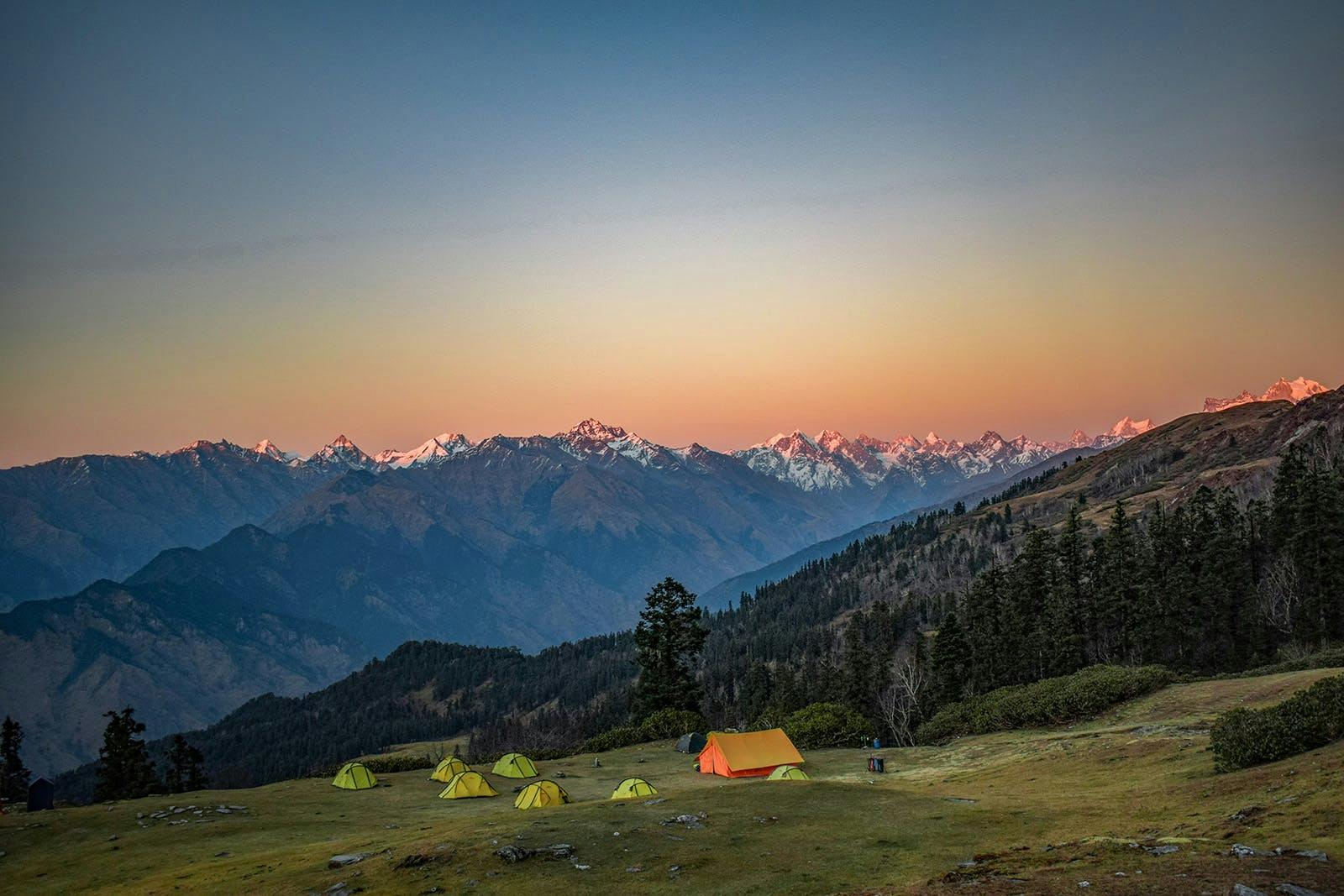
The region of Govind Pashu Vihar National Park is famous for the start of many of the trekking trails of our country.
However, many are not aware of these treks which are surrounding our famous Kedarkantha. Here is a list of those treks:
- Har Ki Dun Ruinsara
- Phulara Ridge
- Maldaru Lake
- Devkyara Valley
- Fachu Khandi
- Borasu Pass
- Baraadsar Lake
- Khimloga Pass
5 Reasons Why Indiahikes
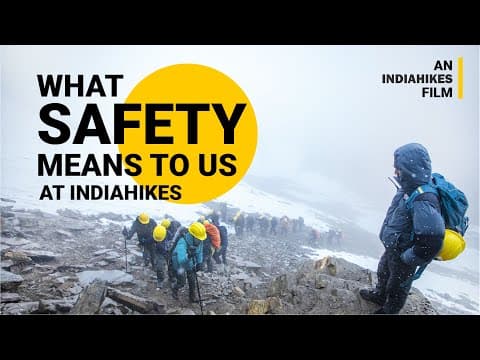
When we brought out new trails in Indian trekking, safety came with us. Back in 2012, we were the first to introduce microspikes, and two years later, pulse oximeters became standard thanks to us. Nobody does safe treks like Indiahikes. In the mountains, emergencies don't care who you're with – everyone knows that when trouble hits, you look for the yellow tents of Indiahikes.

We are pioneers in trekking. Since 2007, we have brought out treks that have become India's most famous treks: Roopkund, Rupin Pass, Buran Ghati, Kedarkantha, Kashmir Great Lakes, Tarsar Marsar, Brahmatal, Phulara Ridge—the list goes on. In 2023 alone, we brought out five new treks in Indian trekking. We know treks better than anyone . This comes directly from the reason why Indiahikes was born: to bring out trek information and enable trekkers to trek on their own.

More than 25,000 people trek with us every year. We are the largest trekking organisation in India. 24% of our trekkers come back to trek with us every year. Over 4,000 students from the top educational institutions trek with us every year. Aside from this, families with children choose to trek with Indiahikes knowing that our treks are the safest. We have taken over 8000 children trekking so far, and the number continues to grow.
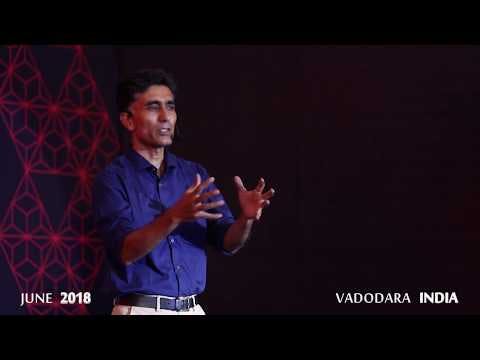
We focus on designing transformative experiences. Our trek leaders conduct thought-provoking exercises that help you reflect and contemplate. This impact stays with you for a long time. Trekkers return feeling energised, more confident, or developing abilities to deal with difficulties. Many have changed careers, rethought their core values, become more humble, shown gratitude to others, or started a new fitness journey.

Since 2012, we have pioneered sustainable practices that have become standard in trekking. Using eco-bags, our trekkers have cleared over 120 tonnes of litter from the mountains. We do not carry packaged foods; instead, we serve freshly made food. We do not light campfires; we carry coal to light angethis to keep you warm. Our bio-toilets not only keep our toilets odour-free but also enrich the soil. When you trek with us, you leave mountains better.
Indiahikes Features
You’re guarded with our trek again philosophy
If you are unable to complete a trek, or if you love a trek, you can repeat it with us anytime. You don’t have to pay us for it. See our thoughts behind this here .
Daily 3-time health checks keep you safe at any altitude
Our thrice-a-day oxi-metre checks keep altitude sickness at bay, never allowing you to reach a point where you need evacuation.
Join any group, they are all women-friendly groups
With around 30% of our trekkers being women, all women, including those travelling solo are comfortable to join any of our groups.
Request Jain/Vegan-friendly food
Our kitchen teams understand your needs as a vegan (or a Jain). We will take special care of your food, even in the remote Himalayas.
Be comfortable and sustainable with bio toilets
We have specially designed bio toilets to ensure you have no sight or smell in toilets, at the same time making sure the toilets cause no harm to the fragile ecosystem we trek in.
Fresh, nutritious food at every camp
We’ll admit it. Our love for food surpasses our love for minimalism. Expect freshly cooked, multi-cuisine food at all camps, designed to meet your nutritional requirements and keep your taste buds happy!
Other Treks Like Kedarkantha
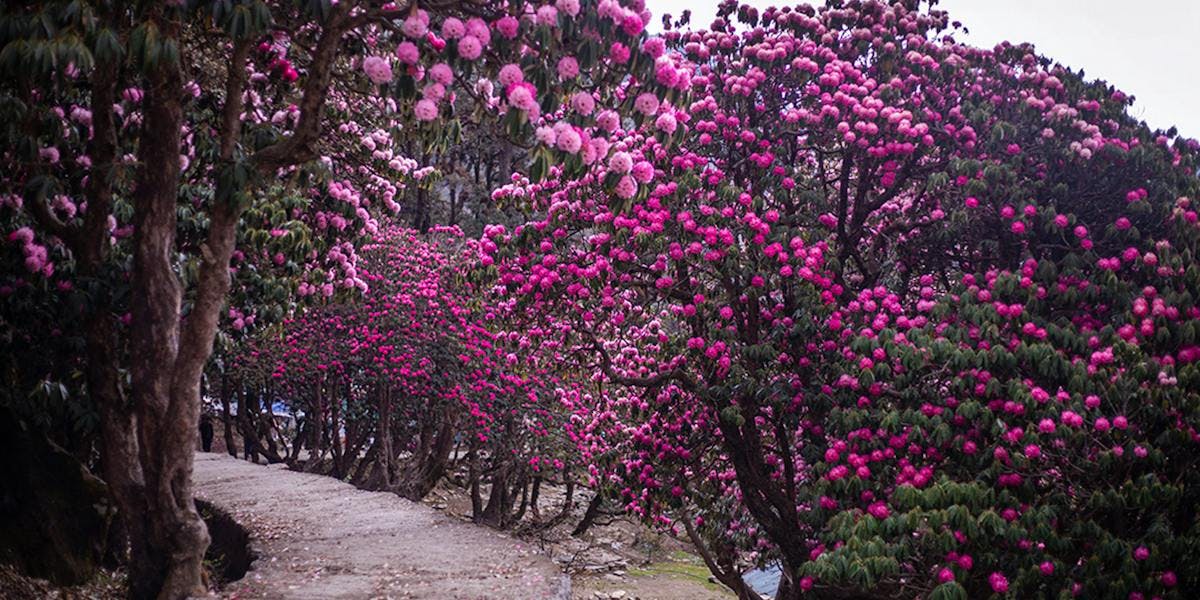
Easy-Moderate
Deoriatal Chandrashila
Get Trek Info
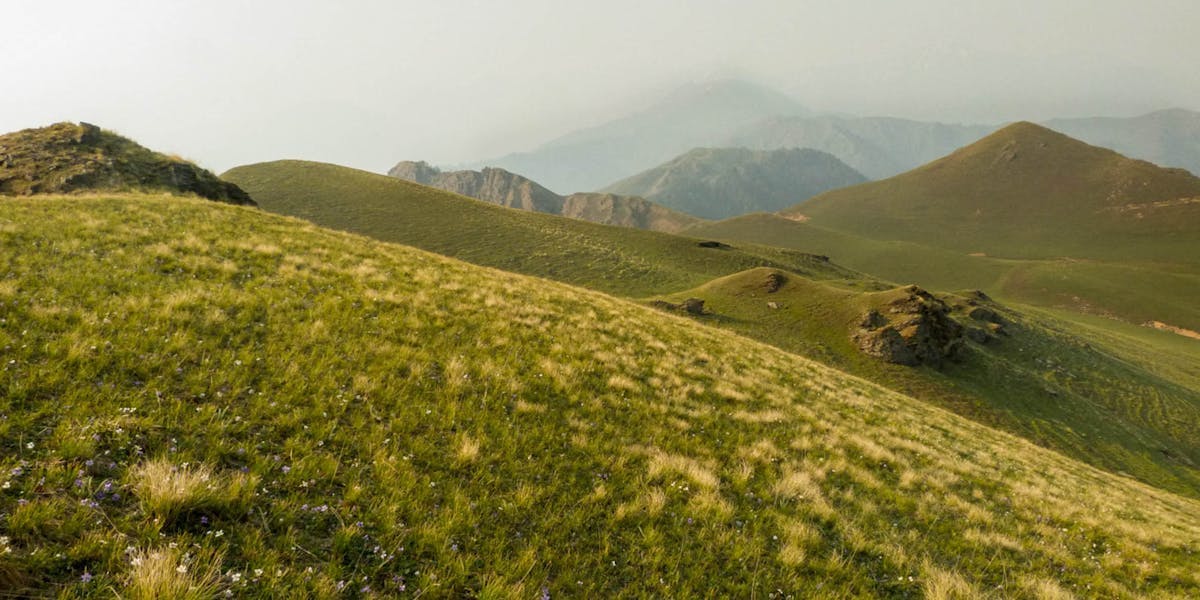
Dayara Bugyal Trek
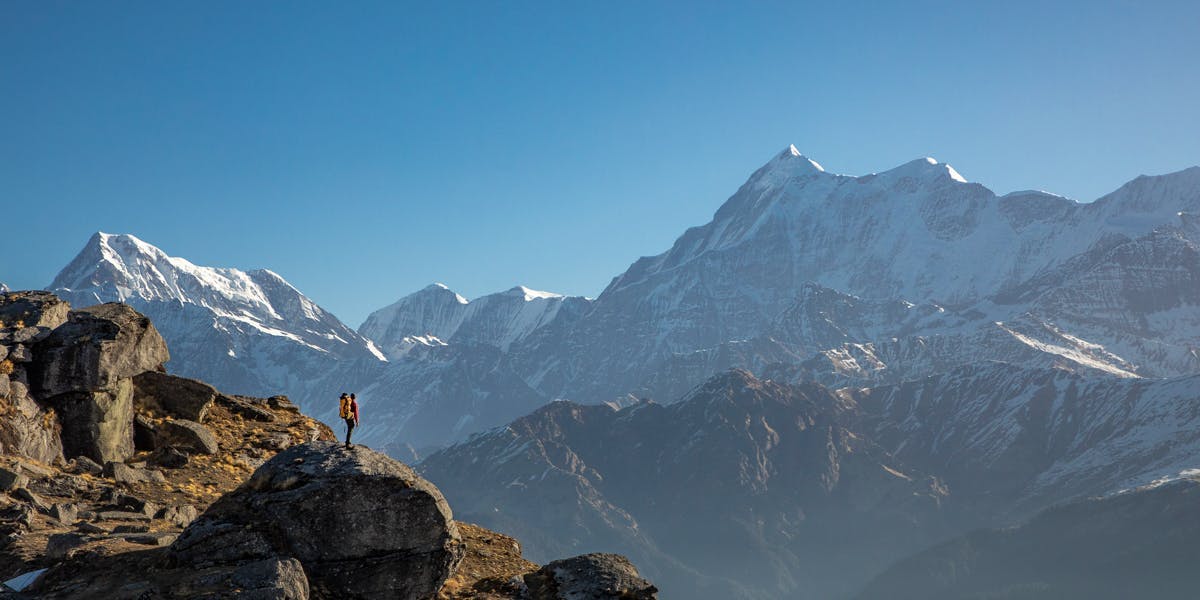
Brahmatal Trek
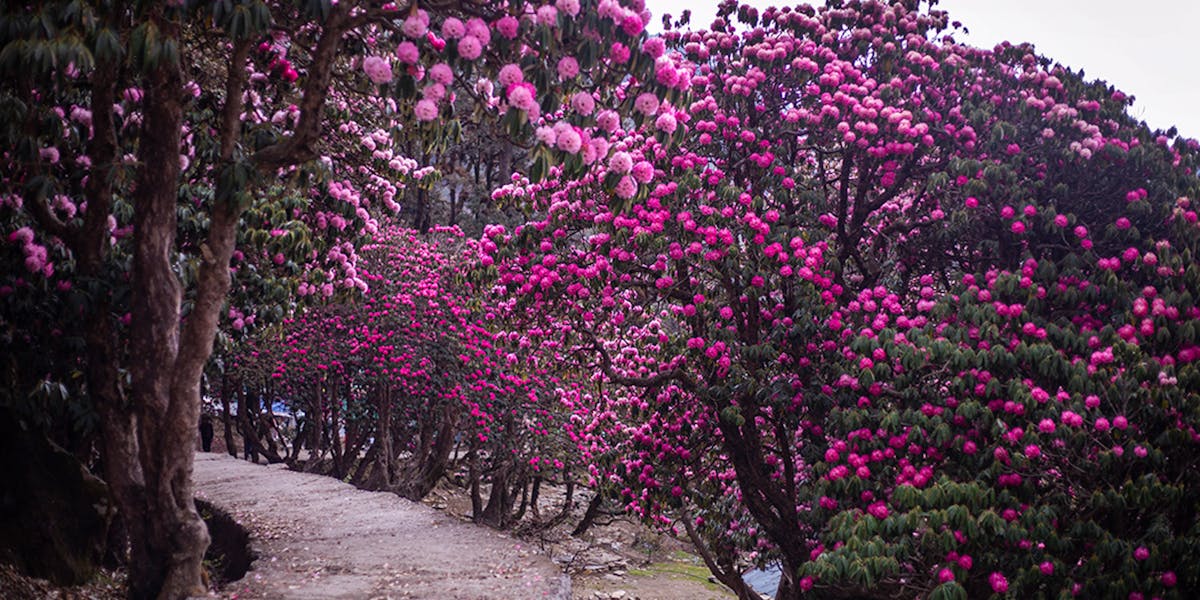
Deoriatal Chandrashi...
A summit climb to one of India's best panoramas

An ideal Himalayan trek for beginners and families

Trek to a high-altitude lake in Mt Trishul's shadow
Sign up for our much loved Weekly Mailer
We have terrific trekking tips, trek updates and trek talks to look forward to
Treks by Categories
Treks by season, treks by month, treks by duration, treks by difficulty.
- Easy - Moderate
- Moderate - Difficult
Treks by Region
- Uttarakhand
- Himachal Pradesh
- Lahaul and Spiti
- Jammu & Kashmir
- West Bengal
- Chhattisgarh
Treks by Experience
- Family Treks
- Stargazing Treks
- Senior Treks
- Adventure Therapy
- Summer Camps
- Youth Camps
- Cancellation policy
- Work with us
- Our sustainability practices
- Privacy Policy
- Terms & Conditions
080 468 01269 Mon to Sat - 9.30 AM to 7.30 PM Sun - 9.30 AM to 6.30 PM
Bengaluru Office
139, Defence Colony Road, Defence Layout, Sahakar Nagar, Bengaluru, Karnataka 560092
Dehradun Office
No.85/10, Neshvilla Road, Dehradun - 248001
© 2024 Indiahikes Private Limited
All images are copyrighted by their respective authors.

IMAGES
VIDEO
COMMENTS
This Kedarnath Yatra 2023 video covers the full Gaurikund to Kedarnath Temple trek. 16kms walk from Gaurikund to Kedarnath Dham is an itegral part of Kedarna...
In our Kedarnath Yatra It was raining heavily we did our Gaurikund to Kedarnath Trek in Sept , This is the third episode of our Kedarnath Dham Trip, Kedarna...
Kedarnath Yatra 2023This is the 3rd episode of Kedarnath yatra (Travel series), we have done 16 km trekking from Gaurikund to Kedarnath temple.Kedarnath Yatr...
Day (13°C to 18° C) Night (0°C to 7°C) Altitude: 3583 m. Trek Weather. Winters are covered with snow summits and peaks whereas summers experience higher temperatures. Best Time: April, May, June, September, October, and post monsoon season, which occurs after and before the temple gates open and close. Trek Level:
The Kedarnath Yatra Trek stands as a revered pilgrimage route, traversing the rugged terrain of the Himalayas to reach the divine destination of Kedarnath Temple.This comprehensive guide delves into every aspect of the journey, providing intricate details to ensure pilgrims embark on a spiritually enriching and safe adventure.
Kedarnath (3,553 metres, approximately) is a Hindu temple dedicated to Lord Shiva located in the Rudraprayag district of Uttarakhand. It lies just below the base of the mighty Kedarnath peak (6,940 metres), and is the First Kedar to be visited in case you are staying true to the sequence of the Panch Kedar circuit.
Day 2: Guptkashi to Sonprayag, then Trek to Kedarnath (27 km drive + 19 km trek) Trek Distance: N/A. Altitude Gain: N/A. The next morning, your journey continues as you depart from Guptakashi and embark on a 27-kilometer drive to Sonprayag, a pivotal starting point for your trek to Kedarnath.
Trek to Kedarnath: The main way to reach the temple is by trekking from Gaurikund. The trekking distance is around 16-18 km, and it usually takes about 6-8 hours to complete. The trek route is well-marked and passes through picturesque landscapes. You can also hire mules or ponies to carry your luggage or to assist you in the trek.
About this Blog: Kedarnath Yatra is one of the most spiritual pilgrimages in India. Kedarnath, the abode of Lord Shiva attracts thousands of devotees within a span of 6 months when the shrine remains open. Kedarnath is a part of the sacred Char Dhams (4 pilgrimages) as well as a part of the Panch Kedars.This blog is about our experience of the Kedarnath Trek done in the month of October.
The distance of the Kedarnath Trek is around 16 km (one way) from Gaurikund to Kedarnath Temple. The trek can be completed in a minimum of 2 days, with a one-night halt at Kedarnath, or it can be completed in a single day by experienced trekkers. The trek from Gaurikund to Kedarnath takes around 6-7 hours to complete, depending on the fitness ...
Kedarnath trek is a remote trek that starts at Gaurikund, which is the base camp of the trek. It is a moderate-level trek and can be embarked on by even novice trekkers without any prior experience. The Kedarnath trek distance is 16 km and you will need to trek for 5 to 6 hours to reach the Kedarnath base camp at an altitude of 3583 m.
My Instagram ID : http://www.instagram.com/sjvlogsssAdd me on Facebook : https://www.facebook.com/sjvlogsssPlease follow for more updates.Email : sjvlogsteam...
The Kedarnath Trek is a moderate to difficult 18-kilometer trek that necessitates a reasonable level of physical fitness. Ideally, you should be starting the trek at around 4:30 a.m. so you can finish it by 2pm. Since Kedarnath is located within the Kedarnath Wildlife Sanctuary, visitors are not authorised to visit at any time. ...
Located in the Rudraprayag district, Kedarnath is the most remote of all Chota Char Dham sites. Situated near the Chorabari Glacier - the source of the Mandakini river, Kedarnath is flanked by snow-capped peaks - most prominently the Kedarnath mountain (6,940 mts) and the Kedar Dome (6,831 mts). Located at a distance of 223 KM from ...
The Kedarnath Trek is a 18km medium to steep trek which requires a good level of physical fitness. Before going for the trek every pilgrim has to get themselves checked that whether they are capable of trekking or not. Timings of Kedarnath Trek from Gaurikund commences from 04:00AM in the morning till 01:30PM.
January 18, 2024. 2. 1981. ' Kedarnath Temple - One of the 12th jyotirlinga ', is located 3584 metres above sea level, where the River Mandakini follows. The famous Jyotirlinga, Kedarnath Temple, is of Lord Shiva, where he manifests himself as a blazing column of light. The Kedarnath Trek distance is about 16 km and starts from Gaurikund.
The Kedarnath trek from Gaurikund starts at 4 am early in the morning and goes on till 1:30 pm in the afternoon and these timings are fixed since Kedarnath Dham is located inside the Kedarnath wildlife sanctuary and this is the reason why pilgrims are not allowed to trek any time after this. After the said time no pilgrims are allowed to leave.
How to Reach Gaurikund to Kedarnath is one of the must know information for all the devotees who is visiting kedarnath dham this season.Gourikund To Kedarnat...
The Kedarnath Trek offers not only breathtaking views of nature but also a glimpse into the rich history and spirituality of the region. History and Mythology: Kedarnath Temple. The history of Kedarnath is intertwined with Hindu mythology. Legend has it that after the great Mahabharata war, the Pandavas sought redemption for their sins of ...
The Kedarnath trek located within the Kedarnath Wildlife Sanctuary, a 16-km route from Gaurikund to Kedarnath temple, is the most popular here. The trail meanders through forest-covered mountains, glaciers and is criss-crossed by numerous waterfalls. It is a medium to steep trek. There are fixed timings for the trek; 4 am to 1.30 pm, to ...
Book the Kedarkantha Trek with us: https://indiahikes.com/kedarkantha-trekCheck our Upcoming Treks for 2024: https://indiahikes.com/upcoming-treksKedarkantha...
Kedarkantha (not to be confused with the popular Temple Kedarnath) is a 6-day long trek in Govind Pashu Vihar National Park in Uttarakhand (6 when including the travel days from Dehradun to the base camp and back). Kedarkantha is easily one of the most popular treks in India — popular amongst seasoned trekkers and beginners alike.
208 likes, 2 comments - trekonindia on March 14, 2023: "Dm for kedarnath yatra. Video By: @beinghiker #kedarnath #kedarnathtemple #kedarbaba #kedarnathdham #trekonindia #kedarnathtrek".
The Kedarkantha trek is a popular winter trekking destination located in the Uttarkashi district of Uttarakhand, India. This YouTube video captures the mesme...